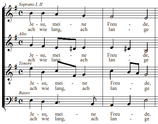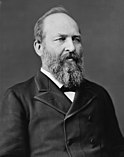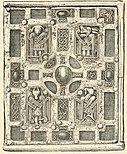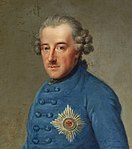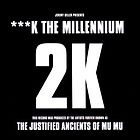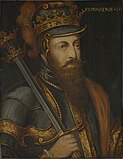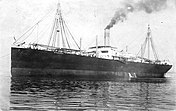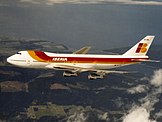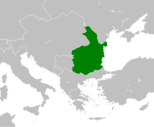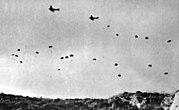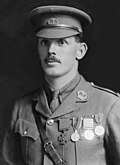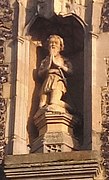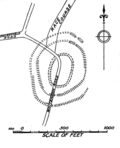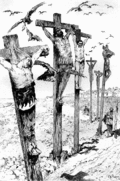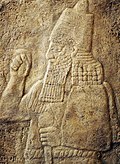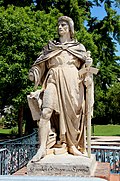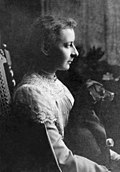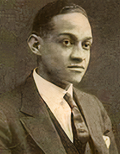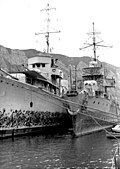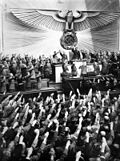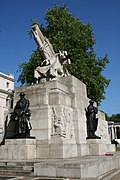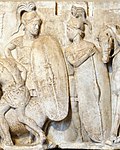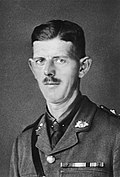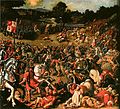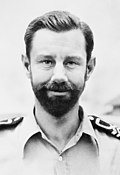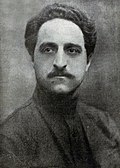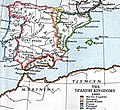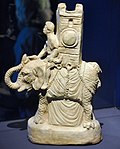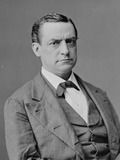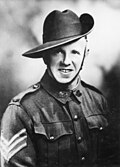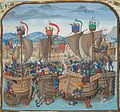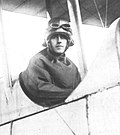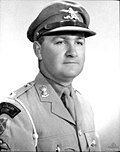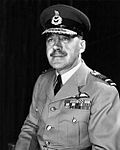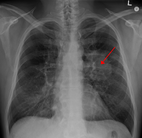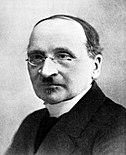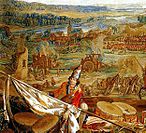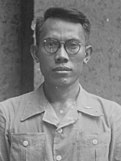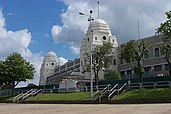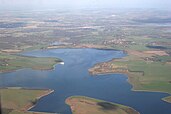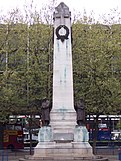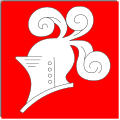User:Gog the Mild/Blurbs/Archive 1
| This is an archive of past discussions with User:Gog the Mild/Blurbs. Do not edit the contents of this page. If you wish to start a new discussion or revive an old one, please do so on the current main page. |
| Archive 1 | Archive 2 |
Posted
Legend Entertainment
![]()

Legend Entertainment Company was an American developer and publisher of computer games, best known for creating adventure titles throughout the 1990s. The company was founded by Bob Bates and Mike Verdu. Legend also negotiated licenses to popular book series as well as earning a reputation for comedic adventures. Industry changes led to increased competition by the mid-1990s and expenses for graphics rose without a similar increase in sales. As a result Legend outsourced marketing and distribution and focused on development. While the studio's adventure titles suffered, working with game publishers allowed it to experiment with more action-oriented titles. Legend fully pivoted to first-person shooters thanks to a relationship with Unreal developer Tim Sweeney and an acquisition by publisher GT Interactive. Sales continued to dwindle, followed by the commercial failure of Unreal II: The Awakening in 2003. The studio was shut down in January 2004, with staff moving to other game companies. (Full article...)
1,019 characters, including spaces.
Croatian Spring

The Croatian Spring was a political conflict which took place between 1967 and 1971 in the Socialist Republic of Croatia, at the time one of six republics comprising Yugoslavia and ruled by the League of Communists of Croatia (SKH). It was marked by a series of economic reforms, with reformers within the SKH aligning with the Croatian cultural society Matica hrvatska and coming into conflict with conservatives. A variety of grievances were aired, including demands for increased autonomy, opposition to real or perceived overrepresentation of Serbs in Croatia and whether the Croatian language was distinct from Serbo-Croatian. The Croatian Spring also increased the popularity of expressions of Croatian culture. Plans were made to amend the constitution. The Yugoslav leadership intervened, compelling the SKH leadership to resign. Nevertheless, most demands were later adopted, ushering in a form of federalism which contributed to the subsequent breakup of Yugoslavia. (Full article...)
994 characters, including spaces.
Ham House
Ham House is set in formal gardens on the bank of the River Thames in Ham, London. The original house was completed by 1610 by Thomas Vavasour, an Elizabethan courtier. Built of red brick, it had a traditional Elizabethan era H-plan. The house was later home to John Maitland, Duke of Lauderdale, and his wife Elizabeth when they held important roles at the court of Charles II. They had the house doubled in size and equipped with princely private apartments, and accommodation suites for visitors. It was furnished to the highest standards and lavishly decorated. The gardens and grounds were redesigned. After Elizabeth's death, the property was passed down within the family until it was donated it to the National Trust in 1948. The house and gardens were then opened to the public. Ham retains many original Jacobean and Caroline features and furnishings, in unusually fine condition. The house is a grade I listed building and its park and gardens are listed at grade II*. (Full article...)
998 characters, including spaces.
The Trundle
The Trundle is an Iron Age hillfort on St Roche's Hill, north of Chichester, England. It is built on the site of a causewayed enclosure, a form of early Neolithic earthwork. Causewayed enclosures were built in England from shortly before 3700 BC until about 3300 BC; their purpose is not known. A chapel dedicated to St Roche was built on the hill around the end of the 14th century; it was in ruins by 1570. The hillfort is still a substantial earthwork (pictured), but the Neolithic site was unknown until 1925. Causewayed enclosures were new to archaeology at the time and aerial photographs persuaded archaeologist E. Cecil Curwen to excavate the site in 1928 and 1930. These digs established a construction date of about 500 BC to 100 BC for the hillfort, and proved the existence of the Neolithic site. In 2011 the Gathering Time project used radiocarbon dating to conclude that the Neolithic part of the site was probably constructed no earlier than the mid-fourth millennium BC. (Full article...)
1,004 characters, including spaces.
Schichau-class torpedo boat
The Schichau class consisted of 22 torpedo boats built for the Austro-Hungarian Navy between 1885 and 1891. Initially powered by steam and armed with two 37 mm (1.5 in) Hotchkiss guns and two 356 mm (14 in) torpedo tubes, they all received two Yarrow boilers and a second funnel between 1900 and 1910. Ten were converted into minesweepers between 1911 and 1913. One boat was discarded in 1911 and the rest saw active service as part of local defence forces for Adriatic naval bases during World War I. The nine torpedo boats which survived were also converted to minesweepers in 1917, although five still carried torpedoes. After the war, sixteen of the boats were allocated to Italy and four to the Royal Yugoslav Navy. All of the boats had been discarded by 1929 except for one Yugoslav vessel. Captured during the 1941 Axis invasion of Yugoslavia it served with the Italians and then the Germans and was lost sometime after September 1943. (This article is part of a featured topic: Ships of the Royal Yugoslav Navy.)
1,020 characters, including spaces.
Hoodoo Mountain
Hoodoo Mountain is a potentially active stratovolcano in the Northern Interior of British Columbia, Canada. Its flat-topped summit is covered by an ice cap more than 100 metres (330 feet) thick and at least 3 kilometres (1.9 miles) in diameter and has an elevation of 1,850 metres (6,070 feet). The primary rock types comprising the volcano are phonolite and trachyte, which were deposited during six periods of eruptive activity beginning about 85,000 years ago. There was at least one period of explosive activity. The latest eruptive period began about 10,000 years ago. A lava flow covering the southwestern slope may have been produced within the last two-hundred years. There have been periods of seismic activity since at least the mid-1980s, indicating possible future eruptions. Two valley glaciers on the sides of the mountain have retreated significantly over the last hundred years. The closest communities are more than 30 kilometres (19 miles) away. (Full article...)
981 characters, including spaces.
Nodar Kumaritashvili
![]()
Nodar Kumaritashvili (25 November 1988 – 12 February 2010) was a Georgian luge athlete who suffered a fatal crash during a training run for the 2010 Winter Olympics competition in Whistler, British Columbia, Canada, on the day of the opening ceremony. He became the fourth athlete to die during preparations for a Winter Olympics, and the seventh athlete to die in either a Summer or Winter Olympic Games. Kumaritashvili, who first began to participate in luge when he was 13, came from a family of seasoned lugers: his grandfather had introduced the sport to the Soviet republic of Georgia, and both his father and uncle had competed when they were younger, with his uncle later serving as the head of the Georgian Luge Federation. Kumaritashvili himself began competing in the 2008–09 Luge World Cup. He had also been a student at the Georgian Technical University, where he earned an economics degree in 2009. (Full article...)
931 characters, including spaces.
2015 Africa Cup of Nations Final
![]()

The 2015 Africa Cup of Nations Final was a football match that took place on 8 February 2015 to determine the winner of the football championship of Africa. The match was held at the Estadio de Bata in Bata, Equatorial Guinea, and was contested by Ghana and Ivory Coast. The final was 0–0 at the end of normal time, and there were also no goals in extra time, with few clear-cut chances for either team. With the match finishing level, it was decided by a penalty shoot-out. After every outfield player had taken a shot the score was tied at 8–8 and the match was decided by Ivorian goalkeeper Boubacar Barry. He saved an attempt from his Ghana counterpart Brimah Razak and then scored himself past Razak to give Ivory Coast a 9–8 shoot-out win and the title. The victory was Ivory Coast's second Africa Cup of Nations victory and lifted them from 3rd place to 2nd place among African nations in the FIFA World Rankings. Ghana's Afriyie Acquah was named man of the match. (Full article...)
989 characters, including spaces.
Julian of Norwich
![]()
Julian of Norwich (1343 – after 1416) was an English anchoress from Norwich. Her writings, Revelations of Divine Love, are the earliest surviving English language works known to have been written by a woman and the only surviving English language works by an anchoress. In 1373, believing she was on her deathbed, Julian received a series of visions of the Passion of Christ. She recovered and wrote two accounts: one shortly after her recovery and a longer version, the Long Text, written many years later. Julian lived in permanent seclusion as an anchoress in her cell, attached to St Julian's Church, Norwich. Writing anonymously, she was influential in her lifetime. The Long Text was first published in 1670 and reissued in 1843. Julian's writings emerged from obscurity in 1901 when a manuscript in the British Museum was transcribed and published with notes by Grace Warrack. Julian is today considered to be an important Christian mystic and theologian. (Full article...)
980 characters, including spaces.
Old Exe Bridge
![]()
The Old Exe Bridge is a ruined medieval bridge in Exeter, England. Built from 1190 and completed by 1214, it is the oldest surviving bridge of its size in England and the oldest bridge in Britain with a chapel on it. The project was the idea of Nicholas and Walter Gervase, father and son and influential local merchants. The bridge was at least 590 feet (180 metres) long and probably had 17 or 18 arches, carrying the road across the flood plain of the River Exe. St Edmund's Church, the bridge chapel, was built into the bridge at the time of its construction. Later all but the central section carried buildings. The bridge collapsed and had to be partially rebuilt several times but remained in use for almost 600 years, until a replacement was built in 1778 and the arches across the river were demolished. In 1969 eight and a half arches of the medieval bridge were uncovered and restored. The bridge's remains are a scheduled monument and a grade II listed building. (Full article...)
992 characters, including spaces.
Jesu, meine Freude, BWV 227
![]()
Jesu, meine Freude (Jesus, my joy), BWV 227, is a motet by Johann Sebastian Bach. The longest and most musically complex of his motets, it is in eleven movements for up to five voices. It is named after the 1653 Lutheran hymn "Jesu, meine Freude" by Johann Franck in six stanzas which form the motet's odd-numbered movements, with the hymn tune by Johann Crüger appearing in different styles of chorale setting (beginning pictured). The text of even-numbered movements is from the Epistle to the Romans. The hymn focuses on an emotional bond to Jesus. Jesu, meine Freude is one of the few works by Bach for five vocal parts, in a structure of symmetries on different layers. It is unclear when the motet was written. It is believed that Bach may have compiled it for the education of his choir in both composition techniques and theology; an earlier theory that it was written for a funeral in Leipzig in 1723 is now discredited. It was the first of his motets to be recorded, in 1927. (Full article...)
995 characters, including spaces.
David Berman (musician)
![]()
David Berman was an American musician, singer and poet. In 1989, with Stephen Malkmus and Bob Nastanovich, he founded the indie rock band Silver Jews, and was its only constant member until its dissolution in 2009. He provided the Silver Jews' characteristic abstract, autobiographical lyrics. Despite believing his work was unappreciated, Berman cultivated a passionate following and became an influential figure in indie rock. Actual Air, Berman's only published volume of poetry, appeared in 1999. By that time, he was struggling with substance abuse, depression and anxiety; he attempted suicide in 2003. Afterward, he underwent rehabilitation, engaged with Judaism, and—alongside his wife, Cassie Berman—toured for the first time. In 2009, he announced his withdrawal from music; returning in 2019 he adopted the band name Purple Mountains. He released an eponymous debut album that July and planned a tour to pay off a $100,000 credit card debt. He died by suicide in August 2019. (Full article...)
1,004 characters, including spaces.
SS Choctaw
![]()
SS Choctaw was a steel-hulled American freighter in service between 1892 and 1915 on the Great Lakes of North America. She was a so-called monitor vessel, containing elements of traditional lake freighters and the whaleback ships designed by Alexander McDougall. Choctaw was built in 1892 by the Cleveland Shipbuilding Company in Cleveland, Ohio. On her regular route between Detroit, Escanaba, Marquette (all in Michigan), and Cleveland, she carried iron ore downbound, and coal upbound. In foggy conditions on July 11, 1915, Choctaw was upbound for Marquette on Lake Huron when she was rammed east of Presque Isle Light by the downbound Canadian canaller Wahcondah. Although Choctaw sank in only 17 minutes, her crew of 22 escaped, and was picked up by Wahcondah. The wreck was located on May 23, 2017, lying on its starboard side with the bow partially buried in the lake bottom and was was listed on the National Register of Historic Places on December 10, 2018. (Full article...)
987 characters, including spaces.
Ice dance
![]()

Ice dance is a discipline of figure skating that historically draws from ballroom dancing. An ice dance team consists of one woman and one man. Ice dance originated as recreational social skating: couples and friends would skate waltzes, marches, and other social dances. By the early 1900s it was popular in this form around the world. The first international ice dance competition took place as a special event at the World Championships in 1950 in London. Ice dance was formally added to the World Figure Skating Championships in 1952 and became an Olympic sport in 1976. In the late 1990s and early 2000s, the discipline lost much of its integrity as a sport after a series of judging scandals. Ice dance has certain elements that competitors are required to perform, including the dance lift, the dance spin, the step sequence, twizzles, and choreographic elements; these must be performed in specific ways. (Full article...)
930 characters, including spaces.
James A. Garfield
![]()
James Abram Garfield was the 20th president of the United States, serving from March 4 to September 19, 1881. Garfield was born into poverty in a log cabin in Northeast Ohio. He served as a major general in the Union Army during the American Civil War, and fought in several battles. Elected to Congress in 1862 to represent Ohio's 19th district; he served nine terms, gaining a reputation as a skilled orator. He also wrote a notable proof of the Pythagorean theorem, published in 1876. Selected as a compromise candidate at the 1880 Republican National Convention, Garfield won the general election. As president he oversaw a resurgence of presidential authority against senatorial courtesy in executive appointments, a purge of corruption in the Post Office, and the appointment of a Supreme Court justice. Garfield advocated agricultural technology, an educated electorate, and civil rights for African Americans. He was shot on July 2, 1881, and died from infections caused by his doctors. (This article is part of a featured topic: 1880 United States presidential election.)
1,012 characters, including spaces.
Soiscél Molaisse
The Soiscél Molaisse (English: Gospel of St. Molaisse) is a Medieval Irish carrying case for a holy book or "cumdach", decorated in the Insular style. Until the late 18th century, the case held a now-lost companion text, presumed to be a small illuminated gospel book associated with the 6th century Saint Laisrén mac Nad Froích, known as Mo Laisse. The 8th century original wooden box was embellished c. 1001–1025 with a silver frame, including embossed silver plates, a frontispiece depicting a cross, the figures and symbols of the evangelists, and Latin inscriptions. During the 14th or 15th centuries further silver elements were incorporated, though most have been lost. The Soiscél Molaisse is the earliest and smallest surviving cumdach. The small size of the Soiscél Molaisse indicates that its companion text was meant to be carried as a pocket gospel book. The cumdach is now in the collection of the archaeology branch of the National Museum of Ireland in Dublin. (Full article...)
993 characters, including spaces.
James Longstreet
James Longstreet was a Confederate general of the American Civil War. After graduating from the U.S. Military Academy he served in the Mexican–American War, where he was wounded. In June 1861, he resigned his commission to join the Confederate Army. Longstreet made significant contributions to most major Confederate victories in the Eastern Theater, primarily as a corps commander under General Robert E. Lee. Longstreet's most controversial service was at the Battle of Gettysburg in July 1863, where he disagreed with Lee and reluctantly supervised several unsuccessful attacks. Afterward, Longstreet was briefly sent to the Western Theater, but returned to the east in 1864, where he was seriously wounded by friendly fire, recovered and returned to the field. After the war he worked as a diplomat, civil servant, and administrator. In 1874 he led African-American militia against the anti-Reconstruction White League. Many modern historians consider him among the war's most gifted commanders. (Full article...)
1,018 characters, including spaces.
Frederick the Great
![]()
Frederick the Great was king of Prussia from 1740 until his death in 1786. On ascending to the throne he attacked and annexed the Austrian province of Silesia, winning military acclaim for himself and Prussia. He was an influential military theorist whose analyses covered strategy, tactics, mobility and logistics. Frederick modernised the Prussian bureaucracy, civil service and army, and reformed the judicial system. He encouraged immigration and enacted oppressive measures against Catholics. He supported the arts and philosophers he favoured, and allowed freedom of the press and literature. Prussia greatly increased its territories and became a major military power in Europe under his rule. Frederick was almost certainly homosexual. He was succeeded by his nephew, Frederick William II. Frederick was popularly admired long after his death, widely glorified as a great German leader. Historians in the 21st century view Frederick as an outstanding military leader and a capable monarch. (Full article...)
1,015 characters, including spaces.
El Tatio
El Tatio is a geothermal field with many geysers located in the Andes Mountains of northern Chile at 4,320 metres (14,170 ft) above sea level. It is the third-largest geyser field in the world and the largest in the Southern Hemisphere. The geothermal field has many geysers, hot springs, and associated sinter deposits. The vents are sites of populations of extremophile microorganisms such as hyperthermophiles, and have been studied as an analogue for the early Earth and possible past life on Mars. El Tatio lies at the western foot of a series of stratovolcanoes, part of the Central Volcanic Zone and the Altiplano–Puna volcanic complex. This is a system of large calderas and associated ignimbrites; some of these may be the source of heat for El Tatio. There are no recorded eruptions of the Tatio volcanoes. The field is a major tourism destination. It has been prospected for geothermal power production, but development ceased after a major incident in 2009 when a drilling well blew out. (Full article...)
1,017 characters, including spaces.
This Dust Was Once the Man
![]()
"This Dust Was Once the Man" is an elegy poem written by Walt Whitman in 1871. The poem is dedicated to Abraham Lincoln, the 16th President of the United States, whom Whitman greatly admired. The poem was written six years after Lincoln's assassination. Whitman had written three previous poems about Lincoln, all in 1865: "O Captain! My Captain!", "When Lilacs Last in the Dooryard Bloom'd", and "Hush'd Be the Camps To-Day". "This Dust Was Once the Man" has not attracted much individual attention, though it was generally positively received and has been analyzed several times, generally as a epitaph for Lincoln. The poem describes Lincoln as having saved the union of the United States from "the foulest crime in history", a line that scholars have interpreted in conflicting ways. It is generally seen as referring to either the secession of the Confederate States of America or the assassination of Lincoln. (This article is part of a featured topic: Walt Whitman and Abraham Lincoln.)
993 characters, including spaces.
Sustainable energy
Sustainable energy meets the needs of the present without compromising the ability of future generations to meet theirs. Considerations include greenhouse gas emissions and energy poverty. Renewable energy sources such as wind, hydroelectric power, and solar and geothermal energy are generally more sustainable than fossil fuels. Nuclear power is low-carbon but its sustainability has been debated. The global energy system is responsible for 76% of the human-caused greenhouse gas emissions that cause climate change. Reducing these would require a system-wide transformation of the world energy system, which would have co-benefits for human health. Climate change mitigation scenarios describe pathways in which the world would shift to relying more on electricity. For activities that are difficult to electrify, a growing role for hydrogen fuel is envisaged. It has been estimated that 2.5% of world GDP would need to be invested between 2016 and 2035 to limit global warming to 1.5 °C (2.7 °F). (Full article...)
1,019 characters, including spaces.
Fuck the Millennium
![]()
"Fuck the Millennium", sometimes "***K the Millennium", is a protest song by 2K—Bill Drummond and Jimmy Cauty. The duo are better known as the Justified Ancients of Mu Mu (the JAMs) or the KLF. "Fuck the Millennium" was built around the KLF and Acid Brass's versions of "What Time Is Love?", and premiered on 17 September 1997 at the "What The Fuck's Going On?" event. 2K's lifespan was billed as the duration of the live event's performance—23 minutes. The song was released as a comeback single to mark the tenth anniversary of Drummond and Cauty's first collaborations; however, the performance and single were also in part intended to mock the notion of the comeback. "Fuck the Millennium" reached number 28 in the UK Singles Chart in October 1997. Drummond and Cauty's campaign to "fuck the millennium" also involved plans to construct a 150-foot-high (46 m) "People's Pyramid" from recycled bricks; it was never built. (Full article...)
942 characters, including spaces.
Cyclone Berguitta
![]()
Intense Tropical Cyclone Berguitta was a strong tropical cyclone which originated southwest of the Chagos Archipelago on 10 January 2018. It achieved its peak intensity on 15 January and degraded to a tropical storm by 17 January. It accelerated southwestwards over Mauritius and Réunion on 18 January and degenerated to a post-tropical cyclone the next day. Mauritius experienced a quarter of its average annual rainfall in three days, resulting in widespread floods. Economic losses in Mauritius were estimated at ₨ 2 billion (US$59 million). The southern part of Réunion was hard-hit by floods and landslides and several rainfall records were broken. Grande Coude experienced 1,862 mm (73.3 in) of rain in eight days, including 848 mm (33.4 in) in 24 hours. Flooding caused widespread damage to roads and agriculture. Nearly 100,000 customers were left without electricity, while water supplies were widely interrupted. Economic losses in Réunion were estimated at €41 million (US$48 million). (Full article...)
1,014 characters, including spaces.
HMS Hood
![]()
HMS Hood was a battlecruiser of the British Royal Navy, commissioned in 1920. Hood was the largest warship in the world for 20 years and was nicknamed "The Mighty Hood". She was involved in several showing-the-flag exercises prior to the outbreak of World War II in 1939. She was scheduled to undergo a major rebuild in 1941 but the war prevented this. In July 1940 she participated in the destruction of the French fleet at Mers-el-Kebir. On 24 May 1941 Hood and the battleship Prince of Wales intercepted the German battleship Bismarck and the heavy cruiser Prinz Eugen in the Battle of the Denmark Strait. Hood was struck by several German shells, exploded, and sank with the loss of all but three of her crew of 1,418. The Royal Navy conducted two inquiries, both concluded that Hood's aft magazine exploded after a shell penetrated her armour. Hood's wreck was discovered in 2001. (This article is part of a featured topic: Battlecruisers of the world.)
958 characters, including spaces.
Cimoliopterus
![]()

Cimoliopterus is a genus of pterosaur that lived during the Late Cretaceous. The first known specimen, consisting of the front part of a snout was discovered in Kent, England, and described as the new species Pterodactylus cuvieri in 1851. It was depicted as models in Crystal Palace Park in the 1850s. In 2013, the species was moved to a new genus, Cimoliopterus cuvieri. In 2015, a snout discovered in Texas was named as a new species in the genus, C. dunni. C. cuvieri is estimated to have had a wingspan of 3.5 metres (11 ft), and C. dunni is thought to have been similar in size. Cimoliopterus would have been covered in pycnofibres (hair-like filaments), and had extensive wing-membranes, distended by long wing-fingers. They were probably adapted for long-distance oceanic soaring; their fossils have mainly been found in marine settings. They possibly fed while flying by dipping their long jaws into water and catching fish with their interlocking teeth. (Full article...)
981 characters, including spaces.
Transcaucasian Democratic Federative Republic
The Transcaucasian Democratic Federative Republic (TDFR) was a short-lived state in the Caucasus that included most of the territory of present-day Armenia, Azerbaijan and Georgia, and parts of Russia and Turkey. The region was part of the Russian Empire, but as this dissolved in 1917 with the February and October Revolutions the Transcaucasian Commissariat took over in Transcaucasia. In March 1918, as the First World War continued, the Commissariat initiated unsuccessful peace talks with the Ottoman Empire, which had invaded the region. In March 1918 Russia withdrew from the war, conceding parts of the Transcaucasus to the Ottomans. Faced with an Ottoman offensive, on 22 April 1918 the Commissariat dissolved itself and established the TDFR. The Ottoman Empire immediately recognized the TDFR, which formed a legislature, the Seim, to direct peace talks. These broke down and, fearing fresh Ottoman attacks, Georgian delegates in the Seim declared independence on 26 May. Armenia and Azerbaijan each declared themselves independent on 28 May, ending the federation. (Full article...)
1,092 characters, including spaces.
L. D. Reynolds
![]()
Leighton Durham Reynolds was a British Latinist who is best known for his work on textual criticism. He spent his career at Brasenose College, Oxford (pictured), where he wrote the most commonly cited edition of Seneca the Younger's Letters. The central academic achievement of his career was the publication in 1965 of The Medieval Tradition of Seneca's Letters, in which he reconstructed how the text was transmitted through the Middle Ages. He also wrote critical editions of Seneca's Dialogues, the works of the historian Sallust, and Cicero's De finibus bonorum et malorum. In 1968, Reynolds and his Oxford colleague Nigel Wilson co-authored a well-received introduction to textual criticism. Writing about the set of critical editions authored by Reynolds, the Latinist Michael Reeve stated that Reynolds's scholarship "cut through dozens of manuscripts to the serviceable core". When published, his work on Seneca was considered by some commentators to be difficult to surpass. (Full article...)
1,002 characters, including spaces.
The Idiot (album)
The Idiot is the debut studio album of American musician Iggy Pop, released on March 18, 1977, by RCA Records. In 1976 Pop accompanied his friend David Bowie to Europe to rid themselves of their drug addictions. There Bowie agreed to produce an album for Pop. Recording began in June 1976 and further sessions took place at Musicland Studios in Munich in August. Bowie composed most of the music and contributed a major portion of the instrumentation, while Pop wrote most of the lyrics. The album's title was taken from Fyodor Dostoevsky's novel of the same name, while Erich Heckel's painting Roquairol inspired its artwork. When released the album received divided, albeit largely positive, reviews. It charted in the US, the UK, and Australia. Pop supported The Idiot with a tour in 1977, with Bowie as his keyboardist. The Idiot has continued to be received positively, with many noting Pop's artistic evolution. It has influenced post-punk, industrial, and gothic acts, including Joy Division. (Full article...)
1,017 characters, including spaces.
Types Riot
The Types Riot was the destruction of William Mackenzie's printing press by members of the Family Compact in York, Upper Canada (modern Toronto). The Family Compact was the ruling elite of Upper Canada. Mackenzie created the Colonial Advocate newspaper and published editorials accusing the Family Compact of incompetence and peculation. On the evening of June 8, 1826, 9–15 rioters forced their way into the newspaper offices and destroyed property. During the event, Mackenzie's employees tried to get passersby to help stop the rioters. Bystanders refused when they saw government officials were watching the spectacle. Mackenzie sued the rioters and jury awarded Mackenzie £625 to be paid by the defendants, a harsh settlement. Several newspapers denounced the government officials who had failed to stop the riot. Reformers viewed Mackenzie as a martyr and he remained popular for several years. Historians identify the event as a sign of weakening Tory influence in Upper Canada politics. (Full article...)
1,012 characters, including spaces.
Yugoslav gunboat Beli Orao
Beli Orao was a royal yacht built for the Yugoslav Royal Navy in 1938–1939. She was captured in April 1941 by the Italians during the World War II Axis invasion of Yugoslavia. Re-armed, she saw service as a gunboat in the Italian Navy, briefly as Alba then Zagabria, undertaking harbour protection and coastal escort duties. She was then used to train anti-submarine warfare specialists. After the Italian armistice with the Allies in September 1943, she was handed back to the Yugoslav Navy-in-exile. Refitted, and under her original name, she became a tender for a flotilla of motor gunboats. In this role she operated out of Malta, off the western coast of Italy, and later off the Yugoslav coast. After the war she remained in Yugoslav hands under the names Biokovo then Jadranka, serving as a naval yacht, as a presidential yacht and as a dispatch boat. In 1978, she was still in service, but was scrapped soon after. (This article is part of a featured topic: Ships of the Royal Yugoslav Navy.)
1,001 characters, including spaces.
Battle of Halidon Hill
![]()
The Battle of Halidon Hill took place on 19 July 1333 when a Scottish army under Sir Archibald Douglas attacked an English army commanded by King Edward III of England (r. 1327–1377) and was heavily defeated. In early 1333 Edward invaded Scotland and laid siege to the strategically important border town of Berwick-upon-Tweed. A large Scottish army advanced to relieve the town. Knowing Berwick was on the verge of surrender and aware they were much stronger than the English, the Scots attacked. The English had taken up a favourable defensive position and their longbowmen caused heavy Scottish casualties during their approach. When the Scots came into contact with the English infantry the fight was short. The Scottish formations collapsed and the Scots fled. The English men-at-arms mounted and pursued the Scots for eight miles causing further heavy casualties. The Scottish commander and many of the Scots' senior nobility were killed. Berwick surrendered on terms the next day. (Full article...)
1,005 characters, including spaces.
Yugoslav minelayer Zmaj
![]()
Zmaj was built in Germany as a seaplane tender for the Royal Yugoslav Navy in 1928–1930 and converted to a minelayer in 1937. During the Axis invasion of Yugoslavia in April 1941, she was slightly damaged by Italian dive bombers. Captured by the Italians, she was handed over to the Germans who renamed her Drache. She was used as a seaplane tender and later as a troop transport. In mid-1942 she was rebuilt as a minelayer with improved AA armament, renamed Schiff 50 and then used to evaluate the shipboard use of helicopters for anti-submarine warfare and mine reconnaissance. She continued to be used as both a troop transport and minelayer, laying several minefields in the Aegean. One minefield she laid in the Dodecanese in 1943 sank one British submarine, two Allied destroyers and badly damaged a third destroyer. She was sunk by British aircraft in September while in the port and scrapped in place after the end of World War II. (This article is part of a featured topic: Ships of the Royal Yugoslav Navy.)
1,017 characters, including spaces.
Operation Grapple
Operation Grapple was a series of British nuclear weapons tests carried out in 1957 and 1958 at Malden Island and Kiritimati (Christmas Island) in what is now Kiribati). Britain had successfully tested an atomic bomb in October 1952. In July 1954, the cabinet decided to develop a hydrogen bomb. In the first test, Grapple 1, the bomb's yield was far below its designed capability. Grapple 2 gave the largest ever achieved by a single stage device. Grapple 3's yield was disappointing. A further test, Grapple X, exceeded expectations. Grapple Y, in April 1958, yielded about 3 megatonnes of TNT (13 PJ) and remains the largest British nuclear weapon ever tested. Much of its yield came from its thermonuclear reaction, making it a true hydrogen bomb, and the United Kingdom beame the third recognised possessor of thermonuclear weapons. A final series of four tests, known as Grapple Z, tested techniques for boosting and making bombs immune to predetonation caused by nearby nuclear explosions. (Full article...)
1,014 characters, including spaces.
Star Control 3

Star Control 3 is an action-adventure game developed by Legend Entertainment and published by Accolade. The third instalment in the Star Control trilogy, the game was released for the personal computer in 1996 and the Macintosh in 1998. It features a single-player campaign combining space exploration, alien dialogue, and ship-to-ship combat; the player engages in top-down battles between starships with unique abilities. Game publisher Accolade hired Legend Entertainment to create this sequel, after the series creators decided to pursue other projects. Legend was selected after its president, Bob Bates (pictured), mentioned their passion for Star Control, as well as for their experience as veteran game writers. They designed the game in consultation with fans, replacing features from Star Control II that had received negative feedback. Star Control 3 was considered a critical and commercial success upon release, although it later suffered from comparisons to the award-winning Star Control II. (Full article...)
1,024 characters, including spaces.
Tecumseh
![]()
Tecumseh (c. 1768 – October 5, 1813) was a Shawnee chief, warrior, diplomat, and orator who promoted resistance to the expansion of the United States onto Native American lands. During Tecumseh's childhood, the Shawnees lost territory to the expanding American colonies in a series of border conflicts. He traveled widely, forming a Native American confederacy and promoting tribal unity. He proclaimed that Native Americans owned their lands in common, and urged tribes not cede more territory unless all agreed. His message alarmed American leaders and some Native leaders. In the War of 1812, Tecumseh joined his cause with the British, recruiting warriors and helping to capture Detroit in 1812. In 1813, Tecumseh retreated with the British into Upper Canada, where American forces engaged them at the Battle of the Thames, in which Tecumseh was killed. His death caused his confederacy to collapse, but he became an iconic folk hero in American, Indigenous, and Canadian history. (Full article...)
1,002 characters, including spaces.
Charles Heaphy
![]()
Charles Heaphy (1820 – 3 August 1881) was an English-born New Zealand recipient of the Victoria Cross (VC), the highest military award for gallantry "in the face of the enemy" that could be awarded to British and Empire forces at the time. He was also a noted artist and executed several works of early settler life in New Zealand. Heaphy arrived in New Zealand in 1839. Initially he worked as an artist, later lived in Nelson and explored the West Coast and subsequently moved to Auckland to work as a surveyor. During the invasion of the Waikato, his militia unit was mobilised and it was his conduct at Paterangi, where he rescued British soldiers under fire, that saw him awarded the VC. As well as being the first soldier of the New Zealand armed forces to receive the VC, he was the first recipient from any militia force. After his military service ended, Heaphy served a term as member of parliament for Parnell. He died in Queensland and is buried at Toowong Cemetery in Brisbane. (Full article...)
1,007 characters, including spaces.
Burnt Candlemas
![]()
Burnt Candlemas was a failed invasion of Scotland in early 1356 by an English army commanded by King Edward III, and was the last campaign of the Second War of Scottish Independence. Tensions on the Anglo-Scottish border led to a military build up in 1355. In September a nine-month truce was agreed, and most of the English left. A few days later the Scots invaded and devastated Northumberland. In late December, they escaladed and captured Berwick-on-Tweed and laid siege to its castle. The English army retook the town and marched on Edinburgh, leaving a trail of devastation 50–60 miles (80–100 km) wide behind them. The Scots practised a scorched earth policy, refusing battle and removing or destroying all food in their own territory. The English burnt Edinburgh and thoroughly despoiled Lothian. Edward's army was supplied by sea, but a winter storm scattered his fleet, forcing the English to withdraw. In 1357 a permanent peace was agreed, largely on English terms. (Full article...)
994 characters, including spaces.
Battle of Byram's Ford
![]()
![]()
The Battle of Byram's Ford was fought on October 22 and 23, 1864, during the American Civil War. In late 1864, Major General Sterling Price of the Confederate States Army conducted an invasion of Missouri. On October 22, Price's army found itself caught between two Union forces, commanded by Major Generals James G. Blunt and Alfred Pleasonton. Part of Price's force delayed Pleasonton, while the rest broke Blunt's line at Byram's Ford by finding an alternate crossing. The next day, Pleasonton defeated Confederate forces under Major General John S. Marmaduke at Byram's Ford, while the rest of the Confederate army was beaten at the concurrent Battle of Westport. Price's wagon train escaped from a Union brigade, and the Confederate army withdrew southwards in disorder. Price's army suffered further defeats during the retreat and lost over two-thirds of its men during the campaign. A portion of the battlefield is listed on the National Register of Historic Places. (Full article...)
991 characters, including spaces.
Treaty of Guînes
![]()
![]()
The Treaty of Guînes was a draft agreement to end the Hundred Years' War, negotiated between England and France in 1354. War had broken out in 1337 and was aggravated when the English king claimed the French throne. After a French defeat at the Battle of Crécy a truce was agreed in 1347, although it was not fully observed. In 1352 full-scale fighting broke out again, which went badly for the French. A faction in favour of peace gained influence in the French king's council, negotiations were reopened and a peace agreement that exchanged French land for the English claim to the French throne was agreed. A draft treaty was formally signed at Guînes on 6 April 1354. The detailed treaty was supposed to be publicly announced in October, but a new French council turned against it and the draft was repudiated. In 1360 the Treaty of Brétigny, which largely replicated the Treaty of Guînes, was agreed. War flared up again in 1369 and the Hundred Years' War finally ended in 1453, 99 years after the Treaty of Guînes was signed. (Full article...)
1,075 characters, including spaces. No image.
Shuttle-Centaur
![]()
Shuttle-Centaur was a proposed version of the Centaur upper stage rocket that could be carried aloft inside the Space Shuttle and used to launch satellites into high Earth orbits or probes into deep space. Two variants were produced: Centaur G-Prime, to launch robotic probes to Jupiter; and Centaur G, for use with US Department of Defense Milstar satellites and the Magellan Venus probe. The use of the powerful Centaur upper stage allowed for heavier deep space probes, prolonging the operational life of the spacecraft. The United States Air Force agreed to pay half the cost of Centaur G. The Space Shuttle Challenger and Space Shuttle Atlantis were modified to carry the Centaur. After the Space Shuttle Challenger accident, and just months before the Shuttle-Centaur had been scheduled to fly, NASA concluded it was too risky to fly the Centaur on the Shuttle. The Galileo and Ulysess probes were ultimately launched using the less powerful Inertial Upper Stage. A variant of the Centaur G Prime upper stage was mated with the Titan rocket to produce the Titan IV, which placed 18 military satellites in orbit. (Full article...)
1,006 characters, including spaces.
Assassination of Talat Pasha
![]()

The assassination of Talat Pasha by Armenian student Soghomon Tehlirian took place on 15 March 1921 in Berlin. Talat Pasha was a former grand vizier of the Ottoman Empire and the main architect of the Armenian genocide. Tehlirian had lost most of his family in the genocide and joined Operation Nemesis, a clandestine Armenian program. Tehlirian's trial was held 2–3 June 1921, and the defense strategy was to put Talat on trial for the Armenian genocide. Extensive evidence on this was heard, resulting in "one of the most spectacular trials of the twentieth century". Tehlirian claimed he had acted alone, telling a dramatic, but untrue, story of witnessing the deaths of his family members. He argued, "I have killed a man, but I am not a murderer", and the jury acquitted him. The international media reported widely on the trial, bringing attention to the facts of the Armenian genocide. Polish-Jewish lawyer Raphael Lemkin was inspired to create the crime of genocide in international law. (Full article...)
995 characters, including spaces.
Armenian genocide denial
![]()

Armenian genocide denial is the claim that the Ottoman Empire did not commit genocide against its Armenian citizens during World War I—a crime widely documented and affirmed by the vast majority of scholars. The perpetrators denied the genocide as they carried it out, and incriminating documents were systematically destroyed. Denial has been the policy of every government of the Republic of Turkey, and rests on the assumption that the "relocation" of Armenians was a legitimate state action, not deliberate extermination. Deniers claim the death toll is exaggerated or attribute the deaths to other factors. Historian Ronald Grigor Suny states that the main argument is "There was no genocide, and the Armenians were to blame for it." An important reason for this denial is that the genocide enabled the establishment of a Turkish nation-state; recognition would contradict Turkey's founding myths. The century-long denial of the genocide by the Turkish state sets it apart from other cases of genocide. (Full article...)
1,025 characters, including spaces.
Nichols's Missouri Cavalry Regiment
![]()
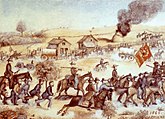
Nichols's Missouri Cavalry Regiment served in the Confederate States Army during the later stages of the American Civil War. The regiment was recruited in early 1864 and officially formed on June 22. It participated in Price's Raid, an attempt to create a popular uprising against Union control of Missouri. It was part of an unsuccessful pursuit of Union troops after the Battle of Fort Davidson in late September. At the Battle of Little Blue River on October 21, Nichols's Regiment attacked the Union flank, materially aiding the Confederate victory. The next day, the regiment participated in the successful Battle of Byram's Ford. On October 23, Nichols's Regiment fought in the Confederate defeat at the Battle of Westport, which caused a Confederate retreat. The unit was part of the rear guard. The unit disbanded before the war ended in 1865. It had a strength of about 300 men in August 1864 and the casualties it suffered cannot be accurately determined. (Full article...)
983 characters, including spaces.
Battle of Dupplin Moor
![]()

The Battle of Dupplin Moor was fought between supporters of King David II of Scotland and English-backed invaders supporting Edward Balliol on 11 August 1332. This was the first major battle of the Second War of Scottish Independence. Balliol and a largely English force of 1,500 landed in Fife and marched on [[Perth, Scotland |Perth]], the Scottish capital. The Scots, estimated to have been between 15,000 and 40,000 strong, raced to attack the English, disorganising their own formations. Unable to break the line of English men-at-arms, the Scots became trapped in a valley with fresh forces arriving from the rear pressing them forward and giving them no room to manoeuvre, or even to use their weapons. English longbowmen fired into both Scottish flanks. Many Scots died of suffocation or were trampled underfoot. Eventually they broke and the English men-at-arms mounted and pursued the fugitives until nightfall. Perth fell, the remaining Scottish forces dispersed and Balliol was crowned King of Scotland. (Full article...)
1,012 characters, including spaces.
Fort Concho
![]()
Fort Concho is a former United States Army installation and a National Historic Landmark located in San Angelo, Texas. It was established in November 1867 on the Butterfield Overland Mail Route and the Goodnight–Loving Trail, and was an active military base for 22 years. It housed the 4th Cavalry from 1867 to 1875 and the "Buffalo Soldiers" of the 10th Cavalry from 1875 and 1882. Troops stationed at Fort Concho participated in Ranald S. Mackenzie's 1872 summer campaign, the Red River War in 1874, and the Victorio Campaign of 1879–1880. The fort was abandoned in June 1889 and over the next twenty years was divided into residences and businesses, with the buildings repurposed or recycled for their materials. Efforts to preserve and restore Fort Concho began in the 1900s and the Fort Concho Museum was founded in 1929. Fort Concho was named a National Historic Landmark on July 4, 1961, and is one of the best-preserved examples of the military installations built by the US Army in Texas. (Full article...)
1,013 characters, including spaces.
National Union of Freedom Fighters
![]()
The National Union of Freedom Fighters (NUFF) was an armed Marxist revolutionary group in Trinidad and Tobago. The group fought a guerrilla campaign to overthrow the government of Prime Minister Eric Williams following the failed 1970 Black Power uprising and a mutiny in the Trinidad and Tobago Regiment. NUFF formed from the Western United Liberation Front, a loose grouping of largely unemployed men from the western suburbs of Port of Spain. The group drew disaffected members of the National Joint Action Committee, a Black Power organisation, and established a training camp in south Trinidad. In 1972 and 1973 NUFF attacked police posts to acquire weapons, robbed banks, and carried out an insurgent campaign against the government. With improved intelligence capabilities, the government eventually killed or captured most of its leadership. Eighteen NUFF members and three policemen were killed over the course of the insurgency. NUFF was anti-imperialist and anti-capitalist in its ideology. It was notable for the extent to which women played an active role in the organisation, and included women among its guerrilla fighters. (Full article...)
1,156 characters, including spaces, no image.
Bring Us Together
![]()
"Bring Us Together" was a political slogan popularized after the election of Republican candidate Richard Nixon as United States President in 1968. Richard Moore, a friend of Nixon, told the candidate's speechwriters he had seen a child carrying a sign reading "Bring Us Together" at a rally in Deshler, Ohio during the campaign and the speechwriters began inserting the phrase into the candidate's speeches. Nixon mentioned the Deshler rally and the sign in his victory speech on November 6, 1968, adopting the phrase as representing his administration's initial goal—to reunify the bitterly divided country. 13-year-old Vicki Lynne Cole came forward as the person who carried the sign, and was the subject of intense media attention. The phrase "Bring Us Together" was subsequently used ironically by Democrats when Nixon proposed policies they disagreed with or refused to support. In newspaper columns in the 2000s, one former speechwriter expressed doubts that Cole's sign ever existed. (Full article...)
1,009 characters, including spaces.
Battle of Marais des Cygnes
![]()
The Battle of Marais des Cygnes took place on October 25, 1864, in Linn County, Kansas, during Price's Missouri Raid in the American Civil War. A large Confederate cavalry incursion into Missouri in late 1864 attempted to draw Union troops away from the fighting further east. After several victories the Confederates were defeated at the Battle of Westport and withdrew into Kansas. They camped along the banks of the Marais des Cygnes River on the night of October 24 while Union cavalry pursuers skirmished with their rear guard. The battle began early the next morning as 3,500 Union troops drove this force from its position, capturing cannons, prisoners, and wagons. An attempted stand at the river crossing was outflanked by a Union cavalry regiment, forcing the Confederates to abandon it. A rear guard action by a 1,200-man Confederate brigade bought time to disengage and retreat. After two further defeats on the 25th and another on October 28, the Confederates retreated to Texas. (Full article...)
1.010 characters, including spaces.
Temporary gentlemen
![]()

Temporary gentlemen is a colloquial term referring to officers of the British Army who held temporary (or war-duration) commissions, particularly when such men came from outside the traditional "officer class". Historically the officers of the British Army were drawn from the gentry and upper middle-classes. The First World War required a rapid expansion of the officer corps and more than 265,000 additional officers were recruited, many on temporary commissions. Many of these were drawn from the lower middle and working classes. They came to be referred to as "temporary gentlemen" with the expectation being that they would revert to their former social standing after the war. The term was revived in the Second World War, which saw a similar increase in the number of officers holding temporary commissions. The term continued to see use for officers commissioned from those conscripted for National Service, which lasted until 1963. (Full article...)
960 characters, including spaces.
SMS Nymphe (1863)
![]()
SMS Nymphe was the lead ship of the Nymphe class of steam corvettes, built for the Prussian Navy. A wooden-hulled ships armed with a battery of sixteen guns Nymphe was laid down in January 1862, launched in April 1863, and completed that October. She saw action during the Second Schleswig War against Denmark in 1864 at the Battle of Jasmund; but was not engaged during the Austro-Prussian War of 1866. During the Franco-Prussian War in 1870 a French squadron of ironclads had anchored off Danzig, and Nymphe launched a surprise night attack. This was ineffective, but convinced the French to withdraw from a close blockade of German ports. In 1871, Nymphe embarked on a major overseas deployment to the Pacific Ocean and East Asia and remained abroad until mid-1874, after which she was converted into a training ship for apprentice seamen. She underwent a a complete reconstruction in 1885, but was stricken from the naval register in July 1887 and hulked. Nymphe was sold in 1891 and broken up. (Full article...)
1,016 characters, including spaces.
Bombing of Yawata (June 1944)
![]()
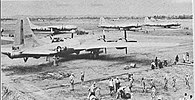
The Bombing of Yawata on the night of 15/16 June 1944 was the first air raid on the Japanese home islands conducted by United States Army Air Forces (USAAF) strategic bombers during World War II. The raid was undertaken by 75 B-29 Superfortress heavy bombers staging from bases in China. Only 47 of these aircraft bombed the raid's primary target, the Imperial Iron and Steel Works at Yawata, and little damage was caused. Five B-29s were lost in accidents during the operation and two were destroyed by Japanese aircraft. While the raid did not achieve its aims, it raised Japanese civilians' awareness that their country was being defeated and received unduly positive media coverage in the United States. Intelligence gathered by the B-29s also revealed weaknesses in Japan's air defenses and the raid was the first of many on Japan. Yawata was attacked again on 20 August 1944. Much of the city was destroyed in a firebombing raid conducted by B-29s based in the Mariana Islands on 8 August 1945. (Full article...)
1,018 characters, including spaces.
Laguna del Maule (volcano)
![]()
Laguna del Maule is a volcanic field in the Andes mountain range of Chile. The volcanic field covers an area of 500 square kilometres (190 sq mi) and features at least 130 volcanic vents. The field gets its name from Laguna del Maule lake which is surrounded by cones, lava domes, lava coulees and lava flows. The field's volcanic activity began 1.5 million years ago during the Pleistocene. Three major caldera-forming eruptions took place in the volcanic field prior to the last glacial period. In the postglacial era, volcanic activity has increased. In pre-Columbian times, the field was a source of obsidian of regional importance. Today geothermal phenomena occur at Laguna del Maule. Between 2004 and 2007, ground inflation began in the volcanic field, indicating the intrusion of a sill beneath it. The rate of inflation is faster than those measured on other inflating volcanoes, which has created concern about the potential for impending large-scale eruptive activity. (Full article...)
997 characters, including spaces.
SS Minnesotan
![]()
SS Minnesotan was a cargo ship built in 1912 for the American-Hawaiian Steamship Company. During World War I she was known as USAT Minnesotan in service for the U.S. Army and USS Minnesotan (ID-4545) in service for the U.S. Navy. She was built as one of eight sister ships, and employed in inter-coastal service via the Isthmus of Tehuantepec and the Panama Canal. In World War I, Minnesotan carried cargo and animals to France from September 1917. After the Armistice she returned over 8,000 American troops. In 1919, Minnesotan resumed inter-coastal cargo service. During World War II, the ship was requisitioned by the War Shipping Administration and initially sailed between New York and Caribbean ports. In the latter half of 1943, Minnesotan sailed between Indian Ocean ports, and the following year between New York and ports in the United Kingdom, before returning to the Caribbean. In 1949, Minnesotan was sold to Italian owners who renamed her Maria Luisa R.. She was scrapped in 1952 at Bari. (Full article...)
1,021 characters, including spaces.
Sutton United 2–1 Coventry City (1989)
![]()

The match between Sutton United and Coventry City was an association football game played on 7 January 1989 as part of the third round of the 1988–89 FA Cup. Coventry City were in the top tier of English league football, while Sutton United were in the fifth. Coventry, the away team, started as strong favourites. The home side took the lead three minutes before half-time when a corner towards the near post was missed by the Coventry goalkeeper and volleyed into the goal by Tony Rains. Seven minutes into the second half, David Phillips was able to shoot past the Sutton goalkeeper to make it 1–1. In the 59th minute, a short corner kick was crossed to Matthew Hanlan who volleyed in to give Sutton the lead once again. Despite numerous late chances for Coventry, the match ended 2–1. One of the most famous 'giant-killings' in the competition's history, the match has been described as "the biggest shock in the history of the FA Cup [and] one of the biggest in any game ever". (Full article...)
1,000 characters, including spaces.
Battle of Heraklion
![]()
The Battle of Heraklion was fought during World War II on the island of Crete between 20 and 29 May 1941. British, Australian and Greek forces defended Heraklion port and airfield against a German paratrooper attack. The German assault was launched without direct air support, and spread over several hours rather than simultaneously. German units dropping near Heraklion (pictured) suffered very high casualties, those dropping further away were severely hampered by Cretan partisans. The German attack failed. When it was renewed the next day it failed again. The fighting then settled into a stalemate. A convoy of German seaborne reinforcements was intercepted by a British naval squadron and scattered. The Germans concentrated on the battle for Maleme airfield, which the they won, causing the Allies to order an evacuation. Commonwealth troops were taken off by Allied warships on the night of 28/29 May; two destroyers were sunk and two cruisers badly damaged, causing many casualties. (Full article...)
1,011 characters, including spaces.
R. A. B. Mynors
![]()
Sir Roger Aubrey Baskerville Mynors (28 July 1903 – 17 October 1989) was an English classicist and medievalist who held the senior chair of Latin at the universities of Oxford and Cambridge. He served as the Kennedy Professor of Latin at Cambridge from 1944 to 1953 and as the Corpus Christi Professor of Latin at Oxford from 1953 until his retirement in 1970. Mynors' reputation is that of one of Britain's foremost classicists. A textual critic, he specialised in the study of manuscripts and their role in the reconstruction of classical texts. He was an expert on palaeography, and has been credited with unravelling a number of highly complex manuscript relationships. His publications include critical editions of Vergil, Catullus, and Pliny the Younger. In addition to receiving honorary degrees and fellowships from various institutions, Mynors was made a Knight Bachelor in 1963. He died in a car accident, aged 86. His comprehensive commentary on Vergil's Georgics was published posthumously. (Full article...)
1,020 characters, including spaces.
Scorpion
![]()

Scorpions are predatory arachnids of the order Scorpiones. They have eight legs, a pair of grasping pincers and a narrow, segmented tail, often carried in a characteristic forward curve over the back and always ending with a stinger. There are over 2,500 described species. They mainly live in deserts but have adapted to a wide range of environments. Most species give live birth and the female cares for the young as their exoskeletons harden, transporting them on her back. Scorpions primarily prey on insects and other invertebrates, but some species take vertebrates. They use their pincers to restrain and kill prey. Scorpions themselves are preyed on by larger animals. Their venomous sting can be used both for killing prey and for defense. Only about 25 species have venom capable of killing a human. In regions with highly venomous species, human fatalities regularly occur. Scorpions with their powerful stingers appear in art, folklore, mythology, and commercial brands. (Full article...)
1,000 characters, including spaces
George Vincent (painter)
![]()
George Vincent (1796 – c.1832) was an English landscape artist who produced watercolours, etchings and oil paintings. He is considered to be one of the most talented of the Norwich School of painters, a group of artists inspired by the Norfolk countryside. Vincent's work was founded on the Dutch school of landscape painting and the style of John Crome, also of the Norwich School. The son of a weaver, Vincent was apprenticed to Crome. He exhibited at the Royal Academy, British Institution, and elsewhere. From 1811 until 1831 he showed at the Norwich Society of Artists, exhibiting more than a 100 pictures of Norfolk landscapes and marine works. By 1818 he had relocated to London, yet struggled financially. He was inprisoned for debt 1824 – 1827. After 1831, Vincent disappeared and was never found. The art historian Herbert Cundall wrote in the 1920s that had Vincent "not given way to intemperate habits he would probably have ranked amongst the foremost of British landscape painters". (Full article...)
1,014 characters, including spaces
Yazid I
![]()

Yazid I (646 – 11 November 683) was the second caliph of the Umayyad Caliphate. He ruled from April 680 until his death. His appointment was the first hereditary succession to the caliphate in Islamic history. Yazid's nomination as heir apparent was opposed by several Muslim grandees from the Hejaz region, including Muhammad's grandson Husayn ibn Ali. Husayn refused to recognize Yazid following his accession and left for Kufa in Iraq to lead a revolt. He was killed in the Battle of Karbala. Yazid sent an army to suppress the subsequent rebellion in the Hejaz which captured and sacked the city of Medina. Next, Mecca was besieged for several weeks until the army withdrew as a result of Yazid's death. The Caliphate fell into a decade-long civil war known as the Second Fitna, ending with the establishment of the Marwanid dynasty. Yazid is considered an illegitimate ruler and a tyrant by many Muslims. Modern historians consider him a capable ruler, albeit less successful than his father. (Full article...)
1,015 characters, including spaces.
Boeing 747
![]()
The Boeing 747 is a large, long–range, wide-body airliner and cargo aircraft manufactured by Boeing Commercial Airplanes in the United States. On September 30, 1968, the first 747 was rolled out of the custom-built Everett Plant, the largest building in the world by volume. The first flight took place on February 9, 1969 and the 747 was certified that December. It entered service with Pan Am on January 22, 1970; it was the first airplane dubbed a "Jumbo Jet". The 747 is a quadjet, with ten-abreast economy seating and typically accommodates 366 passengers. It has a pronounced 37.5° wing sweep, allowing a Mach 0.85 (490 kn; 560 mph; 900 km/h) cruise speed. Boeing introduced the -200 in 1971, with more powerful engines for a heavier maximum takeoff weight and a longer range. The heavier 747-400 was introduced in 1989 and is the most common variant. By June 2020, 1,556 aircraft had been built. As of 2020, 61 Boeing 747s have been lost in accidents, in which 3,722 people have died. (Full article...)
1,009 characters, including spaces
Die Hard
![]()
Die Hard is a 1988 American action film directed by John McTiernan and written by Jeb Stuart and Steven E. de Souza. It stars Bruce Willis (pictured), Alan Rickman, Alexander Godunov, and Bonnie Bedelia. Based on the 1979 novel Nothing Lasts Forever by Roderick Thorp, Die Hard follows New York City police detective John McClane (Willis) who is caught up in a terrorist takeover of a Los Angeles skyscraper. Filming took place in 1987 and 1988, on a $25 million–$35 million budget. Reviews were mixed, but Die Hard became the year's highest-grossing action film. It received four Academy Award nominations, elevated Willis to leading-man status and made Rickman a celebrity. It is now considered one of the greatest action films. It revitalized the genre, largely due to its depiction of McClane as a vulnerable and fallible protagonist. "Die Hard" became a shorthand for plots in which a hero battles in a restricted environment. It was selected for preservation in the National Film Registry in 2017. (Full article...)
1,021 characters, including spaces
Union of Bulgaria and Romania
![]()
Several attempts were made to unify Bulgaria and Romania in the 19th and early 20th centuries, under either a federation, a personal union or a confederation. Bulgarians and Romanians had lived together under the rule of the First and Second Bulgarian Empires, and then the Ottoman Empire for centuries. After the establishment of an autonomous Bulgarian principality there were several unsuccessful Romanian nominees for its throne. In 1886 Bulgarian leader Stefan Stambolov tried again to establish a personal union with Romania, and negotiations were conducted. This and other proposals ultimately failed because of cultural and political differences and opposition from Austria-Hungary and especially Russia, which threatened to break off diplomatic relations with Romania, or even invade. Approaches to effect a union were attempted during the communist era, but the Soviet Union strongly rejected them. Now that Bulgaria and Romania are both members the European Union, the idea has been revitalized. (Full article...)
1,024 characters, including spaces
Heart of Thomas
![]()

The Heart of Thomas is a 1974 Japanese manga series written and illustrated by Moto Hagio (pictured). Originally serialized in Shūkan Shōjo Comic, a weekly manga magazine publishing shōjo manga – manga aimed at young and adolescent women – the series follows the events at a German all-boys school after the suicide of student Thomas Werner. It is one of the earliest manga in the shōnen-ai (male-male romance) genre. While The Heart of Thomas was initially poorly received by readers, by the end of its serialization it was among the most popular series in Shūkan Shōjo Comic. It significantly influenced shōjo manga as a medium, with many of the stylistic and narrative hallmarks of the series becoming standard tropes of the genre. The series has attracted considerable scholarly interest, and has been adapted into a film, a stage play, and a novel. In North America, an English-language translation of The Heart of Thomas, translated by Rachel Thorn, was published by Fantagraphics Books in 2013. (Full article...)
1.008 characters, including spaces
Death of Mark Saunders
![]()

Mark Saunders was a British barrister who struggled with depression and alcoholism. On 6 May 2008 he repeatedly fired a shotgun from a window of his his home in Markham Square, London. When armed police arrived, Saunders fired at their vehicle (similar to that pictured) and a siege began. Saunders fired twice more and police returned fire, slightly wounding him. Saunders then waved the shotgun out of a window in the direction of a group of police officers; seven officers fired eleven shots, of which at least five struck him. Saunders was pronounced dead at a waiting ambulance. An inquest was held where the jury returned a verdict of lawful killing, but found several flaws in the police handling of the incident. They did not consider that any of these significantly contributed to the outcome. They could not decide whether Saunders had intentionally provoked a lethal response ("suicide by cop"). In 2010, the Metropolitan Police created a unit of senior officers to manage similar incidents. (Full article...)
1,020 characters, including spaces
Greek case
![]()

The Greek case was brought to the European Commission of Human Rights in September 1967. It alleged violations of the European Convention on Human Rights (ECHR) by the Greek junta, which had ousted the Greek government in April and suppressed its opposition. A second case alleging additional violations, including of Article 3 forbidding torture, was added shortly after. In 1968 and 1969, a subcommission questioned witnesses and embarked on a fact-finding mission to Greece. It generated a report proving systematic torture. The report was leaked to the press and turned European public opinion against Greece. The subcommission submitted its report to the Commission in October 1969. On 12 December 1969, the Committee of Ministers of the Council of Europe considered a resolution on the issue. With sentiment against Greece, foreign minister Panagiotis Pipinelis (pictured) denounced the ECHR and walked out. Greece returned to the organization after the Greek democratic transition in 1974. (Full article...)
1,014 characters, including spaces.
Battle of Rethymno
![]()
The Battle of Rethymno was part of the Battle of Crete, fought during World War II on the Greek island of Crete between 20 and 29 May 1941. Two Australian battalions, supported by Greek forces, defended an airstrip and the nearby town of Rethymno against a German paratrooper attack (pictured). Due to confusion and delays at the airfields in Greece the assault was launched without direct air support, and spread over an extended period rather than simultaneously. Those German units dropping near the Allied positions suffered very high casualties, both from ground fire and once they had landed. Over 500 Germans were captured, included the local commander. The Germans concentrated all resources on the battle for Maleme airfield, 50 mi (80 km) to the west, which they won. The Allies ordered an evacuation of Crete on 27 May, but were unable to communicate this to the units at Rethymno. Faced by a superior force of Germans equipped with tanks and artillery the Australians surrendered on 29 May. (Full article...)
1,020 characters, including spaces
William Hardham
![]()
William Hardham (31 July 1876 – 13 April 1928) was a New Zealand soldier and recipient of the Victoria Cross, the highest award for gallantry "in the face of the enemy" that could be awarded at the time to personnel of the British and Commonwealth forces. Hardham volunteered to serve with the New Zealand Military Forces in the Boer War in 1900. He was on a patrol in the South African Transvaal when it was ambushed. He rode to the rescue of a wounded soldier while under heavy fire and for this he was awarded the Victoria Cross. He re-enlisted in 1901, and was sent to England for the coronation of King Edward VII and Queen Alexandra. When the First World War began, he volunteered for the New Zealand Expeditionary Force, serving during the Gallipoli Campaign, where he was wounded. After the war, he worked for a newspaper and later the Public Works Department, as well being involved in veterans' affairs and rugby administration with the Wellington Rugby Football Union. (Full article...)
998 characters, including spaces
Sulayman ibn Abd al-Malik
![]()
Sulayman ibn Abd al-Malik (c. 675 – 22 September 717) was the seventh Umayyad caliph, ruling from 715 until his death. He began his career as governor of Palestine, while his father Abd al-Malik (r. 685–705) and brother al-Walid I (r. 705–715) reigned as caliphs. He founded the city of Ramla, the administrative capital of Palestine, and built the White Mosque in it. After succeeding al-Walid, Sulayman dismissed his predecessor's governors and generals. Territorial expansion largely stopped under Sulayman, partly due to effective resistance along the frontiers. He intensified the war with the Byzantine Empire, culminating in the 717–718 siege of Constantinople, which ended in the Arabs' defeat. Sulayman died in Dabiq during the siege. He made the unconventional choice of nominating his cousin, Umar II, as successor. Sulayman was viewed by contemporary Arab poets in messianic terms due to the siege of Constantinople and the approaching centennial of the Hegira (start of the Islamic calendar). (Full article...)
1,023 characters, including spaces
Hi al Ameer and congratulations. A draft blurb for this article is above. Thoughts, comments and edits from you or from anyone else interested are welcome. Gog the Mild (talk) 21:54, 28 March 2021 (UTC)
United States war plans (1945–1950)
![]()

United States war plans for a conflict with the Soviet Union were formulated on a regular basis between 1945 and 1950 by the U.S. Joint Chiefs of Staff (pictured in 1948). It was not considered likely that the Soviet Union or United States would resort to war, only that one could potentially occur as a result of a terrible miscalculation. All war plans assumed that the conflict would open with a massive Soviet offensive. The defense of Western Europe was regarded as impractical, and plans called for a withdrawal to the Pyrenees, while a strategic air offensive was mounted. By 1949, plans called for an attempt to hold Soviet forces on the Rhine. A strategic air offensive was regarded as the only means of striking back in the short term. It called for the delivery of up to 292 atomic bombs and 246,900 short tons (224,000 t) of conventional bombs. About 6.7 million casualties were anticipated, of whom 2.7 million would be killed. The concept of nuclear deterrence was not a part of the plans. (Full article...)
1.021 characters, including spaces
League of Legends
![]()
League of Legends (logo pictured) is a multiplayer online battle arena video game developed and published by Riot Games. Released in 2009, the game is free-to-play and is monetized through purchasable character customization. It is available for Microsoft Windows and macOS. Two teams of five players battle in player versus player combat: each player controls a character, each with a different style of play. The game has received generally good reviews, which have trended positively over its long lifespan. In 2019 the game regularly recorded eight million concurrent players, and its popularity has led to tie-ins such as music videos, comic books, short stories, and an upcoming animated series. A massively multiplayer online role-playing game is in development. It is often cited as the world's largest esport; the 2019 League of Legends World Championship had over 100 million unique viewers, peaking at a concurrent 44 million viewers, with a minimum prize pool of US$2.5 million. (Full article...)
1,008 characters, including spaces
1985 World Snooker Championship final
![]()
The 1985 World Snooker Championship final was a snooker match played on the weekend of 27–28 April 1985 at the Crucible Theatre in Sheffield, England. It was the final of the 1985 World Snooker Championship between defending world champion Steve Davis and 1979 runner-up Dennis Taylor (both pictured). The best-of-35-frame match was split into four sessions; Taylor was never ahead during the match, but tied at 17–17. The deciding frame culminated with several shots on the final ball – the black – which Taylor potted to win his only world championship. The final climaxed in the early hours of 29 April and was viewed by 18.5 million people in the UK, as of 2020 the record for a post-midnight television audience. The total match time of 14 hours and 50 minutes is the longest recorded for a best-of-35 frames match. The match is one of the most famous snooker matches of all time and part of the reason for the surge in the sport's popularity in the 1980s and 1990s. (Full article...)
989 characters, including spaces
International Conference on the Holocaust and Genocide
![]()
The International Conference on the Holocaust and Genocide was the first major conference in the field of genocide studies. It was held in Tel Aviv, at the Hilton Hotel (pictured), on 20–24 June 1982 and was organized by the Institute on the Holocaust and Genocide. The conference marked the shift from viewing genocide as an irrational phenomenon to one that could be studied and understood. The Turkish government tried to have the conference cancelled because it included presentations on the Armenian Genocide, which Turkey denies. Turkey threatened to close its borders to Syrian and Iranian Jews fleeing persecution, which led the Israeli government to also attempt to cancel the conference. The official Israeli Holocaust memorial, Yad Vashem withdrew, as did many high-profile participants. The organizers refused to remove the Armenian Genocide from the program and held the conference anyway. Both the Turkish and Israeli governments faced criticism for their infringement on academic freedom. (Full article...)
1,022 characters, including spaces.
République-class battleship
![]()
The République class consisted of a pair of pre-dreadnought battleships—République and Patrie—built for the French Navy in the early 1900s. They were a significant improvement over previous French battleships, with the same four 305 mm (12 in) guns and eighteen 164 mm (6.5 in) guns, but with most of the 164 mm guns mounted in gun turrets rather than in casemates. They also had more effective armored protection. Both ships entered service in January 1907, shortly after the British HMS Dreadnought made all existing battleships obsolescent. During World War I both ships operated in the Mediterranean. The Patrie supported the Gallipoli campaign from May 1915 and République joined her in January 1916. Both ships then became involved in Greece, where they assisted a coup against the neutral but pro-German government that ultimately led to Greece's entry into the war on the side of the Allies. Neither ship saw any further action. République was decommissioned in 1921; Patrie not until 1937. (Full article...)
1,016 characters, including spaces
Thomas Erpingham
![]()
Thomas Erpingham (c. 1355 – 27 June 1428) was an English soldier and administrator who served three generations of the House of Lancaster including two English kings. Through his access to royal patronage he acquired great wealth and influence. During the reign of Richard II he served under the King's uncle John of Gaunt, Duke of Lancaster, in Spain and Scotland, and with his son Henry Bolingbroke on crusades in Lithuania, Prussia and the Holy Land. On becoming king Bolingbroke rewarded Erpingham with senior appointments. Erpingham later helped suppress the Epiphany Rising and was appointed guardian of Henry's second son Thomas. He was a member of the Privy Council, acting at one point as marshal of England. In 1415 Erpingham served as a knight banneret in Henry's campaign in France and commanded the archers at the Battle of Agincourt. He was a benefactor to the city of Norwich, where he had built the main cathedral gate which bears his name. (Full article...)
974 characters, including spaces.
4th Missouri Infantry Regiment (Confederate)
![]()
The 4th Missouri Infantry Regiment was an infantry regiment that served in the Confederate States Army during the American Civil War. Organized on April 28, 1862, the regiment was present at the Battles of Farmington on May 9, and Tuka on September 19. The regiment participated in three charges against Union lines on October 3, 1862, during the Second Battle of Corinth. On October 4, the regiment and its brigade attacked fresh Union lines. Despite initial success, their attack was repulsed by a Union counterattack. On November 7, 1862, the regiment was combined with the 1st Missouri Infantry to form the 1st and 4th Missouri Infantry Regiment (Consolidated). The combined unit served in the Vicksburg campaign in 1863, before surrendering at the end of the Siege of Vicksburg. After being exchanged, the men rejoined the Confederate Army and served in the Atlanta campaign and the Battle of Franklin in 1864. On May 9, 1865, the consolidated regiment surrendered during the Battle of Fort Blakeley. (Full article...)
1,023 characters, including spaces
Battle of Inverkeithing
![]()
The Battle of Inverkeithing was fought on 20 July 1651 between English and Scottish armies. As part of the political turmoil of the English Civil War, an English army under Oliver Cromwell had invaded Scotland in July 1650, heavily defeated a Scottish army at the Battle of Dunbar. The Scots withdrew to the choke point of Stirling. For nearly a year all attempts to storm or bypass Stirling, or to draw the Scots out into another battle, failed. On 17 July 1651 an English force crossed the Firth of Forth at its narrowest point in flat-bottomed boats and landed at North Queensferry. The Scots sent forces to pen the English in, and the English reinforced their landing. On 20 July the Scots moved against the English and in a short engagement were routed. The English seized the deep-water port of Burntisland and Cromwell shipped over most of the English army. He then marched on and captured Perth, the temporary seat of the Scottish government, cutting off supplies for the Scottish army. (Full article...)
1,012 characters, including spaces
Charles Green (Australian soldier)
![]()
Charles Green was an Australian part-time Militia officer who volunteered for overseas service at the start of World War II. He fought in Greece in 1941 and returned to Australia in August 1942. From March to July 1945, Green commanded the 2/11th Battalion during the Aitape–Wewak campaign in New Guinea, becoming the youngest Australian infantry battalion commander. For his performance during the campaign, Green was made a Companion of the Distinguished Service Order. He later commanded the 3rd Battalion, Royal Australian Regiment, during the Korean War. The battalion advanced during the UN offensive into North Korea, fighting in Battles of the Apple Orchard, the Broken Bridge and Chongju. On 30 October 1950, Green was wounded in the stomach by a shell fragment. Evacuated to hospital, he died of his wounds the following day, aged 30, and was subsequently awarded the US Silver Star. He remains the only commanding officer of a battalion of the Royal Australian Regiment to die on active service. (Full article...)
1,024 characters, including spaces
Typhoon Maemi
![]()
Typhoon Maemi was the most powerful typhoon to strike South Korea since records began in 1904. Maemi formed on September 4, 2003 in the western Pacific and became a typhoon on September 8. Passing over the Japanese island of Miyako-jima on September 10 it left 95% of residents without power and caused 58.5 mm (2.30 in) of rainfall in an hour and 402.5 mm (15.85 in) in 24 hours. Maintaining much of its intensity, it made landfall west of Busan, South Korea, on September 12, where winds reached 154 km/h (96 mph). The port sustained heavy damage, restricting exports for months. On Jeju Island, it produced a peak wind gust of 216 km/h (134 mph) and a minimum pressure of 950 mbar (28 inHg), both records for the country. Nationwide, high winds destroyed about 5,000 houses and damaged 13,000 buildings, leaving 25,000 people homeless. Crop damage resulted in the poorest rice harvest in 23 years. Across South Korea, Maemi killed 117 people, and damage totaled ₩5.52 trillion won (KRW, US$4.8 billion). (Full article...)
1,024 characters, including spaces
Whitehawk Camp
![]()
Whitehawk Camp is the remains of a causewayed enclosure, on Whitehawk Hill near Brighton, England. (Sketch plan pictured.) Causewayed enclosures are a form of early Neolithic earthwork, characterized by the enclosure of an area with ditches that are interrupted by gaps, or causeways. Their purpose is not known. The site consists of four roughly concentric circular ditches; at least two ditches touch the outermost circuit from the outside, one of which is thought to date to about two thousand years after the earliest dated activity at the site. Whitehawk was first excavated in 1929 and again in the winter of 1932–1933. In 1935 the area to be crossed by a new road was excavated. In 1991, during the construction of a housing development, a ditch was discovered and excavated. In 2011, an analysis of radiocarbon dates concluded that the Neolithic part of the site was probably constructed between 3650 and 3500 BC, and probably went out of use some time between 3500 and 3400 BC. (Full article...)
980 characters, including spaces
M113 armoured personnel carriers in Australian service
![]()
The M113 armoured personnel carrier has been operated by the Australian Army in large numbers since 1964. Either 817 or 840 M113s were acquired between 1964 and 1979, comprising nine different variants. In Australian service, the M113 has equipped armoured transport and reconnaissance units as well as mechanised infantry formations. It has been used as a support vehicle by many other units. The type played an important role in Australia's commitment to the Vietnam War between 1965 and 1972 (pictured). Small numbers of M113s were deployed to Somalia during 1993 and Rwanda between 1994 and 1995. Larger numbers of M113s operated in East Timor from 1999 to 2002 and 2006 to 2008. A long-running modernisation resulted in 431 being upgraded between 2007 and 2012. Despite the upgrade program, the Australian Army's M113s are now obsolete and they have not been included in recent deployments due to their vulnerability. Replacement infantry fighting vehicles are scheduled to enter service from 2025. (Full article...)
1,021 characters, including spaces
HMS Princess Royal (1911)
![]()
HMS Princess Royal was built for the British Royal Navy before the First World War in response to the Moltke-class battlecruisers of the Imperial German Navy and significantly improved on the speed, armament, and armour of earlier battlecruisers. Laid down in 1912 and commissioned in 1913, Princess Royal served in the Battle of Heligoland Bight a month after the war began. During the Battle of Dogger Bank, Princess Royal scored few hits, although one crippled the German armoured cruiser Blücher. Shortly afterward, she became the flagship of the 1st Battlecruiser Squadron, under the command of Rear-admiral Osmond Brock. Princess Royal was moderately damaged during the Battle of Jutland and required a month and a half of repairs. Apart from providing distant support during the Second Battle of Heligoland Bight in 1917, the ship spent the rest of the war on uneventful patrols of the North Sea. She was sold for breaking up as scrap in 1922. (This article is part of a featured topic: Battlecruisers of the world.)
1,020 characters, including spaces
American logistics in the Northern France campaign
![]()
American logistics in the Northern France campaign played a key role after the Allied breakout from the Normandy lodgment began on 25 July 1944. The subsequent advance was much faster than expected and the logistical plan lacked the flexibility to cope with the rapidly changing operational situation. At critical junctures in the campaign, senior American commanders subordinated logistical imperatives to operational opportunities. The decision to abandon plans to develop the ports of Brittany left only the Normandy beaches and the port of Cherbourg. The subsequent decision to pursue the defeated Germans beyond the Seine led to a multitude of logistical problems as increased German resistance stalled the American advance. Motor transport was used as a stopgap; the Red Ball Express was organized to deliver supplies from the Normandy area. However, there was a shortage of suitable vehicles, approval for additional drivers was slow, and racial segregation complicated personnel assignment. (Full article...)
1,016 characters, including spaces
East Knoyle War Memorial
![]()
![]()
The East Knoyle War Memorial is a monument that commemorates the lives of soldiers from East Knoyle, Wiltshire, England, who died during war. Unveiled on 26 September 1920, it was originally intended to commemorate the 20 soldiers from the parish who were lost during the First World War. Subsequent inscriptions were added to recognise twelve who were killed in the Second World War, and a soldier killed by friendly fire during the Iraq War. The memorial was designed by Herbert Maryon, who taught sculpture at the University of Reading. It consists of a three-stepped stone base, a square plinth, and a shaft that rises 16 feet (4.9 m) and terminates in a small wheel cross. Each side of the plinth is inscribed. The front bears an inscription dedicated to those who died in the world wars; each is named on the right and rear. The left panel includes a bible verse and the name of the soldier who died in Iraq. In 2016 the memorial was designated a Grade II listed building. (Full article...)
996 characters, including spaces.
United States war plans (1945–1950)
![]()

United States war plans for a conflict with the Soviet Union were formulated on a regular basis between 1945 and 1950 by the U.S. Joint Chiefs of Staff (pictured in 1948). It was not considered likely that the Soviet Union or United States would resort to war, only that one could potentially occur as a result of a terrible miscalculation. All war plans assumed that the conflict would open with a massive Soviet offensive. The defense of Western Europe was regarded as impractical, and plans called for a withdrawal to the Pyrenees, while a strategic air offensive was mounted. By 1949, plans called for an attempt to hold Soviet forces on the Rhine. A strategic air offensive was regarded as the only means of striking back in the short term. It called for the delivery of up to 292 atomic bombs and 246,900 short tons (224,000 t) of conventional bombs. About 6.7 million casualties were anticipated, of whom 2.7 million would be killed. The concept of nuclear deterrence was not a part of the plans. (Full article...)
1.021 characters, including spaces
League of Legends
![]()
League of Legends (logo pictured) is a multiplayer online battle arena video game developed and published by Riot Games. Released in 2009, the game is free-to-play and is monetized through purchasable character customization. It is available for Microsoft Windows and macOS. Two teams of five players battle in player versus player combat: each player controls a character, each with a different style of play. The game has received generally good reviews, which have trended positively over its long lifespan. In 2019 the game regularly recorded eight million concurrent players, and its popularity has led to tie-ins such as music videos, comic books, short stories, and an upcoming animated series. A massively multiplayer online role-playing game is in development. It is often cited as the world's largest esport; the 2019 League of Legends World Championship had over 100 million unique viewers, peaking at a concurrent 44 million viewers, with a minimum prize pool of US$2.5 million. (Full article...)
1,008 characters, including spaces
1985 World Snooker Championship final
![]()
The 1985 World Snooker Championship final was a snooker match played on the weekend of 27–28 April 1985 at the Crucible Theatre in Sheffield, England. It was the final of the 1985 World Snooker Championship between defending world champion Steve Davis and 1979 runner-up Dennis Taylor (both pictured). The best-of-35-frame match was split into four sessions; Taylor was never ahead during the match, but tied at 17–17. The deciding frame culminated with several shots on the final ball – the black – which Taylor potted to win his only world championship. The final climaxed in the early hours of 29 April and was viewed by 18.5 million people in the UK, as of 2020 the record for a post-midnight television audience. The total match time of 14 hours and 50 minutes is the longest recorded for a best-of-35 frames match. The match is one of the most famous snooker matches of all time and part of the reason for the surge in the sport's popularity in the 1980s and 1990s. (Full article...)
989 characters, including spaces
International Conference on the Holocaust and Genocide
![]()
The International Conference on the Holocaust and Genocide was the first major conference in the field of genocide studies. It was held in Tel Aviv, at the Hilton Hotel (pictured), on 20–24 June 1982 and was organized by the Institute on the Holocaust and Genocide. The conference marked the shift from viewing genocide as an irrational phenomenon to one that could be studied and understood. The Turkish government tried to have the conference cancelled because it included presentations on the Armenian Genocide, which Turkey denies. Turkey threatened to close its borders to Syrian and Iranian Jews fleeing persecution, which led the Israeli government to also attempt to cancel the conference. The official Israeli Holocaust memorial, Yad Vashem withdrew, as did many high-profile participants. The organizers refused to remove the Armenian Genocide from the program and held the conference anyway. Both the Turkish and Israeli governments faced criticism for their infringement on academic freedom. (Full article...)
1,022 characters, including spaces.
République-class battleship
![]()
The République class consisted of a pair of pre-dreadnought battleships—République and Patrie—built for the French Navy in the early 1900s. They were a significant improvement over previous French battleships, with the same four 305 mm (12 in) guns and eighteen 164 mm (6.5 in) guns, but with most of the 164 mm guns mounted in gun turrets rather than in casemates. They also had more effective armored protection. Both ships entered service in January 1907, shortly after the British HMS Dreadnought made all existing battleships obsolescent. During World War I both ships operated in the Mediterranean. The Patrie supported the Gallipoli campaign from May 1915 and République joined her in January 1916. Both ships then became involved in Greece, where they assisted a coup against the neutral but pro-German government that ultimately led to Greece's entry into the war on the side of the Allies. Neither ship saw any further action. République was decommissioned in 1921; Patrie not until 1937. (Full article...)
1,016 characters, including spaces
Thomas Erpingham
![]()
Thomas Erpingham (c. 1355 – 27 June 1428) was an English soldier and administrator who served three generations of the House of Lancaster including two English kings. Through his access to royal patronage he acquired great wealth and influence. During the reign of Richard II he served under the King's uncle John of Gaunt, Duke of Lancaster, in Spain and Scotland, and with his son Henry Bolingbroke on crusades in Lithuania, Prussia and the Holy Land. On becoming king Bolingbroke rewarded Erpingham with senior appointments. Erpingham later helped suppress the Epiphany Rising and was appointed guardian of Henry's second son Thomas. He was a member of the Privy Council, acting at one point as marshal of England. In 1415 Erpingham served as a knight banneret in Henry's campaign in France and commanded the archers at the Battle of Agincourt. He was a benefactor to the city of Norwich, where he had built the main cathedral gate which bears his name. (Full article...)
974 characters, including spaces.
4th Missouri Infantry Regiment (Confederate)
![]()
The 4th Missouri Infantry Regiment was an infantry regiment that served in the Confederate States Army during the American Civil War. Organized on April 28, 1862, the regiment was present at the Battles of Farmington on May 9, and Tuka on September 19. The regiment participated in three charges against Union lines on October 3, 1862, during the Second Battle of Corinth. On October 4, the regiment and its brigade attacked fresh Union lines. Despite initial success, their attack was repulsed by a Union counterattack. On November 7, 1862, the regiment was combined with the 1st Missouri Infantry to form the 1st and 4th Missouri Infantry Regiment (Consolidated). The combined unit served in the Vicksburg campaign in 1863, before surrendering at the end of the Siege of Vicksburg. After being exchanged, the men rejoined the Confederate Army and served in the Atlanta campaign and the Battle of Franklin in 1864. On May 9, 1865, the consolidated regiment surrendered during the Battle of Fort Blakeley. (Full article...)
1,023 characters, including spaces
Battle of Inverkeithing
![]()
The Battle of Inverkeithing was fought on 20 July 1651 between English and Scottish armies. As part of the political turmoil of the English Civil War, an English army under Oliver Cromwell had invaded Scotland in July 1650, heavily defeated a Scottish army at the Battle of Dunbar. The Scots withdrew to the choke point of Stirling. For nearly a year all attempts to storm or bypass Stirling, or to draw the Scots out into another battle, failed. On 17 July 1651 an English force crossed the Firth of Forth at its narrowest point in flat-bottomed boats and landed at North Queensferry. The Scots sent forces to pen the English in, and the English reinforced their landing. On 20 July the Scots moved against the English and in a short engagement were routed. The English seized the deep-water port of Burntisland and Cromwell shipped over most of the English army. He then marched on and captured Perth, the temporary seat of the Scottish government, cutting off supplies for the Scottish army. (Full article...)
1,012 characters, including spaces
Charles Green (Australian soldier)
![]()
Charles Green was an Australian part-time Militia officer who volunteered for overseas service at the start of World War II. He fought in Greece in 1941 and returned to Australia in August 1942. From March to July 1945, Green commanded the 2/11th Battalion during the Aitape–Wewak campaign in New Guinea, becoming the youngest Australian infantry battalion commander. For his performance during the campaign, Green was made a Companion of the Distinguished Service Order. He later commanded the 3rd Battalion, Royal Australian Regiment, during the Korean War. The battalion advanced during the UN offensive into North Korea, fighting in Battles of the Apple Orchard, the Broken Bridge and Chongju. On 30 October 1950, Green was wounded in the stomach by a shell fragment. Evacuated to hospital, he died of his wounds the following day, aged 30, and was subsequently awarded the US Silver Star. He remains the only commanding officer of a battalion of the Royal Australian Regiment to die on active service. (Full article...)
1,024 characters, including spaces
Typhoon Maemi
![]()
Typhoon Maemi was the most powerful typhoon to strike South Korea since records began in 1904. Maemi formed on September 4, 2003 in the western Pacific and became a typhoon on September 8. Passing over the Japanese island of Miyako-jima on September 10 it left 95% of residents without power and caused 58.5 mm (2.30 in) of rainfall in an hour and 402.5 mm (15.85 in) in 24 hours. Maintaining much of its intensity, it made landfall west of Busan, South Korea, on September 12, where winds reached 154 km/h (96 mph). The port sustained heavy damage, restricting exports for months. On Jeju Island, it produced a peak wind gust of 216 km/h (134 mph) and a minimum pressure of 950 mbar (28 inHg), both records for the country. Nationwide, high winds destroyed about 5,000 houses and damaged 13,000 buildings, leaving 25,000 people homeless. Crop damage resulted in the poorest rice harvest in 23 years. Across South Korea, Maemi killed 117 people, and damage totaled ₩5.52 trillion won (KRW, US$4.8 billion). (Full article...)
1,024 characters, including spaces
Whitehawk Camp
![]()
Whitehawk Camp is the remains of a causewayed enclosure, on Whitehawk Hill near Brighton, England. (Sketch plan pictured.) Causewayed enclosures are a form of early Neolithic earthwork, characterized by the enclosure of an area with ditches that are interrupted by gaps, or causeways. Their purpose is not known. The site consists of four roughly concentric circular ditches; at least two ditches touch the outermost circuit from the outside, one of which is thought to date to about two thousand years after the earliest dated activity at the site. Whitehawk was first excavated in 1929 and again in the winter of 1932–1933. In 1935 the area to be crossed by a new road was excavated. In 1991, during the construction of a housing development, a ditch was discovered and excavated. In 2011, an analysis of radiocarbon dates concluded that the Neolithic part of the site was probably constructed between 3650 and 3500 BC, and probably went out of use some time between 3500 and 3400 BC. (Full article...)
980 characters, including spaces
M113 armoured personnel carriers in Australian service
![]()
The M113 armoured personnel carrier has been operated by the Australian Army in large numbers since 1964. Either 817 or 840 M113s were acquired between 1964 and 1979, comprising nine different variants. In Australian service, the M113 has equipped armoured transport and reconnaissance units as well as mechanised infantry formations. It has been used as a support vehicle by many other units. The type played an important role in Australia's commitment to the Vietnam War between 1965 and 1972 (pictured). Small numbers of M113s were deployed to Somalia during 1993 and Rwanda between 1994 and 1995. Larger numbers of M113s operated in East Timor from 1999 to 2002 and 2006 to 2008. A long-running modernisation resulted in 431 being upgraded between 2007 and 2012. Despite the upgrade program, the Australian Army's M113s are now obsolete and they have not been included in recent deployments due to their vulnerability. Replacement infantry fighting vehicles are scheduled to enter service from 2025. (Full article...)
1,021 characters, including spaces
HMS Princess Royal (1911)
![]()
HMS Princess Royal was built for the British Royal Navy before the First World War in response to the Moltke-class battlecruisers of the Imperial German Navy and significantly improved on the speed, armament, and armour of earlier battlecruisers. Laid down in 1912 and commissioned in 1913, Princess Royal served in the Battle of Heligoland Bight a month after the war began. During the Battle of Dogger Bank, Princess Royal scored few hits, although one crippled the German armoured cruiser Blücher. Shortly afterward, she became the flagship of the 1st Battlecruiser Squadron, under the command of Rear-admiral Osmond Brock. Princess Royal was moderately damaged during the Battle of Jutland and required a month and a half of repairs. Apart from providing distant support during the Second Battle of Heligoland Bight in 1917, the ship spent the rest of the war on uneventful patrols of the North Sea. She was sold for breaking up as scrap in 1922. (This article is part of a featured topic: Battlecruisers of the world.)
1,020 characters, including spaces
American logistics in the Northern France campaign
![]()
American logistics in the Northern France campaign played a key role after the Allied breakout from the Normandy lodgment began on 25 July 1944. The subsequent advance was much faster than expected and the logistical plan lacked the flexibility to cope with the rapidly changing operational situation. At critical junctures in the campaign, senior American commanders subordinated logistical imperatives to operational opportunities. The decision to abandon plans to develop the ports of Brittany left only the Normandy beaches and the port of Cherbourg. The subsequent decision to pursue the defeated Germans beyond the Seine led to a multitude of logistical problems as increased German resistance stalled the American advance. Motor transport was used as a stopgap; the Red Ball Express was organized to deliver supplies from the Normandy area. However, there was a shortage of suitable vehicles, approval for additional drivers was slow, and racial segregation complicated personnel assignment. (Full article...)
1,016 characters, including spaces
Battle of the Saw
![]()
The Battle of the Saw was the culminating battle of a campaign fought between a Carthaginian army led by Hamilcar Barca and a rebel force led by Spendius in 238 BC in what is now northern Tunisia. Carthage was fighting a coalition of mutinous soldiers and rebellious African cities in the Mercenary War which had started in 240 BC. Unable to confront the Carthaginian war elephants and cavalry on open ground the rebels stayed on higher and rougher terrain and harassed the Carthaginian army. After several months of campaigning, Hamilcar trapped the rebels. Pinned against the mountains, with their supply lines blockaded and with their food exhausted, the rebels ate their horses, their prisoners and then their slaves, hoping that their comrades in Tunis would sortie to rescue them. Eventually, the Carthaginians, led by their elephants, attacked the starving rebels and they were massacred to a man. The captured rebel leaders were crucified in sight of their comrades in Tunis. (Full article...)
1,001 characters, including spaces
Sennacherib
![]()
Sennacherib was the king of the Neo-Assyrian Empire from 705 BC to his death in 681 BC. Sennacherib is one of the most famous Assyrian kings for his role in the Old Testament of the Bible, which describes his campaign in the Levant. The Levantine War of 701 BC broke out after several Assyrian vassals in the region rebelled, including the Kingdom of Judah under King Hezekiah. The Assyrians invaded Judaea, and Hezekiah submitted. Sennacherib faced considerable difficulty in controlling Babylonia and destroyed the city of Babylon in 689 BC. He transferred the capital of Assyria to Nineveh, launching one of the most ambitious building projects in ancient history. He expanded the city, constructed great city walls, numerous temples and a royal garden. Sennacherib was murdered by his eldest son, who hoped to seize power for himself. A younger son, Esarhaddon, raised an army, seized Nineveh, and installed himself as king as intended by Sennacherib. (Full article...)
974 characters, including spaces
Pepi I Meryre
![]()
Pepi I Meryre was the third king of the Sixth Dynasty of Egypt, ruling for c. 50 years during the second half of the 24th century BC. Pepi was the son of his second predecessor Teti, had at least six queens, and was succeeded by son Merenre Nemtyemsaf I. Confronted with the decline of the pharaoh's power at the expense of local officials, Pepi reacted with a vast architectural program involving the construction of numerous temples and chapels throughout Egypt, reinforcing his presence in the provinces. Egypt's prosperity allowed Pepi to become the most prolific builder of the Old Kingdom period. His external policy included military campaigns against Nubia, the Sinai and the southern Levant. Trade with Byblos, Ebla and the oases of the western desert flourished while Pepi launched mining and quarrying expeditions to Sinai and further afield. Pepi had a pyramid complex built for his funerary cult in Saqqara next to which he built at least a further six pyramids for his queens. (Full article...)
1,008 characters, including spaces
1st Missouri Field Battery
![]()
The 1st Missouri Field Battery was a field artillery battery that served in the Confederate States Army during the American Civil War. The battery was formed by Captain Westley F. Roberts in Arkansas in September 1862 and was armed with two 12-pounder James rifles and two 6-pounder smoothbore guns. The unit fought in numerous actions in the Trans-Mississippi Theater in 1862–1864. In December 1863, it received new cannons: two 10-pounder Parrott rifles and two 12-pounder howitzers. On April 30 1864, while part of a Confederate force pursuing a retreating Union army, several of the battery's cannons were captured at the Battle of Jenkins' Ferry. The battery was then rearmed with four 6-pounder smoothbores. In November 1864, the unit was designated the 1st Missouri Field Battery. It was paroled on June 7, 1865, at Alexandria, Louisiana, after General Edmund Kirby Smith signed surrender terms for the Confederate Trans-Mississippi Department on June 2. (Full article...)
979 characters, including spaces
Haane Manahi
![]()
Haane Manahi (1913–1986) was a New Zealand Māori soldier, of the Te Arawa and Ngāti Raukawa iwi (tribe), who served in the Second World War as a member of the Māori Battalion. He participated in the Battles of Greece and Crete and fought through the Western Desert and Tunisian campaigns. He was nominated for a Victoria Cross (VC) for his actions at Takrouna in April 1943. Despite the support of four generals, his VC nomination was downgraded to an award of a Distinguished Conduct Medal. In June 1943, he returned to New Zealand. After his discharge in 1946, he was employed as a traffic inspector; he died in a car crash in 1986. The downgrade of his proposed award of a VC was the source of disappointment and, after his death, a committee was established to urge the New Zealand Government to make representations to Buckingham Palace for a posthumous award of the VC. These efforts were unsuccessful but in 2007 Manahi's bravery was further recognised by a special award from Queen Elizabeth II. (Full article...)
1,021 characters, including spaces
Ba Congress
![]()
The Ba Congress was a meeting of representatives of Draža Mihailović's Chetnik movement between 25 and 28 January 1944 in the village of Ba in German-occupied Serbia during World War II. The congress aimed to advance a political alternative to the communist-led Anti-Fascist Council for the National Liberation of Yugoslavia (AVNOJ) of the Yugoslav Partisans. In December, the major Allied powers decided to provide their exclusive support to the Partisans and withdraw support from the Chetniks. The congress was when large parts of the Chetnik movement had been drawn into collaboration with the Axis forces. The congress denounced the decisions of the AVNOJ, provided its full support to the Yugoslav government-in-exile and re-asserted the Chetnik movement's opposition to the Axis powers and proposed a vision for the political and socio-economic future of Yugoslavia. However, with the change in Allied policy, there was nothing that could be done to improve the position of the movement. (Full article...)
1,012 characters, including spaces
SMS Gneisenau
![]()
SMS Gneisenau was an armored cruiser of the Imperial German Navy, laid down in 1904, launched in 1906, and commissioned in 1908. She was armed with eight 21 cm (8.3 in) guns and had a top speed of 22.5 knots (42 km/h; 26 mph). Gneisenau initially served with the German fleet, but, outclassed by the newly developed battlecruisers, was assigned to the German East Asia Squadron. There she joined her sister ship Scharnhorst and several light cruisers. On the outbreak of World War I in July 1914, the squadron crossed the Pacific and off the coast of Chile defeated a British squadron at the Battle of Coronel. During this action, Gneisenau disabled the British armored cruiser HMS Monmouth, which was then sunk by SMS Nürnberg. The defeat prompted the British to despatch two battlecruisers to hunt down and destroy the squadron, which they accomplished at the Battle of the Falkland Islands on 8 December 1914. Gneisenau was sunk with heavy loss of life, though 187 of her crew were rescued. (Full article...)
1,010 characters, including spaces
55th (West Lancashire) Infantry Division
The 55th (West Lancashire) Infantry Division was a formation of the British Army's Territorial Army established in 1920. It was stationed in the county of Lancashire throughout the 1920s and 1930s, and was under-funded and under-staffed. In the late 1930s the division was reduced from three to two infantry brigades as part of a revised operational doctrine. Following the German occupation of Czechoslovakia, the division created new units around cadres and used these to create its "duplicate", the 59th (Staffordshire) Motor Division. After the outbreak of World War II in 1939 the 55th remained in the United Kingdom, in a defensive role, training replacements for combat units. In 1940, following the Battle of France, the division regained its third infantry brigade. The division was drained of its assets in 1944 and the remnant was used in Operation Fortitude, a deception effort supporting the invasion of France. At the end of the war, the division was demobilised and not reformed. (Full article...)
1,008 characters, including spaces
Charles I of Anjou
![]()
Charles of Anjou (1226/1227–1285) was the youngest son of Louis VIII of France. He acquired vast territories and many titles by a variety of means and founded the Second House of Anjou. He accompanied Louis during the Seventh Crusade to Egypt. In 1263 he agreed with the Holy See to seize the Kingdom of Sicily, which included southern Italy to well north of Naples. Pope Urban IV declared a crusade against the incumbent Manfred and Charles occupied the kingdom with little resistance. In 1270 he took part in the Eighth Crusade and forced the Caliph of Tunis to pay him a yearly tribute. The popes tried to channel his ambitions and assisted him in acquiring claims to Achaea, Jerusalem and Arles. In 1281 Charles was authorised to launch a crusade against the Byzantine Empire. A riot—known as the Sicilian Vespers—broke out in March 1282 which put an end to Charles' rule on the island of Sicily. He was able to defend the mainland territories with the support of France and the Papacy. (Full article...)
1,008 characters, including spaces
John Young (astronaut)
![]()
John Young was an American astronaut, naval officer, test pilot, and aeronautical engineer. He became the ninth person to walk on the Moon in 1972. He flew on four different classes of spacecraft: Gemini, the Apollo command and service module, the Apollo lunar module, and the Space Shuttle. After joining the U.S. Navy and serving at sea during the Korean War he became a naval aviator, and graduated from the U.S. Naval Test Pilot School. As a test pilot, he set several world time-to-climb records. In 1965 Young flew on the first crewed Gemini mission, and commanded the 1966 Gemini 10 mission. In 1969, he flew as the command module pilot on Apollo 10. He was the commander of Apollo 16, and walked on the Moon's surface. Young also commanded STS-1 in 1981, the Space Shuttle program's first launch, and STS-9 in 1983, both of which were on Columbia. Young served as Chief of the Astronaut Office from 1974 to 1987, and retired from NASA in 2004. He died in 2018 at the age of 87. (Full article...)
1,004 characters, including spaces
Portsmouth War Memorial
![]()
The City of Portsmouth War Memorial is a First World War memorial in Portsmouth, Hampshire. Portsmouth suffered significant losses during the war, and after the conflict a site close to the Town Hall and the railway station was selected as the location for a memorial. The architects James Gibson and Walter Gordon designed it, with sculptural elements by Charles Jagger. The memorial consists of a semi-circular sunken recess (an exedra) with a screen bearing bronze panels listing the names of the dead. Balustrades lead into Guildhall Square, terminating in sculptures of a life-size soldier and sailor with machine guns. In the centre is a cenotaph, surmounted by an urn and decorated to the sides with relief carvings of wartime scenes. The memorial was unveiled on 19 October 1921, before its completion. In the 1970s another wall was created, listing the names of casualties from the Second World War; a monument to that conflict was added in 2005. The memorial is a grade II* listed building. (Full article...)
1,018 characters, including spaces
Battle of Powick Bridge
![]()
The Battle of Powick Bridge was fought on 23 September 1642 south of Worcester, England, during the First English Civil War between elements of the principal field armies of the Royalists and the Parliamentarians. A Royalist convoy carrying valuables took refuge in Worcester and reinforcements were sent under Prince Rupert. The Parliamentarians sent a detachment, commanded by Colonel John Brown, to capture the convoy. Each force consisted of around 1,000 mounted troops, a mix of cavalry and dragoons. The Parliamentarians approached from the south, up narrow lanes, and straight into Rupert's force, which was resting in a field. The Royalist dragoons fired at point-blank range as the Parliamentarians emerged. Rupert's cavalry then charged and broke most of the Parliamentarian cavalry. Brown covered his cavalry's escape with his dragoons at Powick Bridge, but his cavalry fled 15 miles (24 km) further, causing panic among part of the main Parliamentarian army. (Full article...)
988 characters, including spaces
Battle of Vrbanja Bridge
![]()
The Battle of Vrbanja Bridge occurred on 27 May 1995 between United Nations peacekeepers from the French Army and elements of the Bosnian Serb Army of Republika Srpska (VRS). It began after the VRS seized French-manned United Nations Protection Force observation posts at both ends of the Vrbanja Bridge in Sarajevo, Bosnia and Herzegovina, during the Bosnian War, taking twelve French peacekeepers hostage. Two of them remained held at the bridge as human shields. A platoon of 30 French peacekeepers, led by then Captain François Lecointre, re-captured the bridge with the support of 70 French infantrymen and direct fire from armoured vehicles. Two French soldiers were killed during the battle, ten were wounded, and one died of wounds later that day. VRS casualties were four killed, three wounded and four captured. VRS forces were subsequently less likely to engage French UN peacekeepers deployed in the city. In 2017, Lecointre, now a general, was appointed French Chief of the Defence Staff. (Full article...)
1,020 characters, including spaces
John Neal
![]()
John Neal (August 25, 1793 – June 20, 1876) was an American writer, critic, editor, lecturer, and activist. He delivered speeches and published essays, novels, poems, and short stories between the 1810s and 1870s. Neal advanced American art, advocated the end of slavery and racial prejudice, and helped establish the American gymnastics movement. The first author to use natural diction, he was also the first to use "son-of-a-bitch" in a work of fiction. He attained his greatest literary achievements between 1817 and 1835 as the first American published in British literary journals, author of the first history of American literature, America's first art critic, and a forerunner of the American Renaissance. One of the first men to advocate women's rights in the US, he affirmed intellectual equality between men and women, fought coverture laws, and demanded equal pay, better education and suffrage for women, declaring "I tell you there is no hope for woman, till she has a hand in making the law". (Full article...)
1,025 characters, including spaces
Emma Louisa Turner
![]()
Emma Louisa Turner (9 June 1867 – 13 August 1940) was an English ornithologist and pioneering bird photographer. Due to family responsibilities, she did not take up photography until 1901. By 1904 she was giving talks illustrated with her own photographic slides and by 1908 was established as a professional lecturer. Turner spent part of each year in Norfolk, and her 1911 image of a nestling bittern was the first evidence of the species' return to the United Kingdom after its local extinction. She travelled widely in the United Kingdom and abroad photographing birds. She wrote eight books and many journal and magazine articles, and her image of a great crested grebe led to her being awarded the Royal Photographic Society's Gold Medal. She was one of the first women to be elected to fellowship of the Linnaean Society and the first female honorary member of the British Ornithologists' Union. Though not a graduate, she was also an honorary member of the British Federation of University Women. (Full article...)
1,024 characters, including spaces
Discovery of nuclear fission
![]()
Nuclear fission was discovered in December 1938 by physicists Lise Meitner and Otto Frisch and chemists Otto Hahn and Fritz Strassmann. Fission is a nuclear reaction or radioactive decay process in which the nucleus of an atom splits into two or more smaller, lighter nuclei. The fission process releases a very large amount of energy. The discovery that a nuclear chain reaction was possible led to the development of nuclear power and nuclear weapons. Hahn and Strassmann bombarded uranium with slow neutrons, and discovered that barium had been produced. Meitner and her nephew Frisch theorised, and then proved, that the uranium nucleus had been split, and published their findings in Nature. Meitner calculated that the energy released by each disintegration was approximately 200 megaelectronvolts, and Frisch observed this. By analogy with the division of biological cells, he named the process "fission". Hahn was awarded the 1944 Nobel Prize in Chemistry for the discovery. (Full article...)
1,000 characters, including spaces
Gurian Republic
![]()
The Gurian Republic was an insurrection and protest movement in the western Georgian region of Guria between 1902 and 1906, against the Russian Empire. It arose from a revolt over land grazing rights; taxation, land ownership and economic factors were also concerns. The Gurian Republic established its own system of government, although it was not anti-Russian, desiring to remain within the Empire. The 1905 Russian Revolution led to uprisings throughout the Empire, including Georgia, and in reaction the imperial authorities deployed the military to end the rebellions. The peasants were able to fend off a small force of Cossacks, but overwhelming military force was used to re-assert control in 1906. Some of the Republic's leaders were executed, imprisoned or exiled, but others later played prominent roles in the 1918–21 Democratic Republic of Georgia. The Republic demonstrated that peasants could participate in the socialist movement, an idea previously downplayed by leading Marxists. (Full article...)
994 characters, including spaces
![]()
Sagitta is a dim but distinctive constellation in the northern sky. Its name is Latin for "arrow", and it should not be confused with the larger constellation Sagittarius, "the archer". It was included among the 48 constellations listed by the 2nd century astronomer Ptolemy, and it remains one of the 88 modern constellations defined by the International Astronomical Union. Although it dates to antiquity, Sagitta has no star brighter than 3rd magnitude and has the third-smallest area of any constellation. Gamma Sagittae is the constellation's brightest star, with an apparent magnitude of 3.47. Delta, Epsilon, Zeta and Theta Sagittae are each multiple stars whose components can be seen in small telescopes. Two star systems in Sagitta have Jupiter-like planets, while a third—15 Sagittae—has a brown dwarf companion. V Sagittae is a cataclysmic variable—a binary star system that is expected to go nova and briefly become one of the brightest stars in our sky around the year 2083.(Full article...)
1,006 characters, including spaces
Réunion swamphen
![]()
The Réunion swamphen is a hypothetical extinct species of rail that was endemic to the Mascarene island of Réunion. Only known from 17th- and 18th-century accounts by visitors to the island, it was scientifically named in 1848, based on a 1674 account. It is currently believed that it derived from the swamphen genus Porphyrio. It has been considered enigmatic due to the lack of any physical evidence of its existence. This bird was described as entirely blue in plumage with a red beak and legs and the size of a Réunion ibis or a chicken, which could mean 65–70 cm (26–28 in) in length. It may have been similar to the takahe. While easily hunted, it was a fast runner and able to fly, though it did so reluctantly. It may have fed on plant matter and invertebrates, as do other swamphens, and was said to nest among grasses and aquatic ferns. The last unequivocal account of it is from 1730, but it may have survived until 1763. Overhunting and the introduction of cats probably drove it to extinction. (Full article...)
1,025 characters, including spaces
Burnley F.C.
![]()
Burnley Football Club is an English association football club based in Burnley, Lancashire. Founded in 1882, it was one of the first to become professional – in 1883. The club entered the FA Cup for the first time in 1885–86 and was one of the 12 founder members of the Football League in 1888–89. The team currently competes in the Premier League, the top tier of English football. Burnley have been champions of England twice, have won the FA Cup once, and the FA Charity Shield twice. They also reached the quarter-finals of the 1960–61 European Cup. Burnley are one of only five teams to have won all four professional divisions of English football. Burnley have played home games at Turf Moor since 1883. The club colours of claret and blue were adopted before the 1910–11 season in tribute to the previous season's champions, Aston Villa. The club is nicknamed "the Clarets", because of the dominant colour of its home shirts. (Full article...)
957 characters, including spaces
Limusaurus
![]()
Limusaurus is a genus of theropod dinosaur that lived in what is now China during the Late Jurassic, around 161 to 157 million years ago. The type and only species, Limusaurus inextricabilis, was described in 2009 from specimens found in the Upper Shishugou Formation in the Junggar Basin. Limusaurus was a small, slender animal, about 1.7 m (5 ft 7 in) in length and 15 kg (33 lb) in weight, with a long neck and legs but small forelimbs. It underwent a drastic morphological transformation as it aged: while juveniles were toothed, these teeth were completely lost and replaced by a beak. This probably corresponded to a dietary shift from omnivory to herbivory. Several features were convergently similar to the later ornithomimid theropods as well as the earlier non-dinosaurian shuvosaurids. Since many specimens were found together, it is possible Limusaurus lived in groups. Specimens of Limusaurus appear to have been mired in mud pits created by the footprints of giant sauropod dinosaurs. (Full article...)
1,016 characters, including spaces
Raymond Pace Alexander
![]()
Raymond Pace Alexander (October 13, 1897 – November 24, 1974) was a civil rights leader, lawyer, politician, and the first African American judge appointed to the Pennsylvania courts of common pleas. In 1920, he became the first black graduate of the Wharton School of Business. He married in 1923; in 1927 his wife became the first black woman to earn a law degree from the University of Pennsylvania. After graduating from Harvard Law School in 1923, Alexander became one of the leading civil rights attorneys in Philadelphia. He represented black defendants in high-profile cases, including the Trenton Six, a group of black men arrested for murder in Trenton, New Jersey. Alexander also entered politics, unsuccessfully running for judge several times. He finally ran for, and won, a seat on the Philadelphia City Council in 1951. After two terms in City Council, Alexander was appointed as the first black judge to sit on the courts of common pleas, where he served until his death in 1974. (Full article...)
1,012 characters, including spaces
Biblioteca Marciana
![]()
The Marciana Library is a public library in Venice, Italy. It is one of the oldest surviving public libraries and repositories for manuscripts in Italy and holds one the world's most significant collections of classical texts. It is named after St Mark, the patron saint of Venice and was founded in 1468 when the humanist scholar Cardinal Bessarion donated his collection of Greek and Latin manuscripts to the Republic of Venice. The original library building is in Saint Mark's Square, with its long façade facing the Doge's Palace. Constructed between 1537 and 1588, it is considered the masterpiece of the architect Jacopo Sansovino and a key work in Venetian Renaissance architecture. The library also holds many works by sixteenth-century Venetian painters, making it a comprehensive monument to Venetian Mannerism. Today, the historical building is largely a museum. Since 1904, the library facilities and most of the collection have been housed in the adjoining Zecca. (Full article...)
994 characters, including spaces
USS Illinois (BB-65)
![]()
USS Illinois was an uncompleted U.S. battleship originally intended to be the first ship of the Montana class. At the outbreak of World War II the U.S. Navy concluded that it needed more fast battleships, rather than larger and more heavily armed battleships. As a result, the hull of this ship was reordered and laid down as an Iowa-class battleship battleship in 1942, intended to be the fifth of the class constructed. Compared to the Montana-class design, Illinois would have gained five knots in speed and the ability to transit the locks of the Panama Canal. Conversion to an Iowa-class battleship would also have reduced her main battery from twelve 16-inch (410 mm) guns to nine, and lessened the amount of armor she carried. Like her sister ship Kentucky (BB-66), Illinois was still under construction at the end of World War II. She was canceled in August 1945, but her hull remained as a parts hulk until she was broken up in 1958. (This article is part of a featured topic: Iowa-class battleships.)
1,008 characters, including spaces
Rastafari
![]()
Rastafari is a religion that developed among impoverished and socially disenfranchised Afro-Jamaican communities in Jamaica during the 1930s. It is both a new religious movement and a social movement. There is no central authority and much diversity among practitioners. Rasta beliefs are based on a specific interpretation of the Bible; a belief in a single God, Jah, who partially resides within each individual, is integral. Rastas accord Haile Selassie, the ex-Emperor of Ethiopia, central importance; many regard him as the Second Coming of Jesus and Jah incarnate; others see him as a human prophet. Rastafari is Afrocentric and focuses on the African diaspora. In the 1960s and 1970s it gained increased respectability and greater visibility abroad through the popularity of Rasta-inspired reggae musicians, most notably Bob Marley. There are an estimated 700,000 to 1,000,000 Rastas across the world. Rastas come from various ethnic groups, although the majority are of black African descent. (Full article...)
1,018 characters, including spaces
Æthelred I, King of Wessex
![]()
Æthelred I (845/848 to 871) was King of Wessex from 865 until his death. He was the fourth of five sons of King Æthelwulf. He succeeded his elder brother Æthelberht and was followed by his youngest brother, Alfred the Great. Æthelred's two infant sons were passed over for the kingship. Æthelred's accession coincided with the arrival of the Viking Great Heathen Army in England. Over the next five years the Vikings conquered Northumbria and East Anglia, before launching a full-scale attack on Wessex in late 870. In early January 871 Æthelred was defeated at the Battle of Reading. Four days later he scored a victory in the Battle of Ashdown, but this was followed by two defeats at Basing and Meretun. He died shortly after Easter. Alfred was forced to buy off the Vikings, but decisively defeated them seven years later. Æthelred's reign was important numismatically, as he adopted the Mercian Lunettes design, creating a unified coinage design for southern England for the first time. (Full article...)
1,009 characters, including spaces
Zebra
![]()
Zebras are African equines with black-and-white striped coats and share the genus Equus with horses and asses. Zebras inhabit eastern and southern Africa and can be found in savannahs, grasslands, woodlands, shrublands and mountainous areas. They are primarily grazers, but can subsist on lower-quality vegetation. They are preyed on mainly by lions, typically fleeing when threatened but they may bite and kick. Several theories have been proposed for the function of their stripes, with evidence suggesting they are a form of protection from biting flies. Of the three extant species, Grévy's zebra is endangered, the mountain zebra is vulnerable and the plains zebra is near-threatened; the quagga, a type of plains zebra, was driven to extinction in the 19th century. Zebras communicate with vocalisations, body postures and facial expressions. Plains and mountain zebras practice social grooming, which strengthens social bonds. Zebras have featured in art and stories in Africa and beyond. (Full article...)
1,013 characters, including spaces
Saturn (magazine)
![]()
Saturn was an American magazine published from 1957 to 1965. It was launched as a science fiction magazine, but sales were weak, and after five issues the publisher, Robert C. Sproul, switched the magazine to hardboiled detective fiction that emphasized sex and sadism. Sproul retitled the magazine Saturn Web Detective Story Magazine to support the change. In 1962, the contents became mostly weird menace tales, under another new title: Web Terror Stories. Donald A. Wollheim was the editor for the first five issues, publishing material by several well-known authors, including Robert A. Heinlein, H. P. Lovecraft, and Harlan Ellison, but was given a low budget and could not always find good-quality stories. It is not known who edited the magazine after the science fiction issues, but the themes of violence and sex continued to the end of the magazine's run. Sproul cancelled the title in 1965 after a total of 27 issues. (Full article...)
946 characters, including spaces
Francesco Caracciolo-class battleship
![]()
The Francesco Caracciolo-class battleships were a group of four battleships designed for the Royal Italian Navy in 1913 and ordered in 1914. The first ship of the class, Francesco Caracciolo, was laid down in late 1914; the other three ships followed in 1915. Armed with a main battery of eight 381 mm (15 in) guns and possessing a top speed of 28 knots (52 km/h; 32 mph), the four ships were intended to be the equivalent of fast battleships such as the British Queen Elizabeth class. The class was never completed due to material shortages and shifting construction priorities following the outbreak of World War I in 1914. Only the lead ship was launched, in 1920, and several proposals to convert her into an aircraft carrier were considered, but budgetary problems prevented any work being done. She was sold to an Italian shipping firm for conversion into a merchant vessel, but this also proved to be too expensive, and she was broken up for scrap, beginning in 1926. (Full article...)
992 characters, including spaces
Armed Forces Special Weapons Project
![]()
The Armed Forces Special Weapons Project (AFSWP) was a United States military agency responsible for those aspects of nuclear weapons remaining under military control after the Manhattan Project was succeeded by the Atomic Energy Commission in 1947. These included the maintenance, storage, security and handling of nuclear weapons, as well as supporting nuclear testing. Early nuclear weapons were large and complex; they were stored as components and required expert knowledge to assemble. The large quantity of conventional explosive involved demanded special care be taken in handling. As nuclear weapon development proceeded they became easier to handle and maintain, leading the AFSWP to become more involved in stockpile management and technical and logistical support. It also supported nuclear weapons testing, although after 1948 increasingly in a planning and training capacity. In 1958, the AFSWP became the Defense Atomic Support Agency, a field agency of the Department of Defense. (Full article...)
1,014 characters, including spaces
Elizabeth Willing Powel
![]()
Elizabeth Willing Powel (February 21, 1743 – January 17, 1830) was an American socialite and a prominent member of the Philadelphia upper class of the late 18th and early 19th centuries. After the American Revolutionary War, she established a salon of the Republican Court of leading intellectuals and political figures. She corresponded widely, including with the political elite of the time. A close friend to George Washington, she was among those who convinced him to continue for a second term as president. She wrote extensively, but privately, on a wide range of subjects, including politics, the role of women, medicine, education, and philosophy. Powel was the person who asked Benjamin Franklin "What have we got, a republic or a monarchy?", to which he replied "A republic ... if you can keep it"; over time the role played by Powel in this exchange has been all but removed. Hundreds of her letters and several of her portraits survive. (Full article...)
966 characters, including spaces
Manned Orbiting Laboratory
![]()
The Manned Orbiting Laboratory (MOL) was part of the United States Air Force (USAF) human spaceflight program. The project was developed as a crewed space station to be used for satellite reconnaissance purposes. MOL evolved into a proposed single-use laboratory, for which crews would be launched on 30-day missions, and return to Earth using a Gemini B spacecraft derived from NASA's Gemini spacecraft. The MOL program was announced in 1963 as an inhabited platform to prove the utility of putting people in space for military missions; its use for satellite reconnaissance was a secret black project. Seventeen astronauts were selected for the program, including Major Robert H. Lawrence Jr., the first African-American to be chosen as an astronaut. During the 1960s, budget cuts repeatedly caused postponement of the first operational flight. MOL was canceled in June 1969 without any crewed missions being flown. (Full article...)
935 characters, including spaces
Yugoslav destroyer Ljubljana
![]()
Ljubljana was the third and last Beograd-class destroyer built for the Royal Yugoslav Navy in the late 1930s. She was designed to operate as part of a division led by the flotilla leader Dubrovnik. Ljubljana entered service in December 1939, was armed with a main battery of four Škoda 120 mm (4.7 in) guns in single mounts, and had a top speed of 35 knots (65 km/h; 40 mph). In 1940, Ljubljana ran aground on a reef off the Yugoslav port of Šibenik, where, badly damaged, she was taken for repairs. Yugoslavia entered World War II when the German-led Axis powers invaded in April 1941, and Ljubljana—still under repair—was captured by the Royal Italian Navy. After repairs were completed, she saw active service in the Royal Italian Navy under the name Lubiana, mainly as a convoy escort on routes between Italy and North Africa. She was lost on 1 April 1943, either sunk by British aircraft, or grounded off the Tunisian coast. (This article is part of a featured topic: Ships of the Royal Yugoslav Navy.)
1,008 characters, including spaces
Slayback's Missouri Cavalry Regiment
![]()
Slayback's Missouri Cavalry Regiment was a unit of the Confederate States Army during the American Civil War. Originally raised as battalion, it consisted of men recruited in Missouri by Lieutenant Colonel Alonzo Slayback during Price's Raid in 1864. The battalion's first action was at the Battle of Pilot Knob on September 27. During October it participated in actions at Sedalia, Lexington, the Little Blue River, the Big Blue River, the Westport, the Marmiton River, and the Second Battle of Newtonia. The battalion was briefly furloughed in Arkansas before rejoining Major General Sterling Price in Texas in December. Probably around February 1865, the battalion reached official regimental strength after additional recruits were added to it. On June 2, the Confederate Trans-Mississippi Department surrendered. The men of the regiment were paroled twelve days later, leading the historian James McGhee to believe that the regiment had disbanded before the surrender. (Full article...)
991 characters, including spaces
Hitler's prophecy
![]()
Hitler's prophecy refers to a speech at the Reichstag on 30 January 1939 where Adolf Hitler predicted "the annihilation of the Jewish race in Europe". This was similar to previous comments made in private meetings, before the outbreak of World War II in September 1939. Hitler continued to invoke the prophecy throughout the war and referenced it in his last will and testament. Frequently used by Nazi leaders when alluding to their systematic murder of Jews, the prophecy became a leitmotif of the Final Solution and is the best-known phrase from Hitler's speeches. The historical significance of the prophecy is debated: intentionalists view it as proof of Hitler's previously developed master plan to systematically murder the European Jews, while functionalists argue that "annihilation" was not meant or understood to mean mass murder, at least initially. It is also cited as evidence that Germans were aware that Jews were being exterminated. (Full article...)
967 characters, including spaces
American logistics in the Normandy campaign
![]()
American logistics in the Normandy campaign played a key role in the success of Operation Overlord, the Allied invasion of northwest Europe during World War II that commenced on D-Day, 6 June 1944. The Services of Supply was formed in May 1942 to provide logistical support and by June 1944 1,526,965 US troops were in the UK, of whom 459,511 were supply troops. The Overlord plan called for the early capture of Cherbourg, and a rapid American advance to secure the Brittany ports and Quiberon Bay. The expectation of an advance at a prescribed rate, while necessary, built inflexibility into the logistics plan. During the first seven weeks after D-Day, the advance was much slower than had been anticipated. The nature of the fighting in the Normandy hedgerows created shortages of certain items, particularly artillery and mortar ammunition, and there were unexpectedly high rates of loss of bazookas, Browning automatic rifles, and M7 grenade launchers. (Full article...)
977 characters, including spaces
HMS Pearl (1762)
![]()
HMS Pearl was a 32-gun Royal Navy frigate launched in 1762. She served in British North America during the American Revolutionary War, taking part in the Battle of Red Bank in October 1777 and the defence against a subsequent attack by a French fleet which was inconclusive. Pearl was part of the British fleet that captured the island of St Lucia in December 1778 and carried news of the victory to England, capturing the 28-gun Spanish frigate Santa Monica off the Azores on her return journey. Pearl captured the 28-gun French frigate Esperance while stationed off Bermuda in September 1780 and, in the following March, took part in the First Battle of Virginia Capes. Taken out of service in 1792 but recalled in 1793, Pearl narrowly escaped capture by a French squadron in 1798. In 1799, she joined Rear-Admiral George Elphinstone's fleet in the Mediterranean where she took part in the Battle of Alexandria in 1801. In 1802, she sailed to Portsmouth, where she was eventually sold in 1832. (Full article...)
1,013 characters, including spaces
Royal Artillery Memorial
![]()
The Royal Artillery Memorial is a First World War memorial in London, England. Designed by Charles Jagger, himself an ex-soldier who had been wounded in the war, with architectural work by Lionel Pearson, the memorial commemorates the 49,076 soldiers from the Royal Artillery killed in the First World War. The static nature of the conflict meant that artillery played a major role in the war. The memorial consists of a Portland stone cruciform base supporting a one-third over-lifesize sculpture of a howitzer (a type of artillery field gun). At the end of each arm of the cross is a sculpture of a soldier, one shown in death. The memorial was unveiled on 18 October 1925. The design was controversial when unveiled, but later came to be recognised as one of Britain's finest war memorials. Dedications were later added in memory of the 29,924 Royal Artillerymen killed in the Second World War. It underwent restoration in 2011 and is a Grade I listed building (Full article...)
981 characters, including spaces
Yugoslav destroyer Zagreb
Zagreb was the second of three Beograd-class destroyers built for the Royal Yugoslav Navy. She was designed to be deployed as part of a division led by the flotilla leader Dubrovnik. The first warship built in the Kingdom of Yugoslavia, Zagreb entered service in August 1939, was armed with a main battery of four 120 mm (4.7 in) guns in single mounts, and had a top speed of 35 knots (65 km/h; 40 mph). Yugoslavia entered World War II due to the German-led Axis invasion in April 1941. During the invasion, two of her officers scuttled her at the Bay of Kotor on 17 April 1941 to prevent her capture by Italian forces and were both killed by the explosion of the scuttling charges. A French film was made in 1967 about her demise and the deaths of the two officers. In 1973, on the thirtieth anniversary of the formation of the Yugoslav Navy, both men were posthumously awarded the Order of the People's Hero by President Josip Tito. (Full article...)
952 characters, including spaces
Cefnllys Castle
![]()
Cefnllys Castle was a medieval spur castle in Radnorshire, Wales. Around 1242, after prolonged conflict in the region, Ralph de Mortimer built a masonry castle on the on the ridge above the River Ithon. Controlling several routes into Mid Wales, the castle was strategically important. Cefnllys became a source of friction between Llywelyn ap Gruffudd and Roger Mortimer in the prelude to Edward I's conquest of Wales. The castle was captured and razed in 1262 by Llywelyn, during a war with Henry III of England, and Cefnllys featured prominently in the ensuing peace treaty. The construction of a new castle was a contributing factor to Llywelyn's refusal to swear fealty to Edward I in 1275, leading to war in 1276. The castle may have been sacked during the revolts of Madog ap Llywelyn (1294–95) and Owain Glyndŵr (1400–09), but it remained occupied until at least the mid-15th century. Both castles are now entirely ruinous and only traces remain. (Full article...)
971 characters, including spaces
Peter Raw
![]()
Peter Raw (5 June 1922 – 14 July 1988) was a Royal Australian Air Force (RAAF) pilot and officer. He joined the RAAF in 1941, and served as a flight instructor, bomber pilot and the commander of a communications unit during World War II. After the war he became a specialist navigator. Raw was appointed the commander of No. 2 Squadron in January 1953. He subsequently served in staff and diplomatic roles until 1965, when he took command of No. 82 Wing. Between May 1966 and April 1967, he served as the air support co-ordinator for the Australian forces in South Vietnam; his initial refusal to commit RAAF helicopters to assist the Australian Army force that was in danger of being defeated during the Battle of Long Tan in August 1966 generated lasting controversy. Raw served in various staff and training positions until 1972, when he was appointed the commander of RAAF Base Butterworth. He returned to Australia in 1976 and retired from the RAAF two years later. (Full article...)
988 characters, including spaces
Third Punic War
![]()
The Third Punic War was the third and last of the Punic Wars between Carthage and Rome and lasted from 149 to 146 BC. The war was fought in what is now northern Tunisia. In 149 BC anti-Carthaginian factions in Rome manufactured a pretext for war. The Carthaginians surrendered all of their weapons, but the Romans pressed on to besiege the city of Carthage (siege engine pictured). The Romans suffered repeated setbacks. A new Roman commander took over in 148 BC, and fared equally badly. Scipio Aemilianus was appointed commander in Africa for 147 BC; he tightened the siege and prevented supplies from entering. He then destroyed Carthage's field army and forced the remaining pro-Carthaginian towns to surrender. In spring 146 BC the Romans launched their final assault, systematically destroying the city and killing its inhabitants; 50,000 survivors were sold into slavery. The formerly Carthaginian territories became the Roman province of Africa (This article is part of a featured topic: Punic Wars.)
1,009 characters, including spaces
SMS Preussischer Adler
![]()
SMS Preussischer Adler was a paddle steamer built in the mid-1840s for commercial use. Requisitioned by the Prussian Navy during the First Schleswig War in 1848 she was converted into an aviso. During the war, she took part in an inconclusive action with the Danish brig St. Croix, the first naval battle of the Prussian fleet. After the war, she returned to her commercial role until 1862, when she was purchased by the Prussian Navy and rearmed. In company with two gunboats and a pair of Austrian steam frigates Preussischer Adler attacked a Danish force blockading the German North Sea ports during the Second Schleswig War. The resulting Battle of Heligoland in May 1864 was tactically inconclusive, but the Danes abandoned their blockade. During the Franco-Prussian War, the ship was the flagship of the Prussian Baltic Squadron, though she saw no action. She was decommissioned in 1877, and sunk as a target ship during experiments with torpedoes in 1879. (Full article...)
980 characters, including spaces
Arthur Sullivan (Australian soldier)
![]()
Arthur Sullivan (27 November 1896 – 9 April 1937) was an Australian recipient of the Victoria Cross. Born in South Australia, Sullivan enlisted in the Australian Imperial Force for service in World War I. Arriving in the United Kingdom, he had not completed training when the Armistice came into effect. Wanting to see active service, he sought his discharge and enlisted in the British Army for service with the North Russia Relief Force, part of the Allied intervention in the Russian Civil War, the same day. In North Russia he was a member of a rearguard withdrawing across the Sheika River. As his platoon crossed the river on a one-plank bridge, it came under intense fire from Bolshevik troops, and four men fell into the river. Sullivan jumped in and rescued all four, one by one; and was awarded the Victoria Cross for his actions. He was in London for the coronation of King George VI as part of the Australian Coronation Contingent in 1937 when he died of head injuries received in a fall. (Full article...)
1,017 characters, including spaces
Muhammad IV of Granada
![]()
Muhammad IV (14 April 1315 – 25 August 1333) was the ruler of the Emirate of Granada on the Iberian Peninsula from 1325 to 1333. He was the sixth sultan of the Nasrid dynasty, succeeding to the throne at ten years old when his father, Ismail I, was assassinated. The initial years of his reign were marked by civil war between his ministers, drawing in Castile, Granada's Christian neighbour to the north. The civil war ended in 1328 when Muhammad began taking a more active role in government. Castile and the Christian kingdom of Aragon invaded Granada in 1330. In 1332, Muhammad sailed to the Marinid court at Fez to request help. The new Marinid Sultan Abu al-Hasan Ali (r. 1331–1348) sent 5,000 troops, who besieged the Castilians at Gibraltar. The town surrendered in June 1333 but was in turn besieged. After confused fighting a truce was agreed on 24 August 1333 that restored the 1331 treaty. One day later, Muhammad was assassinated, aged 18. He was succeeded by his brother Yusuf I. (Full article...)
1,011 characters, including spaces
French battleship Suffren
![]()
Suffren was a predreadnought battleship built for the French Navy and completed in 1902. The ship was assigned to the Mediterranean Squadron for most of her career and often served as a flagship. She twice collided with French ships and twice had propeller shafts break before the start of World War I in 1914. Suffren was assigned to the naval operations off the Dardanelles, participating in a series of attacks on Ottoman fortifications. She was moderately damaged on 18 March 1915 and was sent to Toulon for repairs. She returned to provide gunfire support for the Allied forces during the Gallipoli campaign. Suffren provided covering fire as the Allies withdrew from the peninsula and accidentally sank one of the evacuation ships. She was then assigned to the squadron tasked to prevent Greek interference with Allied operations on the Salonica Front. While en route to Lorient for a refit, Suffren was torpedoed off Lisbon by a German submarine on 26 November 1916 and sunk with all hands. (Full article...)
1,015 characters, including spaces
Landis's Missouri Battery
![]()
![]()
Landis's Missouri Battery was an artillery battery that served in the Confederate States Army during the early stages of the American Civil War. The battery was formed in late 1861 and early 1862 and fielded two 12-pounder Napoleon cannons (example pictured) and two 24-pounder howitzers, and a maximum of 62 men. The battery saw limited action at the Battle of Iuka before providing artillery support at the Second Battle of Corinth, both in 1862. It formed part of Confederate defenses at the battles of Port Gibson and Champion Hill in May 1863. The unit may have suffered the capture of two cannons during the Battle of Big Black River Bridge. Landis's Battery next saw action during the Siege of Vicksburg, but was captured when the Confederate garrison there surrendered on July 4. Although the surviving men of the battery were exchanged, the battery was not reorganized; instead, it was absorbed into Guibor's Missouri Battery along with Wade's Missouri Battery. (Full article...)
1,003 characters, including spaces
Operation Boomerang
![]()
![]()
Operation Boomerang was an air raid by the United States Army Air Forces's XX Bomber Command against targets in the Japanese-occupied Dutch East Indies during World War II. It took place on the night of 10/11 August 1944 and involved attempts to bomb an oil refinery at Palembang and lay mines to interdict the Musi River. A total of 54 B-29 Superfortress heavy bombers were dispatched from British Ceylon, of which 39 reached the Palembang area. Attempts to bomb the oil refinery were largely unsuccessful; only a single building was confirmed destroyed. Mines dropped in the river connecting Palembang to the sea sank three ships and damaged two others. The Japanese failed to destroy any of the aircraft, but one B-29 ditched when it ran out of fuel. British air and naval forces provided search-and-rescue support for the bombers. This was the only US raid on these strategically important oil facilities, but they were attacked by aircraft from British aircraft carriers in January 1945. (Full article...)
1,010 characters, including spaces
First Punic War
![]()
![]()
The First Punic War (264–241 BC) was the first of three wars between Carthage and Rome, the two main powers of the western Mediterranean in the 3rd century BC. For 23 years they struggled for supremacy, primarily on the island of Sicily and its surrounding waters, and also in North Africa. After immense losses on both sides the Carthaginians were defeated. The war began with the Romans gaining a foothold on Sicily. In 260 BC they built a navy to challenge Carthage's, and inflicted several defeats. Taking advantage of their naval victories, the Romans launched an invasion of North Africa, which failed. In 249 BC they besieged the last two Carthaginian strongholds on Sicily. After several years of stalemate, the Romans rebuilt their fleet and blockaded the Carthaginian garrisons. A Carthaginian fleet attempted to relieve them, but the fleet's destruction in 241 BC forced the cut-off Carthaginian troops to negotiate for peace. (This article is part of a featured topic: Punic Wars.)
1,007 characters, including spaces
Arthur Blackburn
![]()
![]()
Arthur Blackburn was an Australian soldier, lawyer, politician, and recipient of the Victoria Cross. Enlisting in the Australian Imperial Force in 1914, he fought with his unit throughout the Gallipoli campaign of 1915, during which he was commissioned. In France in July 1916, during the Battle of Pozières, he led four sorties to drive Germans from a strong point using hand grenades and captured 370 yards (340 m) of trench. He fought in the Battle of Mouquet Farm in August, then was evacuated to Australia due to illness. He served as a member of the South Australian Parliament in 1918–1921. After the outbreak of World War II, Blackburn led the 2/3rd Machine Gun Battalion during the Syria–Lebanon campaign in 1941, personally accepting the surrender of Damascus. In early 1942, his battalion was deployed to Java in the Dutch East Indies. Captured by the Japanese, Blackburn spent the rest of the war as a prisoner of war. (Full article...)
987 characters, including spaces
William T. Anderson
![]()
![]()
William Anderson (1840 – October 26, 1864), known as "Bloody Bill" Anderson, was one of the deadliest and most notorious pro-Confederate guerrilla leaders of the American Civil War, leading a band of volunteer partisans who targeted Union loyalists and federal soldiers in Missouri and Kansas. After his father was killed by a Union loyalist judge during the war, Anderson killed the judge and fled to Missouri where he robbed travellers and killed several Union soldiers. In 1863 he took a leading role in the Lawrence massacre and later participated in the Battle of Baxter Springs. By 1864 Anderson was the leader of a group of raiders and the most feared guerrilla in Missouri. In September 1864, he led a raid on the town of Centralia, where his men captured a passenger train; they executed 24 unarmed Union soldiers in the Centralia Massacre. Later that day they killed more than a hundred Union militiamen in an ambush. Anderson died in battle a month later. (Full article...)
989 characters, including spaces
History of the Jews in Dęblin and Irena during World War II
![]()
![]()
During World War II, the Jews of Dęblin and Irena were persecuted and murdered as part of the Holocaust in the Lublin District in Poland. This persecution included a Nazi ghetto, several forced-labor camps and deportation to extermination camps during 1942. A ghetto was established in Irena in November 1940. Beginning in May 1941, local labor camps became collection centers for Jews sent there from the Opole and Warsaw Ghettos. The first deportation was in May 1942 and took 2,500 Jews to Sobibór extermination camp. A week later, two thousand Jews arrived from Slovakia and hundreds more from nearby ghettos. In October, the ghetto was liquidated; about 2,500 Jews were deported to Treblinka extermination camp. Unusually, the labor camp was allowed to exist until July 1944. One of the last Jewish labor camps in the Lublin District, it enabled hundreds of Jews to survive the Holocaust. Some survivors returned home, where they faced harassment and murders, but all left by 1947. (Full article...)
1,021 characters, including spaces
SMS Dresden (1907)
![]()
![]()
SMS Dresden (1907) was a German light cruiser, armed with ten 10.5 cm (4.1 in) SK L/40 guns and two torpedo tubes, launched in October 1907. Dresden visited the United States in 1909 during the Hudson–Fulton Celebration, before serving in the High Seas Fleet. In 1913, she was assigned to the Mediterranean Division, then sent to the Caribbean. At the onset of World War I, Dresden operated as a commerce raider in South American waters in the Atlantic, then moved to the Pacific Ocean and joined the German East Asia Squadron. Dresden saw action in the Battle of Coronel in November 1914, and at the Battle of the Falkland Islands in December, where she was the only German warship to elude the British. In March 1915, almost out of coal and with her engines worn out, her captain attempted to have Dresden interned by Chile at Robinson Crusoe Island. British cruisers violated Chilean neutrality and opened fire on the ship in the Battle of Más a Tierra and the Germans scuttled Dresden. (Full article...)
1,007 characters, including spaces
Battle of Dunbar (1650)
![]()
![]()
The Battle of Dunbar was fought between the English New Model Army, under Oliver Cromwell, and a Scottish army, commanded by David Leslie, on 3 September 1650 near Dunbar, Scotland. The first major battle of the Third English Civil War, it was decisively won by the English. The English crossed into Scotland in July, and Cromwell attempted to draw the Scots into a set piece battle, but they resisted. At the end of August Cromwell withdrew to the port of Dunbar. The Scottish army followed, and before dawn the English launched a surprise attack on the Scots, who were poorly prepared. The fighting was restricted to the north-eastern flank and Lesley was unable to reinforce the fighting, while Cromwell used his last reserve to outflank the Scots. The Scottish cavalry broke and routed; the Scottish infantry made a fighting retreat but suffered heavy casualties. Between 300 and 500 Scots were killed, with approximately 1,000 wounded and at least 6,000 taken prisoner from an army of 12,500 or fewer. (Full article...)
1,024 characters, including spaces
Fatimid conquest of Egypt
![]()
![]()
The Fatimid conquest of Egypt took place in 969, as the troops of the Fatimid Caliphate under the general Jawhar captured Egypt, then ruled by the autonomous Ikhshidid dynasty, in the name of the Abbasid Caliphate. The Fatimids had launched repeated invasions of Egypt soon after coming to power in Ifriqiya in 909. By the 960s the Abbasid Caliphate had collapsed. The resulting power vacuum led to open infighting among the various factions in Egypt. The Fatimid caliph al-Mu'izz (one of his coins pictured) organized a large expedition to conquer Egypt. It set off in February 969, and the Ikhshidid elites negotiated a peaceful surrender. The Fatimid army overcame the Ikhshidid soldiery and took control of Fustat, the Egyptian capital, on 6 July. Jawhar served as viceroy of Egypt and began the construction of a new capital, Cairo. In 973, al-Mu'izz took up residence in Cairo, which became the seat of the Fatimid Caliphate. (Full article...)
950 characters, including spaces
Yusuf I of Granada
![]()
![]()
Yusuf I was the seventh Nasrid ruler of the Emirate of Granada on the Iberian peninsula, between 1333 and 1354. He allied with the North African Marinids against Alfonso XI of Castile. After a naval victory in April 1340, the Marinid-Granadan alliance was decisively defeated in the Battle of Río Salado (pictured). In 1342–1344, Alfonso XI besieged and captured the port of Algeciras. He negotiated a ten-year peace treaty, but broke the treaty and invaded in 1349, besieging Gibraltar. The siege ended when Alfonso died of the Black Death in March 1350. Yusuf signed a treaty with Alfonso's son and successor Peter I. Yusuf was assassinated by a madman while praying in the Great Mosque of Granada. During his reign, the emirate flourished in the fields of literature, medicine, and the law. Yusuf was responsible for many new buildings, and major cultural figures served in his court. Modern historians consider his reign and that of his son Muhammad V as the golden era of the Emirate. (Full article...)
1,012 characters, including spaces
Spanish battleship Alfonso XIII
![]()
![]()
Alfonso XIII was a Spanish dreadnought battleship built in the early 1910s, part of a naval construction program to rebuild the fleet after the losses of the Spanish–American War. The vessel was armed with a main battery of eight 305 mm (12 in) guns and was intended to support the French Navy in the event of a major European war. Alfonso XIII's early career was largely unremarkable. In the 1920s, she took part in the Rif War in the Spanish protectorate in Morocco. In 1931, Alfonso XIII was renamed España. At the start of the Spanish Civil War in 1936, the crew murdered the ship's officers and attempted to resist the Nationalist rebels in Ferrol, but then surrendered. España became the core of the Nationalist fleet, and she was used to enforce a blockade of the north coast of Spain. On 30 April 1937, she accidentally struck a mine laid by a Nationalist minelayer. All of her crew but four were evacuated before España capsized and sank. (Full article...)
961 characters, including spaces
Valston Hancock
![]()
![]()
Valston Hancock (31 May 1907 – 29 September 1998) was a senior commander in the Royal Australian Air Force (RAAF). A graduate of the Royal Military College, Duntroon, Hancock transferred to the RAAF in 1929 and qualified as a pilot. After fifteen years of occupying staff and training posts, he saw combat in the Aitape–Wewak campaign of the Pacific War during 1945. Flying Bristol Beaufort light bombers, he led No. 100 Squadron, and later No. 71 Wing, earning the Distinguished Flying Cross. After the war, Hancock became the inaugural commandant of RAAF College, followed by a succession of senior positions, before being promoted to air marshal and serving as Chief of the Air Staff from 1961 to 1965. He was knighted in 1962. In his role as the Air Force's senior officer, Hancock continued the policy of developing a chain of forward airfields in Northern Australia. He also evaluated potential replacements for the RAAF's English Electric Canberra bomber. (Full article...)
980 characters, including spaces
HMS Temeraire (1798)
![]()
![]()
HMS Temeraire was a 98-gun ship of the line of the British Navy which served in the French Revolutionary and Napoleonic Wars. Built at Chatham Dockyard, Temeraire was launched in 1798 and commissioned in 1799. After several years of routine duties she joined Horatio Nelson's fleet in 1805. At the Battle of Trafalgar she was immediately astern of Nelson's flagship, HMS Victory. During the battle Temeraire came to the rescue of Victory, and fought and captured two French ships, winning public renown in Britain. She was employed in further routine activities until 1813 when she was laid up. She later acted as a prison ship, a receiving ship, a victualling depot, and a guard ship. She was sold in 1838, and was towed up the Thames to be broken up; this voyage was depicted in a J. M. W. Turner oil painting which was greeted with critical acclaim. The painting was voted Britain's favourite painting in a 2005 BBC Radio 4 poll, and a reproduction appears on the back of the 2020 UK £20 note. (Full article...)
1,018 characters, including spaces
Treaty of Lutatius
![]()
![]()
The Treaty of Lutatius was the agreement of 241 BC between Carthage and Rome which ended the First Punic War after 23 years. The Romans had defeated a Carthaginian fleet attempting to lift the blockade of its last strongholds on Sicily. Accepting defeat, the Carthaginian Senate ordered their commander on Sicily to negotiate a peace treaty. A draft treaty was rapidly approved, but when this was referred to Rome for ratification it was rejected. Rome then sent a commission which agreed that Carthage would hand over what it still held of Sicily, relinquish several groups of islands nearby, release all Roman prisoners without ransom, and pay large reparations over 10 years. In 237 BC Carthage prepared an expedition to recover the island of Sardinia, which had been lost to rebels. Cynically, the Romans announced that this an act of war and that their peace terms were the ceding of Sardinia and Corsica and the payment of an additional indemnity; these were added to the treaty as a codicil. (Full article...)
1,012 characters, including spaces
Roman withdrawal from Africa, 255 BC
![]()
![]()
The Roman withdrawal from Africa in 255 BC was the attempt by the Roman Republic to rescue the survivors of their defeated expeditionary force to Carthaginian Africa (in what is now northeastern Tunisia) during the First Punic War. A force of 390 warships fought and defeated 200 Carthaginian vessels (layout of rowers in an ancient galley depicted) off Cape Hermaeum (the modern Cape Bon or Ras ed-Dar), north of the town of Aspis. The Carthaginians had 114 of their ships captured, together with their crews, and 16 sunk. Most modern historians assume there were no Roman losses. The Romans landed in Aspis – where the Roman survivors of the previous year's invasion were besieged – sortied, dispersed the besiegers and raided the surrounding country for food. All then re-embarked and left for Italy. While returning the Roman fleet encountered a storm off the south-east corner of Sicily; 384 ships were sunk and more than 100,000 men were lost. (Full article...)
967 characters, including spaces
First Battle of Newtonia
![]()
![]()
The First Battle of Newtonia was fought on September 30, 1862, near Newtonia, Missouri, during the American Civil War. Confederate soldiers commanded by Colonel Douglas H. Cooper clashed with a Union column commanded by Brigadier General Frederick C. Salomon. Cooper's force consisted mostly of cavalry including a brigade of Native Americans. A Union force commanded by Colonel Edward Lynde was driven out of Newtonia during the morning. Both sides brought up reinforcements, and seesaw fighting took place during the afternoon. Shortly before nightfall, the Confederates made an all-out attack, causing Salomon to withdraw. Union militia covered the retreat, although Confederate artillery fire turned it into a disorderly rout. Union casualties totalled 245, against Confederate losses of 78. Blunt's whole division advanced towards Newtonia in early October, and Cooper abandoned Missouri. A portion of the battlefield was listed in 2004 as the First Battle of Newtonia Historic District. (Full article...)
1,009 characters, including spaces
British nuclear tests at Maralinga
![]()
![]()
British nuclear tests at Maralinga were conducted between 1956 and 1963 in the Woomera Prohibited Area in South Australia. A total of seven nuclear tests took place at Maralinga, with approximate yields ranging from 1 to 27 kilotonnes of TNT (4 to 100 TJ). Two major test series were conducted: Operation Buffalo in 1956 and Operation Antler the following year. One bomb used cobalt pellets as a tracer for determining yield, resulting in rumours that Britain was developing a cobalt bomb. The site was also used for trials of neutron initiators and tests on the compression of nuclear weapon cores and the effects of fire on atomic weapons. The site was left contaminated with radioactive waste, and a clean-up was attempted in 1967. A further clean-up was completed in 2000. In 1994, the Australian government paid $13.5 million compensation to the traditional owners, the Maralinga Tjarutja people. The land was restored to them in 2014. (Full article...)
1,001 characters, including spaces
Al-Hafiz
![]()
![]()
Al-Hafiz was the eleventh caliph of the Fatimids from 1132 to his death in 1149 (al-Hafiz dinar pictured). He rose to power as regent after his cousin, al-Amir, died in 1130 leaving an infant son. The army seized power, imprisoning al-Hafiz, but he was freed a year later. In 1132, he proclaimed himself caliph. Many Isma'ili followers abroad refused to recognize him and even in Egypt there were uprisings throughout his reign, but little foreign aggression. He tried to restrain his over-mighty viziers, with mixed success. He was repeatedly forced to give way to the demands of various military factions, and ultimately was unable to halt the evolution of the vizierate into a de facto sultanate, independent of the caliph. From 1139 until his death he ruled without a vizier, entrusting the administration to a succession of secretaries. His successors would be reduced to puppets at the hands of powerful viziers, until the end of the Fatimid Caliphate in 1171. (Full article...)
1,009 characters, including spaces
Yugoslav destroyer Beograd
![]()
![]()
Beograd was the lead ship of a class of destroyers built for the Royal Yugoslav Navy during the late 1930s. In World War II, she was damaged by a near miss during an air attack following the German-led Axis invasion of Yugoslavia in April 1941, and then captured by the Italians (pictured, on right). After refitting, she saw extensive service with the Royal Italian Navy from August 1941 to September 1943, completing over 100 convoy escort missions in the Mediterranean under the name Sebenico, mainly on routes between Italy and the Aegean or North Africa. Following the Italian armistice in September 1943, she was captured by the German Navy and redesignated TA43. After serving with the 9th Torpedo Boat Flotilla on escort and minelaying duties in the northern Adriatic, she was sunk or scuttled at Trieste on 30 April or 1 May 1945. She was raised in June 1946, probably to remove her as a navigation hazard, only to be scuttled again in either July 1946 or in 1947. (Full article...)
1,008 characters, including spaces
Alfred Worden
![]()
![]()
Alfred Worden (February 7, 1932 – March 18, 2020) was an American test pilot and astronaut who was the command module pilot for the Apollo 15 lunar mission in 1971. He graduated from the United States Military Academy in 1955, being commissioned in the Air Force despite a lack of pilot experience. He proved adept at flying fighter planes, becoming a test pilot prior to his selection as an astronaut in 1966. He served on the support and backup crews for Apollo 9 and 12 before selection for Apollo 15. In lunar orbit, he became the individual who was the furthest from any other human being, a record he still holds. He also performed the first deep-space extravehicular activity, or spacewalk, in history. His career was effectively ended by a scandal over carrying postal covers to the moon, and he retired in 1975. He subsequently entered the private sector, unsuccessfully ran for election, undertook charitable works and promoted a renewed space program. (Full article...)
1,023 characters, including spaces
- "command module pilot" links to a section of a larger article.
Partisan Congress riots
![]()
![]()
The Partisan Congress riots were attacks on Jews in Bratislava and other towns in the Slovak part of Czechoslovakia between 1 and 6 August 1946. After World War II, former partisans were often appointed as administrators of property and businesses that had been confiscated from Jews by the previous regime. In May 1946 a law mandating the restitution of these was passed and antisemitic leaflets and attacks on Jews increased. A national congress of former Slovak partisans was held in Bratislava on 2 – 4 August 1946. Rioting began on 1 August, and despite police attempts to maintain order, 10 apartments were broken into, 19 people were injured (4 seriously), and the Jewish community kitchen was ransacked (scene of one attack pictured) over seven days. Attacks and riots occurred in other Slovak towns. The contemporary press played down the involvement of partisans. In response, the government launched a crackdown on antisemitic incitement and suspended restitution to Jews. (Full article...)
Surrender of Japan
![]()
![]()
The surrender of Japan on September 2, 1945, brought the hostilities of World War II to a close. Together with the British Empire and China, the United States called for the unconditional surrender of the Japanese armed forces in the Potsdam Declaration on July 26, 1945. Japan's leaders privately made entreaties to the publicly neutral Soviet Union to mediate more favorable peace terms. On August 6, the United States detonated an atomic bomb over Hiroshima. On August 8, the Soviet Union invaded the Japanese puppet state of Manchukuo. Hours later, the United States dropped a second atomic bomb, on Nagasaki. Emperor Hirohito intervened and ordered that the Allies' terms for ending the war be accepted. Hirohito gave a recorded radio address across the Empire on August 15, announcing the surrender of Japan. The surrender ceremony was held aboard the battleship USS Missouri, at which officials from the Japanese government signed the Japanese Instrument of Surrender. (Full article...)
1,010 characters, including spaces
William Edward Sanders
![]()
![]()
William Sanders (7 February 1883 – 14 August 1917) was a New Zealand recipient of the Victoria Cross (VC), the highest British and Commonwealth combat award for gallantry. He took up a seafaring career in 1899 and earned a master's certificate in 1914, after the outbreak of World War I. He served on troopships until April 1916, when he was commissioned in the Royal Naval Reserve. He was appointed second in command of Helgoland, a Q-ship operating against German submarines. He was given his own command, HMS Prize, in February 1917. Sanders was awarded the VC for his actions while on his first patrol as captain, when Prize engaged and drove off a German U-boat that had attacked and damaged the ship. He was killed in action when Prize was sunk by a U-boat on her fourth patrol. His VC is currently held by the Auckland War Memorial Museum. Several memorials exist to his memory, including the Sanders Cup, a sailing trophy for 14-foot (4.3 m) centerboard yachts. (Full article...)
987 characters, including spaces
Ismail I of Granada
![]()
![]()
Ismail I (3 March 1279 – 8 July 1325) was the fifth Nasrid ruler of the Emirate of Granada (map pictured) on the Iberian Peninsula, from 1314 to 1325. He claimed the throne during the reign of his uncle, Sultan Nasr, after a rebellion started by his father Abu Said Faraj. Ismail was proclaimed sultan in February 1314. He spent the early years of his reign fighting Nasr, who attempted to regain the throne after enlisting the help of Castile. The war reached its climax in the Battle of the Vega in 1319, a complete victory for Ismail's forces over Castile. The deaths in the battle of Infante Peter and Infante John, the two regents for the infant King Alfonso XI, left Castile leaderless. Ismail followed up his victory with the capture of castles on the Castilian border in 1324 and 1325. He was murdered by his relative Muhammad ibn Ismail. Historians characterise Ismail as an effective ruler who improved the emirate's position with military victories. (Full article...)
978 characters, including spaces
Battle of Adys
![]()
![]()
The Battle of Adys was fought in late 255 BC during the First Punic War between a Carthaginian army jointly commanded by Bostar, Hamilcar and Hasdrubal and a Roman army led by Marcus Atilius Regulus. The Romans had successfully invaded Carthage's homeland in North Africa and left Regulus with 15,500 men to hold their lodgement over the winter. Regulus advanced on and besieged the city of Adys. The Carthaginian army established itself on a rocky hill nearby. Regulus had his forces execute night marches to launch dawn assaults on the Carthaginians' fortified hilltop camp. One part of this force was repulsed and pursued down the hill. After the other part charged the pursuing Carthaginians in the rear and routed them, the remaining Carthaginians panicked and fled. Despairing, the Carthaginians sued for peace, but the terms Regulus offered were so harsh that they resolved to fight on. A few months later at the Battle of Tunis Regulus was decisively beaten. (Map of the campaign pictured.) (Full article...)
1,023 characters, including spaces
Note the red link - not sure if that is allowed at TFA. (Its my nom and I'm happy with it.)
George Gosse
![]()
![]()
George Gosse (16 February 1912 – 31 December 1964) was an Australian recipient of the George Cross, the highest non-combat award for heroism or courage that could be awarded to a member of the Australian armed forces at the time. Gosse served in the Royal Australian Navy between 1926 and 1933, and in 1940 joined the Royal Australian Naval Volunteer Reserve. He served in the UK before being sent to British India as a naval mine clearance specialist. Returning to the UK in late 1944, in April 1945 he was given command of a party responsible for mine clearance in the recently captured Bremen Harbour in Germany. He displayed courage in defusing three mines under very difficult conditions between 8 May and 19 May 1945, for which he was awarded the George Cross. After the war Gosse reached the rank of lieutenant commander, retiring in 1958. He died of a heart condition in 1964. His medal set is displayed in the Hall of Valour at the Australian War Memorial. (Full article...)
983 characters, including spaces
The Holocaust in Slovakia
![]()
![]()
The Holocaust in Slovakia was the systematic dispossession, deportation, and murder of Jews in the Slovak State, a client state of Nazi Germany. Out of 89,000 Jews in the country in 1940, 68,000 to 71,000 were murdered during the Holocaust. In 1939 the ruling ethnonationalist Slovak People's Party declared independence from Czechoslovakia with German protection. Jews were targeted for discrimination and harassment, including the confiscation of property and businesses. In 1941, the Slovak government negotiated with Nazi Germany for the mass deportation of Jews to German-occupied Poland. Between March and October 1942, 58,000 Jews were deported to Auschwitz concentration camp and the Lublin district of German-occupied Poland; only a few hundred survived. The persecution of Jews resumed after August 1944, when Germany invaded Slovakia and another 13,500 Jews were deported. The participation of the Slovak State in the Holocaust remains a contentious issue in the country. (Full article...)
1,000 characters, including spaces.
Note that "confiscation of property and businesses" links to a section of the main article.
Fabian Ware
![]()
![]()
Sir Fabian Ware (17 June 1869 – 28 April 1949) was a British journalist and the founder of the Imperial War Graves Commission (IWGC), now the Commonwealth War Graves Commission. He travelled to the Transvaal Colony where he became Director of Education in 1903. Two years later he became editor of The Morning Post. He expanded the paper but was forced to retire in 1911. When the First World War started, Ware was appointed commander of a mobile ambulance unit and began marking and recording the graves of those killed. In 1916, the Department of Graves Registration and Enquiries was created with Ware at its head. On 21 May 1917 the IWGC was founded; Ware served as its vice-chairman. He ended the war as a major-general, having been mentioned in despatches twice. Post-war, Ware was heavily involved in the IWGC's function. When the Second World War broke out, he continued to serve as vice-chairman of the IWGC and was re-appointed director-general of Graves Registration and Enquiries. (Full article...)
1,010 characters, including spaces
Sergo Ordzhonikidze
![]()
![]()
Sergo Ordzhonikidze (24 October 1886 – 18 February 1937) was a Georgian Bolshevik and Soviet politician. He joined the Bolsheviks at a young age, became an important figure and was arrested repeatedly. After the Bolsheviks came to power in 1917 he oversaw the invasions of Azerbaijan, Armenia, and Georgia. He backed their union into the Transcaucasian Socialist Federative Soviet Republic in 1922, one of the original Soviet republics, and served as its First Secretary until 1926. He then oversaw Soviet economic production and led a massive overhaul; he implemented five-year plans, helped create the Stakhanovite movement and was named to the Politburo. He was reluctant to join the campaign against so-called wreckers and saboteurs in the early 1930s, causing friction with Joseph Stalin. Before a meeting where he was expected to denounce workers, Ordzhonikidze shot himself. He was posthumously honoured, and several towns and cities in the Soviet Union were named after him. (Full article...)
1,024 characters, including spaces
Henry IV, Holy Roman Emperor
![]()
![]()
Henry IV (11 November 1050 – 7 August 1106) was Holy Roman Emperor from 1084 to 1105. Inheriting the throne at the age of five in 1056, Henry was placed under his mother's guardianship. The Archbishop of Cologne kidnapped him in 1062 and administered Germany until he came of age in 1065. Henry's actions antagonised Pope Alexander II, who blamed Henry's advisors and excommunicated them in 1073. Henry adopted an active policy in Italy, alarming Alexander's successor, Pope Gregory VII. Henry persuaded most of the German bishops to declare Gregory's election invalid. In response, Gregory excommunicated Henry in 1076. Henry carried out his penitential Walk to Canossa in 1077 and Gregory absolved him. Henry's German opponents ignored this absolution and elected an anti-king. Most German and northern Italian bishops remained loyal to Henry and elected the antipope, Clement III, who crowned Henry emperor in Rome in 1084. His son, Henry V, forced him to abdicate on 31 December 1105. (Full article...)
1,019 characters, including spaces
MAUD Committee
![]()
![]()
The MAUD Committee was a British scientific working group formed during the Second World War to determine if an atomic bomb was feasible. The name came from a reference by Danish physicist Niels Bohr to his housekeeper, Maud Ray. The committee was founded in response to the Frisch–Peierls memorandum, which argued that a small sphere of pure uranium-235 could have the explosive power of thousands of tons of TNT. Its chairman was George Thomson and it met at Burlington House (pictured). Various aspects of uranium enrichment, nuclear reactor design, fissile material and nuclear weapon design were examined. The research culminated in two reports, known collectively as the MAUD Report. In response, the British created a nuclear weapons project. The report was made available to the United States, where it energised the American effort, which eventually became the Manhattan Project; it was also handed to the Soviet Union by its atomic spies, helping start the Soviet atomic bomb project. (Full article...)
1,013 characters, including spaces.
I struggled to come up with a useful image, and to condense the content down, so would suggest running a slightly longer blurb with no image.
- We have several images of buildings available; do you know which building is most associated with MAUD meetings? - Dank (push to talk) 19:10, 21 June 2020 (UTC)
- It makes my life a little more difficult when we don't have an image, so I'd rather call for help on finding images if we can't find one ... then if no one can find an image, a longer blurb will be fine. Which building images are we trying to find? - Dank (push to talk) 22:08, 21 June 2020 (UTC)
- Building? Well, the article lead says "Research was split among four different universities". The article has a picture of "The Poynting Physics building at the University of Birmingham, where Peierls and Frisch wrote the Frisch–Peierls memorandum" - far more notable for the F-P memorandum than the MAUD research. (I am not certain that any MAUD research took place in that building.) If you want a building then your best bet is probably File:Burlington House (5125727595).jpg where the main committee usually met. File:The Cavendish Laboratory - geograph.org.uk - 631839.jpg is quaint, but I couldn't tell you for sure that any MAUD activity took place there. Gog the Mild (talk) 22:47, 21 June 2020 (UTC)
- Sounds good to me. - Dank (push to talk) 23:03, 21 June 2020 (UTC)
- OK. See what you think. Gog the Mild (talk) 13:10, 22 June 2020 (UTC)
- Sounds good to me. - Dank (push to talk) 23:03, 21 June 2020 (UTC)
- Building? Well, the article lead says "Research was split among four different universities". The article has a picture of "The Poynting Physics building at the University of Birmingham, where Peierls and Frisch wrote the Frisch–Peierls memorandum" - far more notable for the F-P memorandum than the MAUD research. (I am not certain that any MAUD research took place in that building.) If you want a building then your best bet is probably File:Burlington House (5125727595).jpg where the main committee usually met. File:The Cavendish Laboratory - geograph.org.uk - 631839.jpg is quaint, but I couldn't tell you for sure that any MAUD activity took place there. Gog the Mild (talk) 22:47, 21 June 2020 (UTC)
Commissioner Government
![]()
![]()
The Commissioner Government was a short-lived Serbian collaborationist puppet government established in the German-occupied territory of Serbia during World War II from 30 April to 29 August 1941. It was headed by Milan Aćimović and was pro-German, anti-Semitic and anti-communist. The Aćimović government was merely an instrument of the German occupation regime, carrying out its orders within the occupied territory without appearing to moderate its policies. The government actively assisted the Germans in exploiting the population and the economy, and its members regarded their own participation in the Holocaust as "unpleasant but unavoidable." By mid-July, the Germans had decided that the Aćimović regime was incompetent, and the Commissioner Government resigned at the end of August. It was succeeded by the Government of National Salvation, in which Aćimović initially retained the interior portfolio. (Full article...)
Nasr of Granada
![]()
![]()
Nasr (1 November 1287 – 16 November 1322; reigned 14 March 1309 – 8 February 1314) was the son of Muhammad II al-Faqih and the fourth Nasrid ruler of the Emirate of Granada on the Iberian Peninsula. When he ascended the throne after his brother Muhammad III was dethroned in a palace revolution, Granada faced a three-front war against Castile, Aragon and the Marinid Sultanate (shown on the map pictured). He made peace with all three over the following year with minimal losses. Despite this, Nasr was unpopular at court due to his excessive concentration on science and astronomy, and his perceived pro-Christian sympathies. A rebellion started by his brother-in-law's son Ismail ended in Nasr's abdication in favour of Ismail, now Ismail I. He was allowed to rule the eastern province of Guadix, and attempted – fruitlessly – to regain the throne with help from Castile. Nasr died without an heir in 1322. (Full article...)
951 characters, including spaces.
"palace revolution" is a Wiktionary link.
The Minute Man
![]()
![]()
The Minute Man is an 1874 sculpture by Daniel French located in Minute Man National Historical Park in Concord, Massachusetts. The statue depicts a minuteman stepping away from his plow to join the patriot forces at the Battle of Concord with a long gun in his hand. Originally intended to be made of stone, it was cast from ten bronze cannons. The statue was unveiled in 1875 for the centennial of the Battle of Concord. It received critical acclaim and continues to be praised by commentators. The pose resembles that of the Apollo Belvedere and it was assumed that the pose was transposed from this, but modern art historians have shown that the Apollo Belvedere was only one of several statues used in French's research. The statue has been a symbol for the suffragettes, the United States National Guard and the Air National Guard, and been used on the Lexington–Concord Sesquicentennial half dollar and the Massachusetts state quarter coins. (Full article...)
1,017 characters, including spaces
The link to Battle of Concord is to a subsection.
Battle of Panormus
![]()
![]()
The Battle of Panormus was fought on Sicily in 250 BC during the First Punic War between a Roman army led by Lucius Caecilius Metellus and a Carthaginian force led by Hasdrubal. The Romans captured the major Sicilian city of Panormus in 254 BC. Thereafter they avoided battle for fear of the Carthaginian war elephants. In 250 BC Hasdrubal led out his army to devastate the crops of Rome's allied cities. The Romans withdrew to Panormus and Hasdrubal pressed on to the city walls. Once he arrived, Metellus countered the elephants with a hail of javelins from earthworks dug near the walls. Infuriated by this missile fire the elephants fled through the Carthaginian infantry. The Roman infantry then charged the Carthaginian left flank, which broke, along with the rest of the Carthaginians. The elephants were captured and later slaughtered in the Circus Maximus (commemorative coin pictured). This was the last significant land battle of the war, which ended nine years later in a Roman victory. (Full article...)
1,014 characters, including spaces
SMS Derfflinger
![]()
![]()
SMS Derfflinger was a battlecruiser of the Imperial German Navy built just before World War I. She was the lead vessel of her class of three ships; the Derfflinger-class battlecruisers were larger and featured significant improvements over previous German battlecruisers in terms of armament, armor protection, and cruising range. Derfflinger was part of the I Scouting Group of the High Seas Fleet for most of World War I. She took part in the bombardments of English coastal towns as well as the Battles of Dogger Bank and Jutland, where her stubborn resistance led to the British nicknaming her "Iron Dog". At Jutland Derfflinger and Seydlitz destroyed Queen Mary, and Lützow assisted Derfflinger in the sinking of Invincible. Derfflinger was interned with the rest of the fleet at Scapa Flow following the armistice in November 1918. Under the orders of Rear Admiral Ludwig von Reuter the fleet was scuttled on 21 June 1919, including Derfflinger. (This article is part of a featured topic: Battlecruisers of the world.)
1,024 characters, including spaces
James P. Hagerstrom
![]()
![]()
Colonel James Hagerstrom (January 14, 1921 – June 25, 1994) was a fighter ace of both the U.S. Army Air Forces (USAAF) in World War II and the U.S. Air Force (USAF) in the Korean War. He is one of seven American pilots to have achieved ace status in two different wars. Hagerstrom joined the USAAF in 1941, and fought in the New Guinea campaign of World War II. There he shot down six Japanese aircraft, including four in one morning. After the war, he joined the Texas Air National Guard and participated in several air races. By 1950 he was in command of the 111th Fighter-Bomber Squadron, which was deployed to Korea during the Korean War. He transferred to the USAF and flew an F-86 Sabre jet in "MiG Alley", the area around the northern border of North Korea with China, destroying 8.5 Chinese, Soviet, and North Korean MiG-15s. In 1965, he served in several command roles during the Vietnam War while flying 30 combat missions. Hagerstrom died in Shreveport of stomach cancer in 1994. (Full article...)
1,008 characters, including spaces.
Operation Cobra
Operation Cobra was an offensive launched by the First United States Army under Omar Bradley against the German 7th Army commanded by Paul Hausser in the Cotentin Peninsula during the Normandy Campaign of World War II. The attack commenced on 25 July 1944, having been delayed several times by poor weather. Supporting offensives had drawn the bulk of German armored reserves toward the British and Canadian sectors and the lack of men and materiel available to the Germans meant they were unable to form successive lines of defense. After a slow start the offensive gathered momentum and by 27 July most organized resistance had been overcome and the Americans advanced rapidly. The German response was ineffectual and the entire Normandy front soon collapsed. Operation Cobra, together with concurrent offensives by the British Second Army and the Canadian First Army, was decisive in securing an Allied victory in the Normandy Campaign and the loss of the German position in northwestern France. (Full article...)
1,016 characters, including spaces
- Now scheduled for Wikipedia:Today's featured article/July 25, 2020, are you OK to trim the blurb? Cheers, Jimfbleak - talk to me? 10:51, 17 June 2020 (UTC)
- @Jimfbleak: Sure. I'll try to finish it later today or tomorrow, and get SMS Derfflinger wrapped up. Gog the Mild (talk) 11:09, 17 June 2020 (UTC)
Siege of Lilybaeum (250–241 BC)
![]()
![]()
The Siege of Lilybaeum lasted from 250 to 241 BC, as the Roman army laid siege to the Carthaginian-held Sicilian city of Lilybaeum (modern Marsala; reconstruction pictured) during the First Punic War. Lilybaeum was well-fortified and situated on the coast, where it could be supplied and reinforced by sea. In mid-250 the Romans besieged the city with more than 100,000 men. They made a concerted effort to take it by assault, but were unsuccessful. The Romans then attacked the Carthaginian fleet, but their fleet was itself destroyed in the naval battles of Drepana and Phintias. In 242 BC, the Romans built a new fleet and cut off supplies. The Carthaginians reconstituted their fleet and despatched it to Sicily loaded with provisions. The Romans met it not far from Lilybaeum and defeated it at the Battle of the Aegates in 241 BC. The Carthaginians sued for peace and the war ended after 23 years with a Roman victory; by the terms of the Treaty of Lutatius Carthage evacuated the city. (Full article...)
1,010 characters, including spaces.
Battle of Malvern Hill
The Battle of Malvern Hill was fought on July 1, 1862, between the Confederate Army of Northern Virginia, led by Robert E. Lee, and the Union Army of the Potomac under George B. McClellan. It was the final battle of the Seven Days Battles during the American Civil War, taking place on the 130-foot (40 m) elevation of Malvern Hill, near the Confederate capital of Richmond. Including inactive reserves, more than 50,000 soldiers from each side took part, using more than 200 pieces of artillery. The Union's V Corps, commanded by Fitz John Porter, took up positions on the hill on June 30. The battle occurred in stages: over the course of four hours a series of blunders in planning and communication caused Lee's forces to launch three failed frontal infantry assaults across hundreds of yards of open ground, unsupported by Confederate artillery, charging toward strongly entrenched Union infantry and artillery. These errors provided Union forces with an opportunity to inflict heavy casualties. (Full article...)
1,018 characters, including spaces
Gog the Mild, I'm scheduling this for July 1. Are you OK to work on the blurb there? Jimfbleak - talk to me? 13:32, 12 June 2020 (UTC)
Hi Jim: Of course not. It’s not “my” blurb; I’m just trying to help the process. Have at it. Shout if you would like a hand. Gog the Mild (talk) 15:38, 12 June 2020 (UTC)
- @Jimfbleak: Er, can we start this again. What I meant to say was "Sure. Where ever is best for you. I'll get on with it." Senility is a dreadful thing. Gog the Mild (talk) 16:49, 12 June 2020 (UTC)
- tell me about it! It's more than two weeks before it runs on 1 July, so no great rush, just edit it on the linked TFA page, thanks, Jimfbleak - talk to me? 06:07, 13 June 2020 (UTC)
- @Jimfbleak: (courtesy ping to Dank.) Finished. 1,018 characters. Obviously, feel entirely free to change anything you aren't happy with. Gog the Mild (talk) 10:03, 13 June 2020 (UTC)
- tell me about it! It's more than two weeks before it runs on 1 July, so no great rush, just edit it on the linked TFA page, thanks, Jimfbleak - talk to me? 06:07, 13 June 2020 (UTC)
Silesian Wars
![]()
![]()
The Silesian Wars were a series of three wars fought in the mid-18th century between Prussia (under King Frederick the Great) and Austria (under Archduchess Maria Theresa) for control of the Central European region of Silesia (now in south-west Poland). The First (1740–1742) and Second Silesian Wars (1744–1745) formed parts of the War of the Austrian Succession, in which Prussia was one member of a coalition seeking territorial gain at Austria's expense. The Third Silesian War (1756–1763) was one theatre of the global Seven Years' War, in which Austria led a coalition aiming to seize Prussian territory. All three ended in Prussian victories, and their overall territorial result was Austria's cession of the majority of Silesia to Prussia, which emerged from the Silesian Wars as a new European great power. Austria's defeat by a lesser German power significantly damaged its prestige. The conflict foreshadowed a century-long Austria–Prussia rivalry for hegemony over the German-speaking peoples. (Full article...)
1,023 characters, including spaces.
Battle of the Bagradas River (255 BC)
![]()
![]()
The Battle of the Bagradas River was a victory by a Carthaginian army led by Xanthippus over a Roman army led by Marcus Atilius Regulus in early 255 BC, nine years into the First Punic War. The previous year Roman forces had advanced on the city of Carthage in North Africa and defeated the Carthaginian army at the Battle of Adys. In despair, the Carthaginians sued for peace, but the proposed terms were so harsh they decided to fight on. They gave charge of their army to the Spartan mercenary general Xanthippus, who led 12,000 infantry, 4,000 cavalry and 100 elephants against the Romans' 15,000 infantry and 500 cavalry. The Romans had no effective answer to the elephants, their outnumbered cavalry were chased from the field, and most of their infantry were surrounded and wiped out. The Romans subsequently evacuated Africa. The war ended in 241 BC with a Roman victory; the terms agreed were more generous than those proposed 14 years earlier. (Full article...)
1,025 characters, including spaces.
Lionel Matthews
![]()
![]()
Lionel Matthews (15 August 1912 – 2 March 1944) was an Australian Army officer during World War II who was posthumously awarded the George Cross, the highest non-combat award for heroism for members of the Australian armed forces at the time. Matthews served in the 27th Brigade during the Malayan Campaign and at the surrender of Singapore in 1942 became a prisoner-of-war (POW). He was awarded the Military Cross for courage, energy and ability under fire during this fighting. At Sandakan POW camp Matthews established an intelligence network, collecting information, weapons, medical supplies and radio parts, and making contact with organisations outside the camp. The group was betrayed, and Matthews was arrested, beaten, tortured and starved. He refused to provide any information, and was executed by firing squad. After the war he was awarded the George Cross in recognition of his gallant and distinguished services while in Japanese hands. (Full article...)
970 characters, including spaces.
Singapore redirects to Singapore_in_the_Straits_Settlements#Crown_colony_(1867–1942).
Ichthyovenator
![]()
![]()
Ichthyovenator is a genus of spinosaurid dinosaurs that lived in what is now Laos, sometime between 125 and 113 million years ago. The fossils of a single specimen were found between 2010 and 2014 and became the holotype of the new genus and species Ichthyovenator laosensis. It is estimated to have been 8.5 to 10.5 metres (28 to 34 feet) long and weighed around 2.4 tonnes (2.6 short tons). Ichthyovenator is considered a primitive member of the Spinosaurinae. It would have had a long, shallow snout, robust forelimbs and a conspicuous sail which may have been used for sexual display or species recognition. Spinosaurids were probably adapted for semiaquatic lifestyles, and also ate small dinosaurs and pterosaurs. The diet of Ichthyovenator (meaning "fish hunter") probably consisted mainly of aquatic prey. The vertebral spines of Ichthyovenator's tail suggest that it may have aided in swimming—as in today's crocodilians. (Full article...)
948 characters, including spaces.
Charles Duke
![]()
![]()
Charles Duke (born October 3, 1935) is an former astronaut, U.S. Air Force officer and test pilot. As the lunar module pilot of Apollo 16 in 1972, he became (and remains) the tenth and youngest person to walk on the Moon. He completed his advanced flight training at Moody Air Force Base in 1963, then served three years as a fighter pilot. In 1965 he served as an instructor. In April 1966, Duke was one of nineteen men selected for NASA's fifth group of astronauts. In 1969, he was a member of the astronaut support crew for Apollo 10. He was the CAPCOM for Apollo 11, the first crewed landing on the Moon. His distinctive Southern drawl became familiar to audiences around the world as the voice of Mission Control. Duke was backup lunar module pilot on Apollo 13. On the Apollo 16 mission, Duke and John Young landed at the Descartes Highlands and conducted three extravehicular activities. He also served as backup lunar module pilot for Apollo 17. He retired from NASA on January 1, 1976. (Full article...)
1,021 characters, including spaces.
CAPCOM links to Flight_controller#CAPCOM
French battleship Bouvet
![]()
![]()
Bouvet was a pre-dreadnought battleship of the French Navy, built in the 1890s, and armed with a main battery of two 305 mm (12 in) guns and two 274 mm (10.8 in) guns in individual turrets. A top speed of 18 knots (33 km/h; 21 mph) made her one of the fastest battleships in the world. Bouvet spent the majority of her peacetime career conducting routine training exercises and was withdrawn from front-line service in 1907. In early 1915 the ship participated in a series of attacks on the Ottoman fortifications guarding the Dardenelles. On 18 March 1915, during a major assault, the vessel was hit approximately eight times by shellfire but was not seriously damaged. While turning to withdraw, she struck a mine and sank within two minutes; only 75 men were rescued from a complement of 710. Two British battleships were also sunk by mines the same day, and the disaster convinced the Allies to abandon the naval campaign in favor of an amphibious assault on the Gallipoli Peninsula. (Full article...)
1,005 characters, including spaces.
Samuel J. Randall
![]()
![]()
Samuel J. Randall (October 10, 1828 – April 13, 1890) was an American politician who served as a Democratic member of the United States House of Representatives for Pennsylvania from 1863 to 1890. He was elected to the Philadelphia Common Council in 1852 and then to the Pennsylvania State Senate in 1858. Randall served in a Union cavalry unit in the American Civil War, before winning a seat in the federal House of Representatives in 1862. He was reelected every two years thereafter until his death. Randall became known as a staunch defender of protective tariffs, designed to assist domestic producers of manufactured goods. His defense of smaller, less centralized government raised his profile among House Democrats, and he served as speaker from 1876 until 1881. He was considered a possible nominee for President in 1880 and 1884. He also served as head of the House Appropriations Committee. (This article is part of a featured topic: 1880 United States presidential election.)
994 characters, including spaces.
SMS Kaiser Wilhelm der Grosse
![]()
![]()
SMS Kaiser Wilhelm der Grosse was a German pre-dreadnought battleship of the Kaiser Friedrich III class, built as part of a program of naval expansion under Kaiser Wilhelm II. She was laid down in January 1898, launched in June 1899, and completed in May 1901, and was armed with a main battery of four 24-centimeter (9.4 in) guns in two twin gun turrets. The vessel served in the Home Fleet and later the High Seas Fleet for the first seven years of her career, participating in training cruises and maneuvers. Placed in reserve in 1910 the battleship was returned to active service in 1914 at the outbreak of World War I, tasked with coastal defense in the North Sea. The ship was deployed briefly to the Baltic but saw no action. In 1915, Kaiser Wilhelm der Grosse was again withdrawn from service and relegated to secondary duties as a depot ship in Kiel and then a torpedo target ship. The vessel was sold for scrapping and broken up in 1920. (This article is part of a featured topic: Battleships of Germany.)
1,020 characters, including spaces.
Operation Rösselsprung (1944)
![]()
![]()
Operation Rösselsprung was a combined airborne and ground assault by the German XV Mountain Corps on the Supreme Headquarters of the Yugoslav Partisans during World War II. Launched on 25 May 1944, the operation was aimed at the Partisan leader Marshal Josip Broz Tito and his headquarters. It is associated with the Seventh Enemy Offensive. The operation involved direct action via an airbourne assault by the 500th SS Parachute Battalion and a planned subsequent link-up with ground forces, including Home Guard forces of the Independent State of Croatia and collaborationist Chetniks. Tito, his principal staff and Allied military personnel escaped. The operation failed due to fierce Partisan resistance, the failure of the various German intelligence agencies to share the limited intelligence available on Tito's exact location, and the lack of contingency planning by the commander of the German airborne force. (Full article...)
936 characters, including spaces.
Midland Railway War Memorial
![]()
![]()
The Midland Railway War Memorial is a First World War memorial in Derby, England, designed by Sir Edwin Lutyens. It commemorates employees of the Midland Railway who died while serving in the First World War. The Midland was the largest employer in Derby; around a third of the company's workforce left to fight and 2,833 were killed. The memorial consists of a cenotaph surrounded on three sides by a screen wall. Affixed to the wall are bronze plaques which list the names of the dead. The cenotaph is surmounted by a recumbent effigy of a soldier, covered by a coat and resting on a catafalque. Lutyens anonymises the soldier by lifting him high above eye level. The Midland published a book of remembrance, and sent a copy to the families of each man listed on the memorial. Unveiled on 15 December 1921, the memorial is now part of a conservation area and a grade II* listed building. Repairs were undertaken in 2010 after several stolen bronze plaques were recovered. (Full article...)
1,015 characters, including spaces.
Third Silesian War
![]()
![]()
The Third Silesian War was a conflict between Prussia and an Austria alliance that lasted from 1756 to 1763 and confirmed Prussia's control of Silesia (now in south-western Poland). The war was fought mainly in Silesia, Bohemia and Upper Saxony and formed one theatre of the Seven Years' War. It can be viewed as a continuation of the First and Second Silesian Wars of the previous decade. The war's cost in blood and treasure was high on both sides, and it ended inconclusively when neither of the main belligerents could sustain the conflict any longer. The war began with a Prussian invasion of Saxony in mid-1756, and it ended in a Prussian diplomatic victory with the 1763 Treaty of Hubertusburg. The conflict formed part of the ongoing Austria–Prussia rivalry that would shape German politics for more than a century. The war enhanced the prestige of Prussia, which was recognised as a major European power, and of Frederick, who cemented his reputation as a preeminent military commander. (Full article...)
1,018 characters, including spaces.
![]()
![]()
The Mercenary War, also known as the Truceless War, was a mutiny by troops employed by Carthage at the end of the First Punic War (264 to 241 BC), backed by an uprising of African settlements against Carthaginian control. The war began in 241 BC as a dispute over wages owed to 20,000 foreign soldiers. It erupted into a full-scale mutiny that included 70,000 Africans from Carthage's oppressed dependant territories, bringing supplies and finance. The Carthaginian general Hamilcar Barca initially demonstrated leniency to woo the rebels over, but pursued the war with great brutality after they tortured 700 Carthaginian prisoners to death. It ended in late 238 or early 237 BC with a Carthaginian victory. An expedition was then prepared to reoccupy Sardinia, where all Carthaginians had been killed. However, Rome declared that this would be an act of war and occupied both Sardinia and Corsica, in contravention of the recent peace treaty. (Full article...)
991 characters, including spaces.
I am stumped for an image. The best I can think of is this coin, depicting, possibly, Hamilcar Barca as Hercules and a war elephant: .
- Works for me. - Dank (push to talk) 01:42, 30 April 2020 (UTC)
Bombing of Obersalzberg
![]()
![]()
The bombing of Obersalzberg was a British air raid carried out by 359 heavy bombers on 25 April 1945 during the last days of the European theatre of World War II. The operation targeted a complex of residences and bunkers built for Adolf Hitler at Obersalzberg, Bavaria, from which the Allies feared that the German Government would command an Alpine Fortress. Many buildings were destroyed, though Hitler's residence and the bunker network were only slightly damaged. Two Allied bombers were shot down with the loss of four airmen, and 31 Germans were killed. Historians have identified several motives for the attack on Obersalzberg, including supporting Allied ground forces, demonstrating the effectiveness of the heavy bomber, convincing die-hard Germans that the war was lost and obscuring the memory of pre-war appeasement policies. The raid was celebrated at the time, but as the Alpine Fortress proved to be a myth, most post-war histories made little mention of the operation. (Full article...)
1,004 characters, including spaces.
Marcian
![]()
![]()
Marcian (c. 392 – 26 January 457) was the Eastern Roman Emperor from 450 to 457. Little is known of his life before he was made a candidate for the throne by Aspar, a military leader, after the death of Emperor Theodosius II. The general Flavius Zeno assisted Marcian in exchange for the rank of patrician. After a month of negotiations Pulcheria, Theodosius' sister, agreed to marry Marcian. Marcian revoked all treaties with the Hunnic Empire under Attila, ending all subsidy payments. In 452, while Attila was raiding Italy, then a part of the Western Roman Empire, Marcian launched expeditions into the Hungarian plain, defeating the Huns in their heartland. After Attila's death in 453, Marcian settled numerous tribes within Eastern Roman lands as foederati. He also convened the Council of Chalcedon, which declared that Jesus had two natures: divine and human. Marcian died on 26 January 457, leaving the Eastern Roman Empire with a treasury containing seven million solidi. (Full article...)
1,024 characters, including spaces.
George Washington and slavery
![]()
George Washington was a slaveowner who became uneasy with the institution of slavery and provided for the emancipation of his slaves after his death, the only Founding Father to do so. He was economically dependent on slave labor, and at his death in 1799 there were 317 slaves on his Mount Vernon estate. He provided them with basic food, clothing and accommodation comparable to general practice at the time, which was not always adequate, and with medical care. He expected them to work diligently from sunrise to sunset over the standard six-day working week of the time. Washington allocated slaves to farms without regard for their relationships, causing many husbands to live separately from their wives and children. Washington was constantly disappointed when they failed to meet his exacting standards. Politically, Washington was concerned that such a divisive issue as slavery should not threaten national unity, and he never spoke publicly about the institution. (Full article...)
993 characters, including spaces.
INTERFET logistics
![]()
![]()
The logistical support of INTERFET (International Force East Timor), a multinational peacekeeping mission in 1999 and 2000, involved 11,693 personnel from 23 countries. Led by Australia, it was the largest deployment of Australian forces overseas since the Vietnam War. INTERFET deployed to East Timor in September 1999. A base was established in Darwin, with supplies, equipment, stores and personnel stockpiled or staged there. East Timor possessed only one deepwater port, Dili, with a limited quayside depth, and only three airfields. Troops were initially landed with a minimum of vehicles and supplies. Effective logistical support enabled INTERFET to carry out its mission without severe limitations, although there were some shortages. Over 90 per cent of the cargo and most of the passengers travelled by sea. Eleven nations contributed transport aircraft, which flew 3,400 sorties, carried 9,500 tonnes of cargo and transported more than 30,000 passengers. (Full article...)
1,015 characters, including spaces.
SMS Niobe
![]()
![]()
SMS Niobe was a light cruiser of the Gazelle class, built for the German Imperial Navy in the late 1890s and early 1900s. Niobe was armed with ten 10.5 cm (4.1 in) guns and had a top speed of 21.5 knots (39.8 km/h; 24.7 mph). The ship served in home and overseas waters as a flotilla leader for torpedo boats, a scout for the fleet, and a station ship with the East Asia Squadron. When World War I commenced the ship helped defend Germany's North Sea coast. As one of the cruisers permitted by the Treaty of Versailles, Niobe was modernized in the early 1920s, then sold in 1925 to the Kingdom of Serbs, Croats and Slovenes (later Yugoslavia). Renamed Dalmacija the vessel served until April 1941, when she was captured by the Italians. Renamed again as Cattaro, she served until the Italian surrender in September 1943. Seized by the Germans, she was used in the Adriatic Sea until December 1943, when she ran aground on the island of Silba, and was destroyed by British motor torpedo boats. (Full article...)
1,023 characters, including spaces.
Battle of the Aegates
![]()
![]()
The Battle of the Aegates was a naval battle fought on 10 March 241 BC between the fleets of Carthage and Rome. It took place among the Aegates Islands, off the western coast of Sicily. The Carthaginians were commanded by Hanno, and the Romans were under the overall authority of Gaius Lutatius Catulus, but Quintus Valerius Falto had the battle command. It was the final battle of the 23-year-long First Punic War. The Roman army had been blockading the Carthaginians in their strongholds on the west coast of Sicily. Almost bankrupt, the Romans borrowed money to build a fleet, with which they extended the blockade to the sea. The Carthaginians assembled a larger fleet to run supplies into Sicily. It was intercepted and in a hard-fought battle the better-trained Romans defeated the undermanned and ill-trained Carthaginians. As a direct result, Carthage sued for peace and agreed to the Treaty of Lutatius, surrendering Sicily to Rome and paying substantial reparations. (Full article...)
1,009 characters, including spaces.
SMS Roon
![]()
![]()
Awaiting promotion.
SMS Roon was the lead ship of a class of armored cruisers, built for the German Imperial Navy in the early 1900s. Laid down in Kiel in August 1902, launched in June 1903, and commissioned in April 1906, the cruiser was armed with a main battery of four 21 cm (8.3 in) guns and had a top speed of 20.4 knots (37.8 km/h; 23.5 mph). The ship was occupied with training exercises and made several cruises in the Atlantic Ocean. Roon was quickly rendered obsolescent by the advent of the battlecruiser, and had a limited career. In September 1911 the ship was decommissioned, only to be mobilized in August 1914 following the outbreak of World War I. Roon served in the North Sea, without seeing any action, then was transferred to the Baltic Sea in April 1915 and took part in several operations against Russian forces. The threat of British submarines forced the ship's withdrawal and decommissioning by early 1916. Used as a training ship, Roon was eventually broken up in 1921. (Full article...)
1,002 characters, including spaces.
Bill Kibby
![]()
![]()
Bill Kibby (15 April 1903 – 31 October 1942) was a British-born Australian recipient of the Victoria Cross, the highest award for gallantry in the face of the enemy that could be awarded to a member of the Australian armed forces during World War II. In 1940, Kibby enlisted in the all-volunteer Second Australian Imperial Force and joined the 2/48th Infantry Battalion. He was injured before the Siege of Tobruk, but was with the battalion during the First Battle of El Alamein in July 1942. In October, the battalion was committed to the Second Battle of El Alamein. Between 23 and 31 October, Kibby went forward alone and silenced an enemy machine gun post, mended a telephone line under heavy fire, and pressed forward under withering machine-gun fire to help his company capture its objective. After this final action ultimately cost him his life, the Victoria Cross was awarded for his inspirational leadership. (Full article...)
935 characters, including spaces.
Battle of Drepana
![]()
![]()
The naval Battle of Drepana took place in 249 BC during the First Punic War near Drepana (modern Trapani) in western Sicily, between a Carthaginian fleet under Adherbal and a Roman fleet commanded by Publius Claudius Pulcher. Pulcher was blockading the Carthaginian stronghold of Lilybaeum (modern Marsala) when he decided to attack their fleet, which was in the harbour of the nearby city of Drepana. The Roman fleet sailed by night to carry out a surprise attack but became scattered in the dark. Adherbal was able to lead his fleet out to sea before it was trapped in harbour; having gained sea room in which to manoeuvre he then counter-attacked. The Romans were pinned against the shore, and after a day of fighting were heavily defeated by the more manoeuvrable Carthaginian ships with their better-trained crews. After this, Carthage's greatest naval victory of the war, they took the offensive and all but swept the Romans from the sea. (Full article...)
990 characters, including spaces.
1974 White House helicopter incident
![]()
![]()
The 1974 White House helicopter incident occurred when U.S. Army private Robert K. Preston stole a Bell UH-1B Iroquois helicopter (a "Huey") from Tipton Field, Maryland, and landed it on the South Lawn of the White House in a major breach of security. Preston had enlisted in the Army to become a helicopter pilot, but did not graduate from the helicopter training course. Shortly after midnight on February 17, 1974, he was returning from leave when he took off in a helicopter. Preston flew towards Washington, D.C., where he hovered close to the Lincoln Memorial and Washington Monument and over the South Lawn of the White House. He then flew back towards Fort Meade pursued by two police Bell 206 JetRanger helicopters. He returned to Washington, and again hovered over the South Lawn. The Secret Service opened fire; lightly wounded, Preston landed and was arrested. At his court-martial, he was sentenced to one year in prison and fined $2400. (Full article...)
1,019 characters, including spaces.
Second Silesian War
![]()
![]()
Awaiting promotion.
The Second Silesian War (1744–1745) was a conflict between Prussia and Austria which confirmed Prussia's control of Silesia (now in south-western Poland). The war was fought mainly in Silesia, Bohemia, and Upper Saxony and formed one theatre of the wider War of the Austrian Succession. The Habsburg Monarchy's fortunes had improved since the end of the First Silesian War two years earlier. Prussia entered an alliance with Austria's enemies and rejoined the war, invading Habsburg Bohemia in mid-1744 to prevent a resurgent Austria from taking back Silesia. The war ended in a Prussian victory with the Treaty of Dresden in December 1745. Continuing conflict over Silesia would draw Austria and Prussia into the Third Silesian War a decade later. The Second Silesian War repeated the earlier defeat of the Habsburg Monarchy by a lesser German power and contributed to the Austria–Prussia rivalry that would shape German politics for more than a century. (Full article...)
987 characters, including spaces.
Battle of Marshall's Elm
![]()
![]()
The Battle of Marshall's Elm was a skirmish that took place near Street, in the county of Somerset, South West England, on 4 August 1642, during the build-up to the First English Civil War. The engagement occurred while the Royalists and Parliamentarians were recruiting men in the county. The Royalist commander sent out a mounted patrol consisting of 60 to 80 cavalry and dragoons, which came across a force of between 500 and 600 Parliamentarian recruits led by Sir John Pyne. The Royalists set an ambush at Marshall's Elm (battle site pictured) and the Parliamentarians fell into it. Facing musket fire from the hidden dragoons, and being charged at by the Royalist cavalry, they were routed. The Royalists killed around 27, and took 60 prisoners, including two of the Parliamentarian officers. Despite the Royalists' victory, they were forced to withdraw from Wells, and later from Somerset altogether, due to their inferior numbers. (Full article...)
956 characters, including spaces.
Battle of the Defile
![]()
![]()
Awaiting promotion.
The Battle of the Defile was fought over three days in July 731 CE in and near the Takhtakaracha Pass (in modern Uzbekistan) between a large army of the Umayyad Caliphate and forces of the Türgesh khaganate. The Türgesh had been besieging Samarkand, and its commander, Sawra ibn al-Hurr al-Abani, sent a request for relief to the newly appointed governor of Khurasan, Junayd ibn Abd al-Rahman al-Murri. Junayd's 28,000-strong army was attacked by the Türgesh in the pass, and although the Umayyad army managed to extricate itself and reach Samarkand, it suffered heavy casualties. Sawra's 12,000 men attacked the Türgesh from the rear in a relief effort and were almost annihilated. The battle halted and even reversed Muslim expansion into Central Asia (map pictured) for a decade. In addition, it led to the transfer of reinforcements from the metropolitan regions of the Caliphate, which weakened the Umayyad regime and helped bring about its collapse twenty years later. (Full article...)
1,014 characters, including spaces.
Donald Forrester Brown
![]()
![]() Awaiting promotion.
Awaiting promotion.
Donald Forrester Brown (23 February 1890 – 1 October 1916) was a New Zealand recipient of the Victoria Cross, the highest award for valour in the face of the enemy that could be awarded at that time to members of the British and Commonwealth armed forces. Born in Dunedin, Brown was a farmer when the First World War began. In late 1915, he volunteered for service abroad with the New Zealand Expeditionary Force (NZEF) and was posted to the 2nd Battalion, the Otago Infantry Regiment. Fighting on the Western Front, he performed the actions that led to the award of the Victoria Cross in September 1916 during the Battle of Flers–Courcelette, part of the Somme offensive. As he was killed several days later during the Battle of Le Transloy, the award was made posthumously. His Victoria Cross was the second to be awarded to a soldier serving with the NZEF during the war and was the first earned in an action on the Western Front. (Full article...)
951 characters, including spaces.
1st Cavalry Division (Kingdom of Yugoslavia)
![]()
![]()
The 1st Cavalry Division was a horsed cavalry formation of the Royal Yugoslav Army that formed part of the Yugoslav 1st Army Group during the German-led Axis invasion of the Kingdom of Yugoslavia in April 1941. Along with the rest of the Yugoslav Army, the 1st Cavalry Division began mobilising on 3 April 1941. Three days later the Germans commenced operations against the Yugoslav frontiers (map of operations pictured). By the end of the following day, the division's cavalry brigade headquarters and all of the division's cavalry regiments had been detached for duty with other formations. The divisional-level units remained in the vicinity of Zagreb until 10 April, when they were ordered to establish a defensive line southeast of Zagreb along the Sava river, with infantry and artillery support. The division had only begun to deploy for this task when the German 14th Panzer Division captured Zagreb. The divisional headquarters and all attached units surrendered. (Full article...)
991 characters, including spaces.
Note that "formation" links to a section.
German battleship Tirpitz
![]()
![]()
Tirpitz was the second of two Bismarck-class battleships built for Nazi Germany during World War II. The ship was laid down in November 1936 and commissioned in February 1941. Tirpitz was armed with a main battery of eight 38-centimetre (15 in) guns in four twin turrets. She was the heaviest battleship ever built by a European navy. In early 1942, the ship sailed to Norway to act as a fleet in being, forcing the British navy to retain significant forces in the area. In September 1943, Tirpitz, along with the battleship Scharnhorst, bombarded Allied positions on Spitzbergen, the only time the ship's main battery was used offensively. On 12 November 1944, British Lancaster bombers equipped with 12,000-pound (5,400 kg) "Tallboys" bombed the ship, causing her to capsize. A deck fire spread to an ammunition magazine causing a large explosion. Between 1948 and 1957, the wreck was broken up in a salvage operation. (This article is part of a featured topic: Battleships of Germany.)
988 characters, including spaces.
Battle of Sluys
![]()
![]()
The Battle of Sluys was a naval battle fought on 24 June 1340 between England and France, in the roadstead of the since silted-up port of Sluys. The English fleet of 120–150 ships was led by Edward III of England and the 230-strong French fleet by Hugues Quiéret, Admiral of France, and Nicolas Béhuchet, Constable of France. It was one of the opening engagements of the Hundred Years' War. Edward sailed on 22 June and encountered the French the next day; they had bound their ships into three lines, forming large floating fighting platforms. The English were able to manoeuvre against the French and defeat them in detail. Most of the French ships were captured, and they lost 16,000–20,000 men killed, against 400–600 for the English. The English were unable to take strategic advantage, barely interrupting French raids on English territories and shipping. Operationally the battle allowed the English army to land and to then besiege the French town of Tournai, albeit unsuccessfully. (Full article...)
1,014 characters, including spaces.
Francesco Caracciolo-class battleship
![]()
![]()
The Francesco Caracciolo-class battleships were a group of four battleships designed for the Royal Italian Navy (Regia Marina) in 1913 and ordered in 1914; the first ship of the class, Francesco Caracciolo, was laid down that year. The other three ships, Cristoforo Colombo, Marcantonio Colonna, and Francesco Morosini, were laid down in 1915. Armed with a main battery of eight 381 mm (15 in) guns and possessing a top speed of 28 knots (52 km/h; 32 mph), the four ships were intended to be the equivalent of the British Queen Elizabeth class. They were never completed, due to material shortages and shifting priorities after the outbreak of World War I in 1914. Only the lead ship was launched; several proposals to convert the battleship into an aircraft carrier were considered, but budgetary problems prevented any work being done. The vessel was sold for conversion into a merchant ship, but was broken up for scrap beginning in 1926. (Full article...)
958 characters, including spaces.
HMS Neptune (1909)
![]()
![]()
HMS Neptune was a dreadnought battleship built for the Royal Navy in the first decade of the 20th century, the sole ship of the class. This was the first British battleship to be built with superfiring guns. Shortly after completion in 1911, the ship carried out trials of an experimental fire-control director and then became the flagship of the Home Fleet. Neptune became a private ship in early 1914 and was assigned to the 1st Battle Squadron. The ship became part of the Grand Fleet when it was formed shortly after the beginning of the First World War in August 1914. Aside from participating in the Battle of Jutland in May 1916 and the inconclusive Action of 19 August several months later, the battleship's service during the war generally consisted of routine patrols and training in the North Sea. Neptune was deemed obsolete after the war and was reduced to reserve before being sold for scrap in 1922 and subsequently broken up. (Full article...)
946 characters, including spaces.
SMS Brandenburg
![]()
![]()
SMS Brandenburg was the lead ship of the Brandenburg class of pre-dreadnought battleships, built in the early 1890s, and was the first modern battleship of the German Imperial Navy. The ship was laid down in 1890, launched in 1891, and commissioned on 19 November 1893. The four ships of the class were unique for their time in carring six heavy guns instead of the four that were standard in other navies. Brandenburg's first 20 years of service were generally limited to training exercises to develop German naval doctrine, and goodwill visits to foreign ports. The ship saw one overseas deployment: to China in 1900 and 1901, during the Boxer Rebellion. In the early 1900s, all four ships were heavily rebuilt. The aging vessel was obsolete by the start of World War I and only served as a coastal defense ship, before being withdrawn from active service in December 1915 and converted into a barracks ship. Brandenburg was scrapped in 1920. (This article is part of a featured topic: Battleships of Germany.)
1,018 characters, including spaces.
Greek battleship Salamis
![]()
![]()
Salamis was a partially constructed capital ship, referred to as either a dreadnought battleship or a battlecruiser, ordered for the Greek Navy from Germany in 1912 as part of a Greek naval rearmament program. This was meant to modernize the fleet, in response to Ottoman naval expansion and a naval arms race between the two countries. The design for Salamis was revised several times. The final version envisaged an armament of eight 14-inch guns in four turrets and a top speed of 23 knots (43 km/h; 26 mph), faster than other battleships of the period. Work began in July 1913, and the hull was launched in November 1914. Construction stopped in December 1914, following the outbreak of World War I in July. The German navy used the unfinished ship as a floating barracks. The ship's American-made guns could not be delivered due to the British blockade, and were sold to Britain for the four Abercrombie-class monitors. The hull of the ship was scrapped in 1932. (Full article...)
1.024 characters, including spaces.
John Leak
![]()
![]()
Awaiting promotion.
John Leak (c. 1892 – 20 October 1972) was an Australian recipient of the Victoria Cross, the highest award for gallantry in battle that could be awarded at that time to a member of the Australian armed forces. Leak enlisted in early 1915, and served with the 9th Battalion during the Gallipoli campaign. Along with his unit, he transferred to the Western Front, where he participated in the Battle of Pozières in July 1916. For his actions during this battle he was awarded the Victoria Cross. He was seriously wounded at the Battle of Mouquet Farm in August. Suffering from the effects of his service, Leak was convicted of desertion in November 1917, but his sentence was ultimately suspended. In early March 1918 he was gassed, and saw no further combat before the Armistice of 11 November 1918. He returned to Australia and was discharged in 1919. After various jobs, Leak settled in South Australia in 1937. (Full article...)
1,009 characters, including spaces.
Operation Infinite Reach
![]()
![]()
Operation Infinite Reach was a series of U.S. cruise missile strikes on August 20, 1998, targeting Al-Qaeda bases in Khost, Afghanistan, and a factory in Khartoum, Sudan. Following al-Qaeda's August 7 bombings of American embassies in Kenya and Tanzania, the cruise missiles destroyed the Al-Shifa pharmaceutical factory (ruins pictured) in Sudan as a suspected chemical weapons facility for the al-Qaeda network, but evidence produced in support of this rationale was widely criticized. The strikes on al-Qaeda's Afghan training camps, aimed at killing Osama bin Laden and preempting more attacks, damaged the installations and inflicted an uncertain number of casualties, but bin Laden was not present. According to U.S. analysts, the Taliban in Afghanistan had previously accepted money from Saudi Arabia on a promise to hand over bin Laden to them, but instead strengthened ties with him following the attacks. Further U.S. strikes were planned but not executed. (Full article...)
French battleship Gaulois
![]()
![]()
Awaiting promotion.
Gaulois was one of three Charlemagne-class pre-dreadnought battleships built for the French Navy in the mid-1890s. Completed in 1899, the ship was assigned to the Mediterranean Squadron. The battleship accidentally rammed two other French warships, although none of the ships involved were seriously damaged. When World War I began in August 1914, the vessel escorted troop convoys before being ordered to the Dardanelles in November to guard against a possible sortie by the ex-German Ottoman battlecruiser, the Yavuz Sultan Selim. In 1915, Gaulois joined British ships in bombarding Ottoman fortifications, was badly damaged during a bombardment in March, and had to be beached to avoid sinking. Refloated, the ship was sent to Toulon for repairs, returning to the Dardanelles to cover the Allied evacuation in January 1916. En route to the Dardanelles again after a refit, Gaulois was torpedoed on 27 December by a German submarine and sank with the loss of four crewmen. (Full article...)
992 characters, including spaces.
Hi Dank: 1) Could you check the redirect for {{ship|Ottoman battlecruiser|Yavuz Sultan Selim||2}}? 2) [[Gallipoli_campaign#Evacuation|Allied evacuation]] goes to a section within an article.
- 1. Since the redirect is to the top of the page, it has to be rewritten as indicated (according to Main Page folks, anyway). 2. There's no redirect, so there's no issue. - Dank (push to talk) 22:24, 28 January 2020 (UTC)
Yugoslav monitor Drava
![]()
![]()
The Yugoslav monitor Drava was a river monitor operated by the Royal Yugoslav Navy between 1921 and 1941. Originally built for the Austro-Hungarian Navy as SMS Enns, the monitor fought against the Serbian and Romanian armies during World War I. The ship was transferred to the newly created Kingdom of Serbs, Croats and Slovenes (later Yugoslavia) and renamed Drava in 1920. The vessel remained in service throughout the interwar period. During the invasion of Yugoslavia in April 1941, Drava spent six days shelling airfields near Mohács in Hungary and fought off a small flotilla of Hungarian gunboats. On 12 April, the monitor was attacked by Junkers Ju 87 Stuka dive bombers. One bomb dropped straight down Drava's funnel and exploded in the engine room, killing 54 of the crew, with only 13 survivors. The ship was raised and scrapped by Hungary during their occupation of parts of Yugoslavia. The base of the Serbian River Flotilla at Novi Sad is named after Drava's last captain, Aleksandar Berić. (Full article...)
1,022 characters, including spaces.
HMS Emerald (1795)
![]()
![]()
HMS Emerald was a 36-gun Amazon-class frigate designed by Sir William Rule in 1794 for the Royal Navy, and completed in 1795. After serving in the British Mediterranean Fleet, Emerald unsuccessfully hunted for the crippled Santisima Trinidad after the Battle of Cape St Vincent. The frigate missed the Battle of the Nile in 1798 after being separated by a storm from Horatio Nelson's squadron and arriving nine days too late. The vessel was part of John Duckworth's squadron during the action of 7 April 1800 off Cádiz. Emerald served in the Caribbean throughout 1803, taking part in the invasion of Saint Lucia in July, and of Surinam the following spring. The ship then served in the Western Approaches before joining a fleet under James Gambier in 1809, and taking part in the Battle of the Basque Roads (pictured). In November 1811 Emerald sailed to Portsmouth and was laid up in ordinary. Fitted out as a receiving ship in 1822, the aging frigate was broken up in January 1836. (Full article...)
1,016 characters, including spaces.
SMS Mecklenburg
![]()
![]()
SMS Mecklenburg was a ship of the Wittelsbach class of pre-dreadnought battleships of the German Imperial Navy, laid down in May 1900 in Stettin, Germany (now Szczecin, Poland), and finished in May 1903. The five sister ships were the first capital ships built under the Navy Law of 1898, championed by Admiral Alfred von Tirpitz. Mecklenburg was armed with a main battery of four 24-centimeter (9.4 in) guns and had a top speed of 18 knots (33 km/h; 21 mph). The ship participated in the peacetime routine of training cruises and exercises. After World War I began in 1914, the obsolete battleship saw limited duty in the Baltic Sea against Russian naval forces, and as a guard ship in the North Sea. The vessel was withdrawn from active service in January 1916 due to the threat from submarines and naval mines, and a shortage of personnel. Mecklenburg then served as a prison ship and as a barracks ship, was stricken from the navy list in January 1920, and was sold for scrapping the following year. (Full article...)
1,021 characters, including spaces.
Battle of Babylon Hill
![]()
![]() Awaiting promotion.
Awaiting promotion.
The Battle of Babylon Hill was a skirmish between Royalist and Parliamentarian forces near Yeovil, in South West England, on 7 September 1642, during the early stages of the First English Civil War. After a failed Parliamentarian siege of Sherborne, about 350 Royalists were sent to reconnoitre. Under the command of Sir Ralph Hopton (pictured), the detachment established itself on Babylon Hill, on the outskirts of the town. When they were withdrawing late in the day a force of Parliamentarians approached. A chaotic battle ensued, mostly due to the inexperience of the soldiers involved. The Parliamentarian force made a cavalry attack, which the Royalists were able to repel, though many of their troops were routed. In the confusion, they were eventually able to pull back under the cover of darkness. Both sides claimed they had killed sixty or more; modern estimates are that the Royalists lost around twenty, and the Parliamentarians five. (Full article...)
979 characters, including spaces.
J. R. Kealoha
![]()
![]()
J. R. Kealoha (died March 5, 1877) was a Native Hawaiian who fought in the American Civil War at a time when the Kingdom of Hawaii was an independent nation. He enlisted in the 41st United States Colored Infantry (USCT), formed in Pennsylvania. Participating in the Siege of Petersburg, he met the Hawaiʻi-born Colonel Samuel Armstrong, who recorded their encounter. With the 41st USCT, Kealoha was present at the surrender of the Confederate Army of Northern Virginia on April 9, 1865. He returned to Hawaiʻi, where he died and was buried in an unmarked grave in Honolulu's Oʻahu Cemetery. In 2010, Kealoha and more than 100 other Native Hawaiian and Hawaiʻi-born "Hawaiʻi Sons of the Civil War" were commemorated with a bronze plaque erected along the memorial pathway at the National Memorial Cemetery of the Pacific (pictured) in Honolulu. In 2014, a grave marker was dedicated over Kealoha's burial site. (Full article...)
927 characters, including spaces.
Dick Cresswell
![]()
![]()
Dick Cresswell (27 July 1920 – 12 December 2006) was an officer and pilot in the Royal Australian Air Force (RAAF). Born in Tasmania, he joined the RAAF in July 1938. He commanded No. 77 (Fighter) Squadron from April 1942 to August 1943, in Australia's North Western Area Campaign, flying against Japanese raiders. He claimed the squadron's first aerial victory—the first by an Australian over the mainland—in November 1942. He commanded No. 81 (Fighter) Wing from May 1944 to March 1945, and simultaneously No. 77 Squadron between September and December 1944. In September 1950, during the Korean War, Cresswell took command of No. 77 Squadron for the third time. He oversaw its conversion to Gloster Meteors, becoming the first RAAF commander of a jet squadron in war. His performance earned him the Commonwealth and US Distinguished Flying Crosses. From 1953 until 1956 Cresswell was responsible for converting pilots to jet fighters as commanding officer of No. 2 Operational Training Unit. (Full article...)
1,012 characters, including spaces.
Peresvet-class battleship
![]()
![]()
The Peresvet class was a group of three pre-dreadnought battleships built for the Imperial Russian Navy around the end of the 19th century. All three ships were lost during the Russo-Japanese War of 1904–1905; Peresvet and Pobeda participated in the battles of Port Arthur and the Yellow Sea and were sunk or scuttled during the Siege of Port Arthur. Oslyabya sailed to the Far East with the Second Pacific Squadron to relieve the Russian forces blockaded in Port Arthur and was sunk at the Battle of Tsushima with the loss of over half of the crew. Peresvet and Pobeda were salvaged after the Japanese captured Port Arthur. Peresvet was sold back to the Russians during World War I, and sank after hitting German mines in the Mediterranean in early 1917. Pobeda, renamed Suwo, remained in Japanese service and participated in the Siege of Tsingtao in late 1914. The vessel became a gunnery training ship in 1917 and was probably scrapped around 1922. (Full article...)
945 characters, including spaces.
Operation Mincemeat
![]()
![]()
Operation Mincemeat was a successful British deception operation of the Second World War. In 1943 the body of Glyndwr Michael was dressed as an officer of the Royal Marines, and items were placed on him identifying him as the fictitious Captain William Martin. Correspondence between two British generals suggesting that the Allies planned to invade Greece and Sardinia, with merely a feint at Sicily, was also planted. The body was taken by the submarine HMS Seraph to the southern coast of Spain and released close to shore, where it was picked up the following morning by a Spanish fisherman. The nominally neutral Spanish government shared copies of the documents with German military intelligence, before returning them to the British. Ultra decrypts of German messages showed that the Germans fell for the ruse. Reinforcements were shifted to Greece and Sardinia before and during the invasion of Sicily; Sicily received none. The body was buried with military honours in Spain (grave pictured). (Full article...)
1,019 characters, including spaces.
HMS Alceste (1806)
![]()
![]()
HMS Alceste was built at Rochefort in 1804 for the French Navy as Minerve, an Armide-class frigate. In the spring of 1806 the vessel engaged HMS Pallas, then under Lord Cochrane, but ran aground. Cochrane had to abort his attack when French reinforcements appeared. Captured by the British later in 1806, Minerve was taken into service as Alceste and served throughout the Napoleonic Wars. On 29 November 1811, Alceste led a British squadron that captured a French military convoy carrying more than 200 cannon to Trieste. After this loss, Napoleon changed his planned eastward expansion in 1812 from the Balkans to Russia. The historian James Henderson has suggested that the two events were linked, and may have changed the course of the war. In 1814 the vessel transported British soldiers to North America during the War of 1812. In 1815 Alceste carried Lord Amherst on a diplomatic mission to China. Returning, the ship struck a reef in the Java Sea and was wrecked. (Full article...)
989 characters, including spaces.
Lion-class battlecruiser
![]()
![]()
The two Lion-class battlecruisers were built for the Royal Navy before World War I. Lion served as the flagship of the British Grand Fleet's battlecruisers throughout the war, and Princess Royal became the flagship of the 1st Battlecruiser Squadron in 1915. The two ships were a significant improvement over their predecessors in terms of speed, armament and armour. Both participated in the Battle of Heligoland Bight in 1914, where Lion sank the German light cruiser Cöln. In the Battle of Dogger Bank in 1915, Lion was badly damaged and Princess Royal scored several hits, one crippling the German armoured cruiser Blücher, which allowed the enemy vessel to be caught and sunk. At the Battle of Jutland in 1916, Lion suffered a serious cordite fire that could have destroyed the ship, and Princess Royal was moderately damaged. In 1920 they were both put into reserve, and were sold a few years later for scrap. (This article is part of a featured topic: Battlecruisers of the world.)
932 characters, including spaces.
Henry Petre
![]()
![]()
Henry Petre (12 June 1884 – 24 April 1962) was an English solicitor who became Australia's first military aviator and a founding member of the Australian Flying Corps, the predecessor of the Royal Australian Air Force. Petre forsook his early legal career to work as an aircraft designer and pilot. In 1912, he answered the Australian Defence Department's call for pilots and in 1913 chose the site of the country's first air base at Point Cook, Victoria. With Eric Harrison, he established its inaugural training institution. Petre commanded the Mesopotamian Half Flight, the first unit of the corps to see active service in World War I, for 12 months, earning the Distinguished Service Order, the Military Cross, and four mentions in despatches. Transferring to the Royal Air Force in 1918, he commanded No. 75 Squadron. Petre resumed his legal practice in England in 1919, and continued to fly recreationally until his death. He was married to racing driver Kay Petre. (Full article...)
1,017 characters, including spaces
Battle of Goodenough Island
![]()
![]()
The Battle of Goodenough Island was a battle of the Pacific campaign of World War II fought between 22 and 27 October 1942. Japanese forces had been stranded on Goodenough Island, Papua, during the Battle of Milne Bay. Aircraft and ships headed from Milne Bay to Buna and vice versa had to pass close to Goodenough Island, and a presence on the island could provide warning of enemy operations. The island also had flat areas suitable for the construction of emergency airstrips. The Allies attacked the island prior to the Buna campaign. A force consisting of the Australian 2/12th Battalion and attached units landed on the southern tip at Mud Bay and Taleba Bay on 22 October and, following a short but heavy fight, the Japanese forces withdrew to Fergusson Island on 27 October. The island was developed by the Allies after the battle and became a major base for operations later in the war. (Full article...)
974 characters, including spaces
SMS Kaiser Friedrich III
![]()
![]()
SMS Kaiser Friedrich III was the lead ship of the Kaiser Friedrich III class of five pre-dreadnought battleships. Laid down in Wilhelmshaven in March 1895, the ship was launched in July 1896, and entered service in October 1899 to become the flagship of I Squadron of the German Home Fleet. The battleship was armed with a main battery of four 24-centimeter (9.4 in) guns, supported by a secondary battery of eighteen 15 cm (5.9 in) guns. In 1901 the vessel was severely damaged striking submerged rocks; this led to design changes in later German battleships. Kaiser Friedrich III was extensively modernized in 1908 and placed in the Reserve Formation in 1910. Though obsolete, the aging battleship served as a coastal defence ship in the early months of World War I. The vessel was withdrawn from service by February 1915, and was later employed as a prison ship and a barracks ship, before being broken up in 1920. (This article is part of a featured topic: Battleships of Germany.)
1,022 characters, including spaces.
Henry Clifford, 10th Baron Clifford
![]()
![]() Awaiting promotion.
Awaiting promotion.
Henry Clifford, 10th Baron Clifford (c. 1454 – 23 April 1523) (arms pictured) was an English nobleman. Henry's father died fighting for the House of Lancaster, and when Henry Tudor came to the throne in 1485, he relied on Clifford as a loyal Tudor servant to control the north of England. Clifford was not always successful in this, and his actions were not always popular, but his royal service was extremely profitable. He frequently quarrelled with his neighbours, occasionally resulting in violent feuds. He married a cousin of the King and his infidelity became notorious. Clifford's relations with his eldest son and heir were also turbulent; he complained that his son lived above his station, consorted with men of bad influence and was excessively violent. Clifford outlived the King and attended the coronation of Henry VIII in 1509. Continuing to serve as the King's man in the north, he took part in the decisive English victory over the Scots at Flodden in 1513. (Full article...)
990 characters, including spaces.
1958 US–UK Mutual Defence Agreement
![]()
![]() Awaiting promotion.
Awaiting promotion.
The 1958 US–UK Mutual Defence Agreement is a bilateral treaty between the United States and the United Kingdom on nuclear weapons co-operation. It allows the United States and the UK to exchange nuclear materials, technology and information and was signed on 3 July 1958, after the British hydrogen bomb programme successfully tested a thermonuclear device. Part of the Anglo-American Special Relationship, it allowed American nuclear weapons to be supplied, which Britain soon became dependent on for its nuclear deterrence. The treaty proved mutually beneficial, and led to the exchange and provision of additional equipment and nuclear material. The treaty paved the way for the Polaris Sales Agreement and the Trident nuclear programme (HMS Victorious pictured), which used American missiles with British nuclear warheads. The most recent renewal of the treaty extended it to 31 December 2024. (This article is part of a featured topic: Nuclear weapons and the United Kingdom.)
970 characters, including spaces.
Could you check my use of "(HMS Victorious pictured)"? Thanks. Gog the Mild (talk) 12:19, 12 January 2020 (UTC)
- Seems fine to me, but I'm going to fiddle with the italics. - Dank (push to talk) 16:45, 12 January 2020 (UTC)
Ersatz Yorck-class battlecruiser
![]()
![]() Awaiting promotion.
Awaiting promotion.
The Ersatz Yorck class was a group of three battlecruisers ordered for the German Imperial Navy in 1916. They were originally additions to the Mackensen class, but with larger guns in the main battery. Work had already begun, so the design was constrained by the need to use the material already assembled. The three ships were never completed, primarily due to shifting wartime construction priorities; U-boats were deemed more important to Germany's war effort, and so work on other types of ships was slowed or halted. The lead ship was the only vessel of the three to begin construction, which was halted long before completion. Machinery that had been assembled for the second vessel was installed in the first four Type U 151 U-boats. The work that had gone into the Ersatz Yorck design was used as a starting point for designing the Scharnhorst-class battleships in the 1930s. (This article is part of a featured topic: Battlecruisers of the world.)
956 characters, including spaces.
York City War Memorial
![]()
![]()
The York City War Memorial is a First World War memorial designed by Sir Edwin Lutyens and located in York, in the north of England. A public meeting in January 1920 to decide how to commemorate York's war dead opted for a monument, over a more utilitarian memorial. Lutyens was engaged, and his first design was approved, but it was perceived to clash with York's existing architecture, and the proposed site was abandoned in favour of one just outside the city walls. Lutyens submitted a new design, of a war cross and stone of remembrance, that was scaled back to the cross alone due to lack of funds. Prince Albert, the Duke of York (later King George VI), unveiled the memorial on 25 June 1925. It consists of a stone cross 33 feet (10 metres) high on three stone blocks and a stone base, mounted on two further blocks and two shallow steps. It sits in a memorial garden, with an entrance designed by Lutyens. The memorial itself is a grade II* listed building. (Full article...)
1,011 characters, including spaces.
No. 37 Squadron RAAF
![]()
![]()
No. 37 Squadron is a Royal Australian Air Force (RAAF) medium tactical airlift squadron. It operates Lockheed Martin C-130J Hercules aircraft from RAAF Base Richmond, New South Wales. The squadron has seen active service flying transport aircraft during World War II, the Vietnam War, the wars in Afghanistan and Iraq, and the military intervention against ISIL. It has also supported Australian operations around the world, including in Somalia, East Timor, Bali, Papua New Guinea, and the Philippines. The squadron was formed at RAAF Station Laverton, Victoria, in July 1943 and became part of No. 86 (Transport) Wing in 1946, but was disbanded two years later. In response to Australia's air transport needs during the Vietnam War, the squadron was re-formed in February 1966, equipped with the C-130E Hercules (pictured). It converted to the C-130J model in 1999. It came under the control of a re-formed No. 86 Wing from 1987 until 2010, when it was transferred to No. 84 Wing. (Full article...)
996 characters, including spaces.
Spalding War Memorial
![]()
![]()
Spalding War Memorial is a First World War memorial in the gardens of Ayscoughfee Hall in Spalding, Lincolnshire, in eastern England. It was designed by Sir Edwin Lutyens. The proposal originated with Barbara McLaren; her husband Francis McLaren, the town's Member of Parliament, was killed during the war. Lutyens produced a plan for a cross in a grand memorial cloister surrounding a circular pond. The memorial was to be built in the Hall's formal gardens, which were owned by the local council. After a public meeting and a vote in 1919, a reduced-scale version emerged as the preferred option, in conjunction with a clock on the town's corn exchange building. The memorial consists of a brick pavilion at the south end of the garden and a Stone of Remembrance, both at the head of a long reflecting pool, which incorporates the remains of an 18th-century canal. The memorial was unveiled at a ceremony on 9 June 1922. Spalding War Memorial is today a grade I listed building. (Full article...)
994 characters, including spaces.
Tube Alloys
![]()
![]()
Tube Alloys was the code name of the United Kingdom's research and development programme, with participation from Canada, to develop nuclear weapons during the Second World War. A 1940 memorandum on the possibility of a nuclear weapon led to the formation early in the war of the MAUD Committee, chaired by George Thomson (pictured), which called for an all-out development effort. Due to the high costs and the potential threat from German bombers, Tube Alloys was subsumed into the Manhattan Project by the Quebec Agreement. The United States did not provide complete details of the results to the United Kingdom. The Soviet Union gained valuable information through its atomic spies, who had infiltrated both the British and American projects. After the war the United States terminated co-operation with the enactment of the Atomic Energy Act of 1946. This prompted the United Kingdom to relaunch its own project: High Explosive Research. (Full article...)
1,019 characters, including spaces.
Alan Shepard
![]()
![]()
Alan Shepard (November 18, 1923 – July 21, 1998) was an American astronaut, naval aviator, test pilot, and businessman. In 1961 he became the first American to travel into space, and in 1971 he walked on the Moon. Shepard saw action with the surface navy during World War II. He became a naval aviator in 1946, and a test pilot in 1950. He was one of NASA's original Mercury Seven astronauts in 1959, and in May 1961 he made the first crewed Project Mercury flight. He became the second person, and the first American, to travel into space. In 1971, he commanded the Apollo 14 mission, piloting the Apollo Lunar Module Antares. He became the fifth and the oldest person to walk on the Moon, and the only one of the Mercury Seven astronauts to do so. Shepard was Chief of the Astronaut Office from November 1963 to July 1969, and from June 1971 until his retirement on August 1, 1974. He was promoted to rear admiral on August 25, 1971, the first astronaut to reach that rank. (Full article...)
1,003 characters, including spaces.
Operation Grandslam
![]()
![]()
Operation Grandslam was an offensive undertaken by United Nations peacekeeping forces from 28 December 1962 to 15 January 1963 against the gendarmerie of the State of Katanga, which was rebelling against the Republic of the Congo in central Africa. Katanga's leader, Moïse Tshombe, repeatedly violated agreements he had made with the UN and the Congolese government. The UN Operation in the Congo became increasingly impatient towards Tshombe and drew up plans to resolve the situation through force. In December 1962 Katangese gendarmes attacked UN peacekeepers, and UN Secretary-General U Thant authorised an offensive. UN forces secured the Katangese capital, Élisabethville, and destroyed much of the Katangese Air Force in December 1962. In early January Indian peacekeepers exceeded their orders and crossed the Lufira River ahead of schedule, generating panic behind the Katangese lines. The Katangese forces were decisively defeated and Katanga was forcibly reintegrated into the Congo. (Full article...)
1,011 characters, including spaces.
SMS Schwaben
![]()
![]()
SMS Schwaben was the fourth ship of the Wittelsbach class of pre-dreadnought battleships of the German Imperial Navy. Schwaben was laid down in Wilhelmshaven in 1900, and completed in April 1904. The five Wittelsbach-class sister ships were the first capital ships built under the Navy Law of 1898, championed by Alfred von Tirpitz. Schwaben was armed with a main battery of four 24-centimeter (9.4 in) guns and had a top speed of 18 knots (33 km/h; 21 mph). The vessel spent most of 1904 to 1914 as a gunnery training ship, but frequently participated in large-scale fleet exercises. When World War I started in August 1914, the Wittelsbach-class ships were mobilized as IV Battle Squadron and saw limited duty. The threat from British submarines forced the ship to withdraw from the Baltic in 1916. Schwaben then served as an engineering training ship for navy cadets. Reactivated from 1919 until June 1920, the ship was stricken from the navy list in March 1921 and sold for scrapping in that year. (Full article...)
1,019 characters, including spaces.
Battle of Lagos
![]()
![]() Awaiting promotion.
Awaiting promotion.
The naval Battle of Lagos took place between a British fleet commanded by Sir Edward Boscawen and a French fleet under Jean-François de La Clue-Sabran over 18–19 August 1759 during the Seven Years' War. The French Mediterranean Fleet successfully passed through the Strait of Gibraltar, but was sighted by a British ship. The British fleet in Gibraltar was undergoing a major refit and left port amidst great confusion, with many ships delayed and sailing in a second squadron. Aware that he was pursued, La Clue changed course, but half of his ships failed to follow him in the dark. The British caught the French south west of the Gulf of Cádiz, fierce fighting ensued, and one French ship was captured. The British pursued the remaining six French ships overnight and two managed to escape. The four survivors attempted to shelter in neutral Portuguese waters near Lagos, but Boscawen violated that neutrality, capturing two of the ships and destroying the other two. (Full article...)
987 characters, including spaces.
Peter Badcoe
![]()
![]() −
Awaiting promotion.
−
Awaiting promotion.
Peter Badcoe (11 January 1934 – 7 April 1967) was an Australian recipient of the Victoria Cross, the highest award for gallantry in battle that could be awarded at that time to a member of the Australian armed forces. Badcoe joined the Australian Army in 1950 and graduated from the Officer Cadet School, Portsea, in 1952. Posted to South Vietnam in 1966, Badcoe displayed conspicuous gallantry and leadership on three occasions between February and April 1967. In the final battle, he was killed by a burst of machine-gun fire. He was posthumously awarded the Victoria Cross for his actions, as well as the United States Silver Star and several South Vietnamese medals. Badcoe's medal set is now displayed in the Hall of Valour at the Australian War Memorial in Canberra. Buildings in South Vietnam and Australia have been named after him, as has a perpetual medal at an Australian Football League match held on Anzac Day. (Full article...)
946 characters, including spaces
French battleship Iéna
![]()
![]() Awaiting promotion.
Awaiting promotion.
Iéna was a pre-dreadnought battleship built for the French Navy (Marine Nationale). Laid down at Brest in January 1898, the vessel was launched on 1 September and completed on 14 April 1902. Iéna was assigned to the Mediterranean Squadron and remained there for the duration of her career, frequently serving as a flagship, participating in the annual fleet manoeuvres and making many visits to French ports in the Mediterranean. On 4 March 1907, while docked for repairs in Toulon, the ship was badly damaged and 120 people were killed by a magazine explosion, probably caused by the decomposition of old propellant, known as Poudre B. Multiple investigations were launched afterwards and the ensuing scandal forced the naval minister to resign. While repairs were possible, the ship was not thought worth the time or expense. The salvaged hulk was used as a gunnery target in 1909 before it was sold for scrap in 1912. (Full article...)
937 characters, including spaces.
Abbasid invasion of Asia Minor (806)
![]()
![]() Awaiting promotion.
Awaiting promotion.
The Abbasid invasion of Asia Minor in 806 CE was the largest of a series of attacks by the Abbasid Caliphate against the Byzantine Empire. It took place in southeastern and central Asia Minor. Nikephoros I (r. 802–811), the Byzantine emperor, ceased paying tribute to the Caliphate, and attacked it. Harun al-Rashid (r. 786–809), the Abbasid caliph, led a retaliatory attack by a force far larger than anything seen before. He met no opposition and raided at will, capturing several towns and fortresses. He besieged, captured and sacked the major city of Herakleia, whose name was given to a victory monument he erected. Nikephoros was forced to seek peace. Harun exacted a personal tax on the Emperor and his heir, Staurakios, as a token of their submission, and withdrew. Almost immediately Nikephoros violated the peace terms, but Harun's preoccupation with a rebellion prevented reprisal, and he died three years later. Smaller-scale raids continued on both sides. (Full article...)
1,000 characters, including spaces.
First Silesian War
![]()
![]() Awaiting promotion.
Awaiting promotion.
The First Silesian War was a conflict between Prussia and Austria lasting from 1740 to 1742, which resulted in Prussia's seizure of most of the region of Silesia (now in south-western Poland). The war was fought mainly in Silesia, Moravia and Bohemia and was part of the wider War of the Austrian Succession. The war commenced in late 1740 with an invasion of Habsburg Silesia when Maria Theresa's contested succession to the Habsburg Monarchy provided an opportunity for Prussia to expand. It ended in a Prussian victory with the 1742 Treaty of Berlin. The War of the Austrian Succession continued, and would draw Austria and Prussia into the Second Silesian War only two years later, which also ended in Prussian control of Silesia. The First Silesian War marked the unexpected defeat of the Habsburg Monarchy by a lesser German power and initiated the Austria–Prussia rivalry that would shape German politics for more than a century. (This article is part of a featured topic: Silesian Wars.)
995 characters, including spaces.
Clare Stevenson
![]()
![]()
Clare Stevenson (18 July 1903 – 22 October 1988) was the inaugural Director of the Women's Auxiliary Australian Air Force (WAAAF), from May 1941 to March 1946. As such, she was described in 2001 as "the most significant woman in the history of the Air Force". Formed as a branch of the Royal Australian Air Force in March 1941, the WAAAF was the first and largest uniformed women's service in Australia during World War II. Born and educated in Victoria, Stevenson was an executive with the Berlei company when she was appointed Director WAAAF. Initially ranked squadron officer, she rose to become group officer by April 1942. Stevenson resumed her civilian career following her discharge from the Air Force in 1946. Long active in adult education and social welfare, she helped form aid organisations including the Carers Association of New South Wales (now Carers NSW) after retiring from Berlei in 1960. (Full article...)
934 characters, including spaces.
HMS Levant
![]()
![]()
HMS Levant was a sixth-rate 28-gun frigate of the Coventry class, launched in 1758. The vessel was principally a hunter of privateers, and could also hunt small French frigates, at the expense of some speed and manoeuvrability. Assigned to the Jamaica station in 1759, Levant defeated nine French vessels in three years at sea and was part of the British expedition against Martinique in 1762. The frigate was decommissioned in 1763, returned to service in 1766 for patrol duties in the Caribbean, decommissioned for a second time in 1770, and reinstated at the outbreak of the American Revolutionary War. Sent to the Mediterranean and based at Gibraltar, Levant captured or sank a total of fourteen enemy craft over the next three years, including an 18-gun American privateer. The ageing frigate was removed from Navy service in 1779 and broken up at Deptford Dockyard in 1780, having secured a total of 31 victories during 21 years at sea. (Full article...)
983 characters, including spaces.
St Vincent-class battleship
![]()
![]()
The St Vincent-class battleships were a group of three dreadnought battleships built for the Royal Navy in the first decade of the 20th century. The sister ships spent their careers assigned to the British Home and Grand Fleets. Aside from participating in the Battle of Jutland in May 1916 and the inconclusive Action of 19 August several months later, their service during the First World War generally consisted of routine patrols and training in the North Sea. Vanguard was destroyed in 1917 by a magazine explosion with the near total loss of her crew. The St Vincent and Collingwood were obsolete by the end of the war in 1918, and spent their remaining service either in reserve or as training ships before being sold for scrap in the early 1920s. Vanguard's wreck was extensively salvaged before it was declared a war grave. Since 2002, it has been designated as a controlled site under the Protection of Military Remains Act 1986. (Full article...)
957 characters, including spaces.
No. 1 Aircraft Depot RAAF
![]()
![]()
No. 1 Aircraft Depot (No. 1 AD) was a maintenance unit of the Royal Australian Air Force (RAAF). Formed in July 1921 at RAAF Point Cook, Victoria, it relocated to the nearby RAAF Laverton in March 1926. As well as servicing aircraft and other equipment, in its early years the depot supported survey flights in Australia and the Pacific region. It was also responsible for training maintenance staff. No. 1 AD's strength increased from 350 staff in the 1930s to over 2,000 during World War II. It also undertook aircraft research and development. Shortly after World War II, No. 1 AD introduced the first jets into RAAF service. In 1961, it ceased airframe maintenance, but continued to service aero engines. By the 1970s, the depot's main focus was ground-based equipment, though it still handled some aircraft components. No. 1 AD was disbanded in December 1994; at the time, it was the oldest RAAF unit in continuous operation. (Full article...)
948 characters, including spaces.
Note: "redirect points to a section of a page" - RAAF Point Cook and RAAF Laverton.
Donald Hardman
![]()
![]()
Donald Hardman (21 December 1899 – 2 March 1982) was a senior Royal Air Force commander. He joined the Royal Flying Corps in 1917. Flying fighters in France he achieved nine victories to become a decorated ace. A wing commander at the outbreak of World War II, Hardman was attached to the Air Ministry. In 1944 he commanded No. 232 (Transport) Group during the Burma campaign. He served successively as Assistant Chief of the Air Staff, Commandant of RAF Staff College, Bracknell, and Air Officer Commanding-in-Chief of RAF Home Command. He was knighted in 1952. He became Chief of the Air Staff of the Royal Australian Air Force from 1952 to 1954, and was responsible for reorganising their geographically based command-and-control system into a function-based structure. Returning to Britain, he joined the British Air Council in May 1954, and was promoted to air chief marshal the following year. He retired in 1958. (Full article...)
SMS Deutschland
![]()
![]()
SMS Deutschland was a pre-dreadnought battleship, the first of five Deutschland-class ships built for the German Imperial Navy. Laid down in Kiel in June 1903 and launched in November 1904, the ship was commissioned a few months ahead of HMS Dreadnought, the first of a series of enhanced battleships that rendered Deutschland obsolete. Deutschland served as the flagship of the High Seas Fleet until 1913. After the outbreak of World War I in 1914, the ship participated in most of the fleet operations in the first two years of the war. These culminated in the Battle of Jutland in 1916, where Deutschland briefly engaged several British battlecruisers before retreating. Having proven vulnerable against more modern battleships, Deutschland was assigned to coastal defense, and from 1917 to 1918 was used as a barracks ship in Wilhelmshaven. The ship was broken up for scrap by 1922. (This article is part of a featured topic: Battleships of Germany.)
John C. Breckinridge
![]()
![]()
John C. Breckinridge (January 16, 1821 – May 17, 1875) was an American lawyer, politician, and soldier. He represented Kentucky in both houses of Congress and became the youngest-ever vice president of the United States. He was elected to the House of Representatives in 1850 as a Democrat. He served as vice president from 1857 to 1861 alongside President James Buchanan. In 1859, he was elected senator for Kentucky. The Southern Democrats held two rival conventions; one nominated Breckinridge for president, who carried most of the Southern states. With the southern vote split, Abraham Lincoln won the election. Taking his Senate seat, Breckinridge urged compromise. When the Civil War broke out, Breckinridge fled to the Confederacy. He fought in numerous engagements as a general officer. In 1865 he was appointed secretary of war and urged Confederate president Jefferson Davis to arrange a national surrender. After the war he lived abroad, returning in 1869. (Full article...)
Battle of Kunersdorf
![]()
![]()
The Battle of Kunersdorf was fought on 12 August 1759 when an army of 41,000 Russians and 18,500 Austrians commanded by Pyotr Saltykov and Ernst von Laudon defeated Frederick the Great's 50,900 Prussians. It was part of the Third Silesian War and the wider Seven Years' War. Frederick's troops initially gained the upper hand, but the allies had devised an answer to Frederick's deadly modus operandi, the oblique order. By afternoon, when the combatants were exhausted, fresh Austrian troops were introduced, securing an Austrian-Russian victory. Berlin, only 80 kilometers (50 mi) away, lay open to assault, but Saltykov and Laudon did not follow up on their success. This was the only time in the Seven Years' War that a Prussian Army under Frederick's direct command was routed. He was accompanied by a remnant of only 3,000 soldiers after the battle, although many more rejoined within a few days. Kunersdorf was arguably Frederick's worst defeat. (Full article...)
980 characters, including spaces.
SMS Weissenburg
![]()
![]()
SMS Weissenburg was a pre-dreadnought battleship of the Brandenburg class built for the Imperial German Navy. She was laid down in 1890 in Stettin, launched in 1891, and completed in 1894. Weissenburg's first 20 years of service were generally limited to training exercises to develop German naval tactical doctrine, and goodwill visits to foreign ports. She saw one overseas deployment, to China in 1900 and 1901, during the Boxer Rebellion. In 1910, Weissenburg was sold to the Ottoman Empire and renamed Turgut Reis. She saw heavy service during the Balkan Wars, primarily providing artillery support to Ottoman ground forces, and taking part in the battles of Elli and Lemnos in 1912. Both were defeats for the Ottoman Navy. In World War I, she supported the fortresses protecting the Dardanelles through mid-1915, and was decommissioned in August 1915. She was broken up in 1950. (This article is part of a featured topic: Battleships of Germany.)
952 characters, including spaces.
Battle of Leuthen
![]()
![]()
The Battle of Leuthen, fought during the Seven Years' War, took place in Silesia on 5 December 1757. Frederick the Great, king of Prussia, defeated a much larger Austrian force commanded by Prince Charles of Lorraine and Count Leopold von Daun. Frederick created a diversion on one flank of the Austrian army, and moved most of his army behind a series of low hills. A surprise attack in oblique order on the other Austrian flank baffled Prince Charles, who took several hours to respond. The Prussians destroyed the Austrian army, negating its gains of the preceding summer and autumn. Within 48 hours of the battle Frederick laid siege to Breslau, which surrendered on 20 December. Leuthen was arguably his greatest tactical victory. After the Battle of Rossbach on 5 November the French had refused to participate further in Austria's war with Prussia; after Leuthen, Austria could not continue it by herself. (Full article...)
948 characters, including spaces.
- "There's a small exception ... check with me if a redirect points to a section of a page rather than the whole page." Note "Silesia" above. Gog the Mild (talk) 15:51, 7 January 2020 (UTC)
Prince Romerson
![]()
![]()
Prince Romerson (c. 1840 – 1872) was a Native Hawaiian who fought in the American Civil War at a time when the Kingdom of Hawaii was an independent nation. Living in the American Northeast before the war, Romerson enlisted in the Union Navy in 1863 and served in the Atlantic Blockading Squadron. After being discharged, he reenlisted in the 5th Regiment Massachusetts Colored Volunteer Cavalry, a United States Colored Troops (USCT) regiment, in April 1864. Romerson rose to the rank of sergeant and was mustered out in October 1865, due to illness. After the war, like many USCT veterans, he remained in the army as a member of the Buffalo Soldiers (pictured), serving on the western frontier. In 2010, he was commemorated with over 100 other Native Hawaiian and Hawaiian-born "Hawaiʻi Sons of the Civil War" when a bronze plaque was erected along the memorial pathway at the National Memorial Cemetery of the Pacific in Honolulu. (Full article...)
941 characters, including spaces.
RAAF area commands
![]()
The RAAF area commands were the major operational and administrative formations of the Royal Australian Air Force (RAAF) between 1940 and 1954. Early in World War II, in 1940 and 1941, they oversaw most of the operations, training and maintenance within their boundaries. Following the outbreak of the Pacific War the area structure was revised to give a total of five commands, with two functional groups assuming the maintenance role. The area commands focussed on operations until the end of hostilities. A new area command covering RAAF units in New Guinea existed from 1944 to 1947. By the early 1950s the area command structure was no longer considered appropriate and in 1953 it was re-formed as Home Command (controlling operations), Training Command, and Maintenance Command. The area commands ceded their authority to these functional commands in 1954, and were disbanded by the end of 1956. (This article is part of a featured topic: RAAF area commands.)
965 characters, including spaces.
Mells War Memorial
![]()
Mells War Memorial is a First World War memorial in the village of Mells, Somerset, in south-western England designed by Sir Edwin Lutyens. The memorial takes the form of a marble column topped by a sculpture of Saint George slaying a dragon. At the base of the column, the names of the village's war dead are inscribed on stone panels. The memorial is flanked by rubble walls in local stone, on top of which grows a yew hedge. Low stone benches protrude from the walls to allow wreaths to be laid. The memorial is one of multiple buildings and structures in Mells designed by Lutyens. When Lutyens toured the village in search of a suitable site for the war memorial, he was prompted to remark "all their young men were killed". The memorial was unveiled on 26 June 1921. Additional panels were fixed to the wall after the Second World War to commemorate that conflict. It is a grade II* listed building and since 2015 has been part of a national collection of Lutyens' war memorials. (Full article...)
1,003 characters, including spaces.
Battle of Rossbach
![]()
The Battle of Rossbach, fought during the Seven Years' War, took place in Saxony on 5 November 1757. Frederick the Great, king of Prussia, defeated a French force augmented by a contingent from the Holy Roman Empire in a 90-minute battle. The French and Imperial army fielded 42,000 men against the Prussians' 22,000. Frederick employed rapid movement, a flanking maneuver and oblique order to achieve surprise and a stunning Prussian victory, while suffering negligible casualties. The Prussian artillery's mobility played a critical role, and its cavalry contributed decisively to the outcome. Following the battle, Frederick marched east for 13 days to Breslau, where he met an Austrian army; he employed similar tactics to again defeat a larger force, at the Battle of Leuthen. France refused to send troops against Prussia again, and Britain increased its financial support for Frederick. The battle is considered one of Frederick's greatest victories. (Full article...)
1001 characters, including spaces.
![]()
Friedrich Wilhelm von Seydlitz (1721–1773) was a Prussian cavalry officer who rose to the rank of lieutenant general. He fought in the War of Austrian Succession (1740–1748) as a hussar officer, renowned for his leadership and reckless courage. During the Seven Years' War (1756–1763) he served as a cavalry general, noted for his ability to assess a battlefield situation and understand immediately what needed to be done. He is credited with the development of the Prussian cavalry and with its success in the war. His cavalry was instrumental in routing the French army at the Battle of Rossbach, and crushed the Habsburg left flank at the Battle of Leuthen. Seydlitz was wounded in battle several times. He received the Pour le Mérite in 1757 and the Order of the Black Eagle after Rossbach. By 1763 he was the inspector general of cavalry. He was honoured with a statue at a corner of the equestrian statue of Frederick the Great in Berlin. (Full article...)
988 characters, including spaces.
Battle of Groix
![]()
The Battle of Groix was fought on 23 June 1795 off the Biscay coast of Brittany between elements of the British Channel Fleet, commanded by Admiral Lord Bridport, and the French Atlantic Fleet, under Vice-admiral Villaret de Joyeuse. The British fleet of 14 ships of the line was covering an invasion convoy when it encountered the 12 French ships of the line returning to base at Brest. Villaret ordered his force to take shelter in protected coastal waters, but several ships fell behind. After fierce fights, three French ships were captured; the remainder became scattered and were vulnerable, but Bridport, concerned by the rocky coastline, called off the action. Most historians have considered Bridport's retirement from the battle to be premature, and concluded that an opportunity to destroy the French fleet may have been squandered. The French were trapped in Lorient where food supplies ran out, crippling the fleet. Several French captains were court-martialled following the battle. (Full article...)
Operation Inmate
![]()
Operation Inmate was an attack by the British Pacific Fleet against Japanese positions on the isolated islands of Truk Atoll in the central Pacific Ocean during the Second World War. On 14 June 1945 British aircraft from the aircraft carrier HMS Implacable conducted a series of raids against Japanese positions. The next morning, several islands were bombarded by British and Canadian cruisers, though with little success. Further air strikes took place in the afternoon and night of 15 June before the Allied force returned to its base. The attacks were conducted to provide combat experience ahead of the fleet's involvement in more demanding operations off the Japanese home islands. The attack was considered successful by the Allies, with ships and air units gaining useful experience while suffering two fatalities and the loss of seven aircraft to combat and accidents. The damage to the Japanese facilities in the atoll was modest. (Full article...)
958 characters, including spaces.
Alfred Shout
![]()
Alfred Shout (8 August 1882 – 11 August 1915) was a New Zealand-born soldier and a posthumous Australian recipient of the Victoria Cross, the highest decoration for combat gallantry awarded to members of the British and Commonwealth armed forces. It was bestowed for his actions at Lone Pine in August 1915, during the Gallipoli Campaign of the First World War. Born in Wellington, Shout had served in the Second Boer War where he was mentioned in despatches. He immigrated to Sydney in 1907 and was active in the part-time Citizens' Forces. In August 1914, he joined the Australian Imperial Force and was appointed a lieutenant in the 1st Battalion. He took part in the Anzac landings at Gallipoli on 25 April 1915. For his leadership during the invasion, Shout was awarded the Military Cross and later mentioned in despatches. Shout's three gallantry awards at Gallipoli made him the most highly decorated member of the Australian force for the campaign. (Full article...)
High Explosive Research
![]()
High Explosive Research was the independent British project to develop atomic bombs after the Second World War. The decision to undertake it was made in 1947 and publicly announced on 12 May 1948. The project was a civil, not a military, one. The first nuclear reactor in the UK went critical on 15 August 1947 at Harwell. Production facilities were constructed under the direction of Christopher Hinton, including a uranium metal plant at Springfields, nuclear reactors and a plutonium processing plant at Windscale, and a gaseous diffusion uranium enrichment facility at Capenhurst, near Chester. The first British atomic bomb was successfully tested in Operation Hurricane (pictured) off the Monte Bello Islands in Australia on 3 October 1952. Britain thereby became the third country to test nuclear weapons. The project concluded with the delivery of the first of its Blue Danube atomic bombs to Bomber Command in November 1953. In 1958 the United States and Britain resumed nuclear weapons cooperation. (Full article...)
Mary Shelley
Mary Shelley (1797–1851) was a British novelist, short story writer, dramatist, essayist, biographer, and travel writer, best known for her Gothic novel Frankenstein: or, The Modern Prometheus. She also edited and promoted the works of her husband, the Romantic poet and philosopher Percy Bysshe Shelley. Her mother was the philosopher and feminist Mary Wollstonecraft and her father was the political philosopher William Godwin. In 1814, Mary Godwin fell in love with the married Percy Shelley. Together with Mary's stepsister, Claire Clairmont, they travelled through Europe; upon their return to England, Mary was pregnant. She and Percy faced ostracism, constant debt, and the death of their prematurely born daughter. In 1822, her husband died and Mary Shelley then devoted herself to the upbringing of her son and a career as a professional author. The last decade of her life was dogged by illness, probably caused by the brain tumour that was to kill her at the age of 53. (Full article...)
998 characters, including spaces.
Santería
![]()
Santería is an African diasporic religion that developed among Afro-Cuban communities during the late 19th century. It arose through the syncretism of the Yoruba religion of West Africa, the Roman Catholic form of Christianity, and Spiritism. Santería is an initiatory tradition with no central authority. It is polytheistic and revolves around deities called oricha. Deriving their names and attributes from traditional Yoruba divinities, they are equated with Roman Catholic saints. Each human is believed to have a personal link to a particular oricha. Practitioners venerate the oricha at altars, where offerings include fruit, liquor, flowers and sacrificed animals. A central ritual involves practitioners druming, singing, and dancing to encourage an oricha to possess one of their members and thus communicate with them. Healing rituals and the preparation of herbal remedies and talismans also play a prominent role. The number of initiates is estimated to be in the high hundreds of thousands. (Full article...)
1,021 characters, including spaces.
Shoom
Shoom was a weekly all-nighter dance music event held at four nightclubs in London, England, between September 1987 and early 1990. It is widely credited with initiating the acid house movement in the UK. Shoom was founded by Danny Rampling and managed by his wife Jenni. It began at a 300-capacity basement gym on Southwark Street in South London. By May 1988 its growing popularity necessitated a move to the larger Raw venue on Tottenham Court Road, Central London, and a switch from Saturday to Thursday nights. Later relocations were to The Park Nightclub, Kensington and Busby's venue on Charing Cross Road. The early nights featured a mixture of Chicago house and Detroit techno, mixed with contemporary pop and post-punk music. Its musical and visual culture evolved around the hallucinogenic drug LSD, and MDMA, a psychoactive commonly known in the UK as ecstasy or "E". Shoom closed early in 1990, shortly after open drug use at the club began to attract police attention. By this time, electronic music had crossed into the mainstream as the heavier sounding rave style became popular, making Shoom appear outdated. (Full article...)
1,140 characters, including spaces, no image.
The Sirens and Ulysses
The Sirens and Ulysses is a large oil painting on canvas by the English artist William Etty, first exhibited in 1837. It depicts the scene from Homer's Odyssey in which Ulysses (Odysseus) resists the bewitching song of the Sirens by having his ship's crew tie him up, while they are ordered to block their own ears to prevent themselves from hearing the song. While traditionally the Sirens had been depicted as human–animal chimeras, Etty portrayed them as naked young women, on an island strewn with decaying corpses. The painting divided opinion at the time of its first exhibition, with some critics greatly admiring it while others derided it as tasteless and unpleasant. The painting employed an experimental technique, which caused it to begin to deteriorate as soon as it was complete. It was shown in a major London exhibition of Etty's work in 1849 and at the 1857 Art Treasures Exhibition in Manchester, but was then placed in the gallery's archives. Restoration began on the work in 2003, and in 2010 the painting went on display in the Manchester Art Gallery. (Full article...)
1,090 characters, including spaces.
Lung cancer
![]()
Lung cancer is a disease of uncontrolled cell growth in tissues of the lung. It may metastasise beyond the lungs. Lung cancer, the most common cause of cancer-related death in men and the second most common in women, is responsible for 1.3 million deaths worldwide annually. The most common symptoms are shortness of breath, coughing, and weight loss. The main types of lung cancer are small cell lung carcinoma and non-small cell lung carcinoma. Treatment and prognosis depend upon the histological type of cancer, the degree of spread, and the patient's performance status. Treatments include surgery, chemotherapy, and radiotherapy. Non-small cell lung carcinoma may be treated with surgery, while small cell lung carcinoma usually responds better to chemotherapy. With treatment, the five-year survival rate is 14%. The most common cause of lung cancer is exposure to tobacco smoke. Genetic factors, radon gas, asbestos, and air pollution may also contribute. (Full article...)
981 characters, including spaces.
Second Battle of Newtonia
![]() (no redirects)
(no redirects) ![]() (ready for review)
(ready for review)
The Second Battle of Newtonia was fought on October 28, 1864, near Newtonia, Missouri, between cavalry of the Union Army and the rear guard of the Confederate Army of Missouri. In September 1864, the Confederates launched Price's Raid, an attempt to create a popular uprising against Union control of Missouri. After being forced to retreat, the Confederates halted to rest near Newtonia. On the afternoon of the 28th, Union pursuers caught up and surprised the Confederates. The main Confederate army withdrew, leaving a rear guard under Brigadier General Joseph O. Shelby. Shelby initially had a numerical advantage, and used it to outflank Blunt's shorter line. Blunt was considering a retreat shortly before sundown when reinforcements arrived in the form of Brigadier General John B. Sanborn and his brigade. Sanborn joined Blunt's line, and the Union troops counterattacked. Shelby ordered a retreat and was not pursued until October 30. Modern historians credit the Union with a victory at Newtonia. (Full article...)
1,024 characters, including spaces.
Edvard August Vainio
![]()
Edvard August Vainio (5 August 1853 – 14 May 1929) was a Finnish lichenologist. His early works on the lichens of Lapland, his three-volume monograph on the lichen genus Cladonia, and, in particular, his study of the classification and form and structure of lichens in Brazil made Vainio renowned internationally. Vainio's earliest works dealt with phytogeography—elucidating and enumerating the local flora—in the Finnish language. In these publications he demonstrated an attention to detail and thoroughness that became characteristic of his later work. Vainio described about 1700 new taxa, and published more than 100 scientific works. He made significant scientific collections of lichens, and while a herbarium curator at the University of Helsinki and the University of Turku he catalogued and processed other collections from all over the world. He has been called the Father of Brazilian Lichenology and the Grand Old Man of Lichenology. (Full article...)
965 characters, including spaces.
USS Iowa (BB-61)
![]()
USS Iowa is a retired battleship, and the lead ship of her class. She is the last lead ship of any class of United States battleships. Iowa served with the Pacific Fleet in 1944, shelling beachheads at Kwajalein and Eniwetok and screening aircraft carriers operating in the Marshall Islands. She also served as the Third Fleet flagship, flying Admiral William F. Halsey's flag at the Japanese surrender in Tokyo Bay. During the Korean War, Iowa was involved in raids on the North Korean coast, after which she was decommissioned. She was reactivated in 1984 and operated in both the Atlantic and Pacific Fleets to counter the recently expanded Soviet Navy. In April 1989, an explosion wrecked her No. 2 gun turret, killing 47 sailors. Iowa was decommissioned for the last time in October 1990 after 19 total years of active service. In 2011 she was donated to the Los Angeles–based non-profit Pacific Battleship Center and in 2012 was opened to the public. (This article is part of a featured topic: Iowa-class battleships.)
1,024 characters, including spaces.
Bajadasaurus
![]()
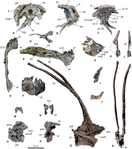
Bajadasaurus is a genus of sauropod dinosaur from the Early Cretaceous epoch, between 145 and 132.9 million years ago, of northern Patagonia, Argentina. It was first described in 2019 based on a single specimen found in 2010 that includes a largely complete skull and parts of the neck. The only species is Bajadasaurus pronuspinax. The genus is classified as a member of the Dicraeosauridae, a group of relatively small and short-necked sauropods. Bajadasaurus sported bifurcated (two-pronged), extremely elongated neural spines extending from the neck; the 2019 description of Bajadasaurus suggested that they could have served as passive defense against predators. The skull was slender and equipped with around 48 teeth that were pencil-shaped and restricted to the front of the jaws. Its eye openings were exposed in top view, possibly allowing the animal to look forwards while feeding. It shared its environment with other dinosaurs including the sauropod Leinkupal and different theropods. (Full article...)
1,015 characters, including spaces.
Huaynaputina
![]()
Huaynaputina (pictured) is a volcano in southern Peru. Lying in the Central Volcanic Zone of the Andes, it was formed by the subduction of the oceanic Nazca Plate under the continental South American Plate. Huaynaputina is a large volcanic crater within an amphitheatre-shaped structure. During the last 11,700 years, the Holocene, Huaynaputina has erupted several times, including on 19 February 1600 – the largest eruption ever recorded in South America. This killed at least 1,000 people and buried the surrounding area under 2 metres (7 ft) of volcanic rock. The eruption caused cold temperatures to hit parts of Europe, Asia and the Americas, and may have played a role in the onset of the Little Ice Age. The volcano has not erupted since 1600. The Peruvian Geophysical Institute announced in 2017 that Huaynaputina would be monitored by the Southern Volcanological Observatory, and seismic observation began in 2019. (Full article...)
941 characters, including spaces.
Arsenal Women 11–1 Bristol City Women
![]()

Arsenal Women and Bristol City Women played an association football match on 1 December 2019. It was part of the 2019–20 Football Association Women's Super League (FA WSL) and became the highest-scoring game in the league's history. Arsenal were the reigning champions and entered the match third in the league. Bristol City were in tenth position, having not won a game in the season. Dutch international striker Vivianne Miedema scored six of the eleven Arsenal goals, a league record. With her goal tally, she surpassed South Korean Ji So-yun to become the highest-scoring non-British player in FA WSL history. The other Arsenal scorers were Lisa Evans (twice), Leah Williamson, Jordan Nobbs, and Emma Mitchell. Yana Daniëls scored the only goal for Bristol City. The result put Arsenal top of the league and left Bristol City in eleventh place out of twelve clubs. The return match was never played, as the season was suspended because of the COVID-19 pandemic. (Full article...)
983 characters, including spaces.
Battle of Saint-Malo
![]()
The Battle of Saint-Malo was fought between Allied and German forces to control the French coastal town and port of Saint-Malo during World War II. Saint-Malo was designated as a fortress under the German Atlantic Wall program, and possessed strong defenses. The Allies sought to capture the town so that its port could be used to land supplies. After initial attempts to capture it on 4 August failed, the United States Army began a siege operation. US units, with the support of Free French and British forces, assaulted the town. Infantry units attacked and defeated large numbers of fortified German positions with the support of artillery and aircraft. A fortification on the edge of Saint-Malo was the final German position on the mainland to hold out, surrendering on 17 August. After extensive air and naval bombardments, the garrison on the nearby island of Cézembre surrendered on 2 September. The town was heavily damaged during the battle and was rebuilt after the war. (Full article...)
999 characters, including spaces.
Battle of Blenheim
![]()
The Battle of Blenheim was fought during the War of the Spanish Succession on 13 August, 1704. The French were seeking to knock Austria out of the war by seizing its capital, Vienna. A coalition army, led by the Duke of Marlborough, marched south from the Dutch Republic to the Danube. There he defeated the Bavarians at the Battle of Donauwörth and joined an Austrian army under Prince Eugene. A French army under Marshall Tallard bolstered the Elector of Bavaria's forces. The opposing armies met on the banks of the Danube near the village of Blindheim. Marlborough unexpectedly attacked the slightly larger Franco-Bavarian army and after a hard day's fighting inflicted a crushing defeat. France suffered over 30,000 casualties, Tallard was taken prisoner and Bavaria was knocked out of the war. Before the campaign ended, the Allies had taken several important towns and were preparing to invade France in 1705. (Full article...)
934 characters, including spaces.
Deutschland-class battleship
![]()
The Deutschland class was a group of five battleships built for the German Imperial Navy. The class comprised Deutschland, Hannover, Pommern, Schlesien, and Schleswig-Holstein. They were completed after the launch of the British all-big-gun battleship HMS Dreadnought in 1906, meaning they were obsolescent before entering service. During World War I, all five ships saw action at the Battle of Jutland in 1916, despite their inferiority to British battleships. In a confused night action, Pommern was torpedoed and sunk by a British destroyer. The four surviving ships were then removed from front-line service and used for coastal defense. After Germany's defeat, they were retained in service. Deutschland was broken up in 1920–1922, but the others were modernized in the mid-1920s. Hannover was decommissioned in 1931, while Schlesien and Schleswig-Holstein both saw limited duty during World War II and were both sunk near the end of the war. (This article is part of a featured topic: Battleships of Germany.)
1,015 characters, including spaces.
Lancaster's Normandy chevauchée of 1356
![]()
Lancaster's chevauchée of 1356 in Normandy was an English offensive directed by Henry, Earl of Lancaster, as a part of the Hundred Years' War. The offensive took the form of a chevauchée, a large-scale mounted raid, and lasted from 22 June to 13 July 1356. Lancaster landed in the Cotentin and pillaged and burnt his way eastward across the Duchy of Normandy with 2,300 men. John II of France moved to Rouen with a much stronger force to intercept Lancaster, but after relieving and re-victualling the besieged citadel of Pont-Audemer the English turned south. They resupplied another friendly fortification, Breteuil, then stormed and sacked the important town of Verneuil-sur-Avre before retreating. John pursued, but bungled several opportunities to bring the English to battle. In 22 days the English travelled 330 mi (530 km), a remarkable effort for the period. The expedition seized a large amount of loot, damage was inflicted on the French economy and prestige, and new alliances were cemented. (Full article...)
1,021 characters, including spaces
Weardale campaign
![]()
![]()
The Weardale campaign, part of the First War of Scottish Independence, occurred during July and August 1327 in Weardale, England. A Scottish force under Lord Douglas and the earls of Moray and Mar faced an English army commanded by Roger Mortimer, 3rd Baron Mortimer, accompanied by the newly crowned Edward III. In 1326 the English King was deposed by his wife, Isabella, and her lover, Mortimer. The Scots had been at war with England for 30 years and took advantage of the situation to raid England. Isabella and Mortimer set off to oppose the Scots in July 1327. Two weeks later, the Scots, who had occupied a strong position, revealed their location to the English. Neither side offered battle, and the Scots moved to a stronger position three days later. The English pursued, but were surprised by a Scottish raid. The Scots escaped back to Scotland on 6 August. For Isabella and Mortimer, the campaign was ruinously expensive and they were forced to sign a treaty recognising Scottish sovereignty. (Full article...)
1,022 characters, including spaces.
Red panda
The red panda is a mammal native to the eastern Himalayas and southwestern China. It has dense reddish-brown fur with a black belly and legs, and a ringed tail. Its head-to-body length is 51-63.5 cm with a 28-48.5 cm tail, and it weighs between 3.2 and 15 kg. Modern genetic evidence places it in close affinity with raccoons, weasels and skunks. The red panda inhabits coniferous, temperate broadleaf and mixed forests, favouring steep slopes with dense bamboo cover close to water. It is solitary, largely arboreal, is well adapted to climbing and possesses elongated wrist bones or "false thumbs" used for grasping bamboo. It feeds mainly on bamboo shoots and leaves. Red pandas mate in early spring, giving birth to litters of up to four cubs in summer. It is threatened by poaching, and habitat destruction and fragmentation due to deforestation. The species has been listed as endangered since 2015. It is featured in animated movies, video games, comic books and as the namesake of companies and music bands. (Full article...)
1,033 characters, including spaces.
1838 Jesuit slave sale
On June 19, 1838, the Maryland Province of the Society of Jesus agreed to sell 272 slaves to two Louisiana planters for $115,000. This was the culmination of a long-running Jesuit debate over whether to keep, sell, or manumit their slaves. In 1836, the Jesuit Superior General, Jan Roothaan, authorized the sale on three conditions: the slaves must be permitted to practice their Catholic faith, their families must not be separated, and the proceeds of the sale must be used only to support Jesuits in training. It soon became clear that the conditions had not been met; families were separated and most of the slaves were not permitted to carry on their faith. The Jesuits never received the full $115,000 and much of what they did was paid many years late. Only 206 of the 272 slaves were actually delivered. The sale prompted an outcry from Jesuits. Roothaan removed the provincial superior for disobeying orders and promoting scandal, exiling him to Nice for several years. (Full article...)
996 characters, including spaces.
Sjafruddin Prawiranegara
Sjafruddin Prawiranegara was an Indonesian statesman and economist. He became active in politics after his education in law and in 1940 joined the Indonesian nationalist movement during the Japanese occupation of 1942-1945. He was appointed finance minister in the republican government during the Indonesian National Revolution of 1945–1949. In December 1948, the Indonesian revolutionary leaders were captured and for seven months Sjafruddin was head of the government. With independence he was first appointed deputy prime minister, then reappointed as finance minister until 1951. A pragmatic policymaker, he espoused religious socialism based on a liberal interpretation of Islam; he was a staunch opponent of communism. His opposition to the government's Guided Democracy resulted in his leading three years of guerilla warfare, which ended with Sjafruddin's surrender in 1961. Imprisoned until 1966, he became a vocal critic of the Indonesian government until his death in 1989. (Full article...)
1,004 characters, including spaces.
1987 FA Cup Final
The 1987 FA Cup Final was an association football match between Coventry City and Tottenham Hotspur on 16 May 1987 at Wembley Stadium in London to determine the winner of the 1986–87 FA Cup. Neil Midgley refereed the match in front of a crowd of 96,000. Two minutes after kick-off, Tottenham took the lead with a headed goal by Clive Allen. The scores were level seven minutes later when Dave Bennett scored for Coventry. Five minutes before half-time a free kick was touched on by Gary Mabbutt to again give Tottenham the lead. Keith Houchen equalised for Coventry with a diving header, the only goal of the second half; this was later selected as the BBC Goal of the Season. During extra time a cross from a Coventry player looped off the left knee of Tottenham's Gary Mabbutt for an own goal resulting in a final score of 3–2 to Coventry. BBC commentator John Motson called the match "the finest Cup Final I've had the pleasure of commentating on". (Full article...)
969 characters, including spaces.
Pyramid of Sahure
The Pyramid of Sahure is a pyramid complex built in the late-26th-to-25th century BC for the Egyptian pharaoh Sahure of the Fifth Dynasty. The main pyramid was built from roughly hewn limestone blocks bound with mud mortar and encased with fine white Tura limestone. Stone fragments believed to belong to the king's basalt sarcophagus are the only remains of the burial that have been found. A mortuary temple is adjacent to the pyramid's east face and to the south is a cult pyramid, constructed similarly to the main pyramid but on a reduced scale. The layout of the complex was adopted by succeeding kings of the Fifth and Sixth Dynasties, marking a milestone in pyramid complex construction. Sahure's mortuary temple became the object of a cult of Sekhmet around the Eighteenth Dynasty. The cult was active through to the Ptolemaic Kingdom. Sahure's temple became the site of a Coptic shrine. The site was first thoroughly excavated by Ludwig Borchardt between March 1907 and 1908. (Full article...)
1,003 characters, including spaces.
Nizar ibn al-Mustansir
Abu Mansur Nizar ibn al-Mustanṣir (1045–1095) was a Fatimid prince, and the oldest son of the eighth Fatimid caliph and Isma'ili imam, al-Mustansir. When al-Mustansir died in December 1094, the powerful vizier, al-Afdal Shahanshah, raised Nizar's younger brother al-Musta'li to the throne in Cairo, bypassing the claims of Nizar and other older sons of al-Mustansir. Nizar escaped, rebelled and seized Alexandria, where he reigned as caliph with the regnal name al-Mustafa li-Din Allah. In late 1095 he was defeated, taken prisoner and executed by immurement. Many Isma'ilis, especially in Persia, rejected al-Musta'li and considered Nizar to have been the rightful imam. As a result, they split off from the Fatimid regime and founded the Nizari branch of Isma'ilism, with their own line of imams who claimed descent from Nizar. This line continues to this day in the person of the Aga Khan. During the 12th century, some of Nizar's actual or claimed descendants tried, without success, to seize the throne from the Fatimid caliphs. (Full article...)
1,051 characters, including spaces.
Dispute between Darnhall and Vale Royal Abbey
The dispute between Darnhall and Vale Royal Abbey arose in the early fourteenth century. Tensions between villagers from Darnhall and Over, Cheshire and their feudal lord, Abbot Peter of Vale Royal Abbey, erupted into violence over whether they had villein—servile—status. The villagers' efforts to reject the Abbey's feudal overlordship included appeals to the Abbot, the King's Chief Justice in Cheshire and even to the King and Queen. On each occasion the villagers were unsuccessful, frequently suffering imprisonment when their appeals failed, and they were also often fined. On one occasion the villagers of Darnhall and Over followed Peter to Rutland; an affray broke out, the Abbot's groom was killed, and Peter and his entourage were captured. The King intervened and released him; the Abbot then had the villagers imprisoned again. Nothing is known of any resolution to the dispute, but serfdom was in decline nationally and Peter's successor may have had other priorities. (Full article...)
1,001 characters, including spaces.
Saline Valley salt tram
The Saline Valley salt tram is located in Inyo County, California. The electric aerial tramway was constructed from 1911 to 1913 to carry salt from the Saline Valley, over the Inyo Mountains, and into the Owens Valley. Covering a distance of 13.4 miles (21.6 km), it operated sporadically from 1913 to 1935 for four different companies. The tram was built for the Saline Valley Salt Company (SVSC) by the Trenton Iron Company, but the costs of its construction and operation were ruinously expensive for the SVSC. The salt mining operation and tram were leased in 1915 to the Owens Valley Salt Company until it went bankrupt in 1918. In 1920, the tram was taken over by the Trenton Iron Company, which sold it to the Sierra Salt Company in 1928. The Sierra Salt Company put it back into service until the company went bankrupt in 1935. During its operation, it was the steepest tram in the United States. The tram was included in the National Register of Historic Places on December 31, 1974. (Full article...)
1,010 characters, including spaces.
Momčilo Đujić
Momčilo Đujić 27 February 1907 – 11 September 1999) was a Serbian Orthodox priest and Chetnik warlord who led a force of the Chetniks within the Independent State of Croatia (NDH), a fascist puppet state in Yugoslavia during World War II. Đujić was ordained as a priest in 1933 and was active in promoting workers' rights. After the Axis invasion of Yugoslavia in April 1941, he led a group of Chetniks in defending local Serbs from the Croatian Ustaše regime. He then |collaborated with the Italians, subverting communist-led Partisan units, and attacking them alongside the Italians. He formed the Chetnik Dinara Division in early 1942. In November 1944, Đujić and 4,500 of his Chetniks combined with German and NDH forces in an attempt to defend Knin from the ascendant Partisans. Đujić was tried and convicted in absentia of multiple war crimes by the new Yugoslav communist government, including being responsible for 1,500 deaths. He emigrated to the United States, where he died aged 92. (Full article...)
1,012 characters, including spaces.
Not used
William IV
![]()
William IV (William Henry; 21 August 1765 – 20 June 1837) was King of the United Kingdom of Great Britain and Ireland and King of Hanover from 26 June 1830 until his death in 1837. The third son of George III, William succeeded his elder brother George IV, becoming the last king and penultimate monarch of Britain's House of Hanover. As his two older brothers died without leaving legitimate issue, he inherited the throne when he was 64 years old. William had served in the Royal Navy in his youth and so was nicknamed the "Sailor King". His reign saw several reforms: the poor law was updated, child labour restricted, slavery abolished in nearly all of the British Empire, and the British electoral system refashioned by the Reform Act 1832. He granted his German kingdom a short-lived liberal constitution. At the time of his death, William had no surviving legitimate children and was succeeded by his niece Victoria in the United Kingdom and his brother Ernest Augustus in Hanover. (Full article...)
1,006 characters, including spaces.
Killing of Muhammad al-Durrah
The killing of Muhammad al-Durrah took place in the Gaza Strip on 30 September 2000, during widespread protests and riots in the Palestinian territories against Israel's military occupation. Jamal al-Durrah and his 12-year-old son, Muhammad, were filmed by Talal Abu Rahma, a Palestinian cameraman freelancing for France 2, as they were caught in crossfire between the Israeli military and Palestinian security forces. Muhammad is shown slumping as he is mortally wounded by gunfire, dying soon after.
The Israel Defense Forces accepted responsibility for the shooting at first but later retracted. Critics have since questioned the accuracy of France 2's footage. Journalists who saw the raw footage said that France 2 had cut a final few seconds in which Muhammad appeared to lift his hand from his face; they acknowledged that Muhammad had died, but said the footage alone did not show it. France 2's news editor said in 2005 that no one could be sure who fired the shots. Other commentators, particularly Philippe Karsenty, a French media commentator, went further, alleging that the scene had been staged by France 2; France 2 sued him for libel and in 2013 he was fined €7,000 by the Court of Appeal of Paris. In May that year an Israeli government report supported Karsenty's view. Jamal al-Durrah and Charles Enderlin rejected its conclusion and called for an independent international investigation.
The footage of the father and son acquired what one writer called the power of a battle flag. Postage stamps in the Middle East carried the images. Abu Rahma's coverage of the al-Durrah shooting brought him several journalism awards, including the Rory Peck Award in 2001. (Full article...)
characters, including spaces.
Abberton Reservoir
![]()
Abberton Reservoir is a pumped storage freshwater reservoir in eastern England near the Essex coast, with an area of 700 hectares (1,700 acres). Most of its water is pumped in from the River Stour, and it is the largest body of freshwater in its county. Constructed between 1935 and 1939, it is currently owned and managed by Essex and Suffolk Water, part of Northumbrian Water Group, and lies 6 km (3.7 mi) south-west of Colchester near the village of Layer de la Haye. The reservoir is important for its breeding cormorants, wintering and moulting waterfowl, and migrating birds. It is an internationally important wetland, designated as a Ramsar site, Site of Special Scientific Interest and Special Protection Area, and it is listed in A Nature Conservation Review. A small part of the site is managed by the Essex Wildlife Trust. In World War II, the reservoir was mined to deter invading seaplanes, and it was used for practice runs for the bombing of German dams in the Ruhr. (Full article...)
1,002 characters, including spaces.
Beaver
![]()

Beavers are large, semiaquatic rodents in the genus Castor native to the temperate Northern Hemisphere. There are two extant species: the North American (Castor canadensis) and the Eurasian beaver (C. fiber). They have stout bodies with large heads, long chisel-like incisors, brown or gray fur, hand-like front feet, webbed back feet and flat, scaly tails. The animals can be found in a number of freshwater habitats and are herbivorous, consuming tree bark, aquatic plants, grasses and sedges. Beavers build dams and lodges, chewing down trees for building material. Their infrastructure creates wetlands used by many other species, and they are considered a keystone species. Beavers hold territories and mark using mounts scented with castoreum. Historically, beavers have been hunted for their fur, meat and castoreum, and overhunting nearly exterminated both species; their populations have since rebounded. In human culture, the beaver symbolizes industriousness and is the List of national animals of Canada.(Full article...)
1,025 characters, including spaces.
Bombing of Yawata
![]()

Three major air raids were carried out against the Japanese city of Yawata during World War II, part of the U.S. strategic bombing campaign. The first raid took place on the night of 15/16 June 1944. This was the first attack on the Japanese home islands by United States Army Air Forces bombers since the Doolittle Raid of 1942. The city was next attacked during the day and night of 20 August 1944. These two attacks caused little damage to the city's industrial facilities. The third raid was conducted on 8 August 1945 and resulted in 21 percent of Yahata's urban area being destroyed. The third raid may have spared nearby Kokura from destruction, as Kokura was to be the primary target for the second atomic bomb the following day, but smoke from the fires in Yahata combined with cloud cover decreased visibility to the point that the secondary target of Nagasaki was bombed instead. Yahata was incorporated into the larger city of Kitakyushu in 1963. (Full article...)
976 characters, including spaces.
Menstrual cycle
![]()
The menstrual cycle is a series of natural changes in hormone production and the structures of the uterus and ovaries of the female reproductive system that make pregnancy possible. The ovarian cycle controls the production and release of eggs and the cyclic release of estrogen and progesterone. The uterine cycle governs the preparation of the lining of the uterus (womb) to receive a fertilized egg. These cycles normally last between 21 and 35 days in adult women, with a median of 28 days, and usually continue for 30–45 years. Day one of the menstrual cycle is the first day of the period, which lasts for about five days. Around day fourteen, the egg is released from the ovary. Menarche (the onset of the first period) usually occurs at about age twelve. Although generally health-producing, some women experience problems including cramps, tender breasts, tiredness, and premenstrual syndrome. More severe problems such as premenstrual dysphoric disorder are experienced by 3 to 8% of women. (Full article...)
1,018 characters, including spaces
Juan Davis Bradburn
{{TFAIMAGE| Juan Davis Bradburn (1787 – April 20, 1842), born John Davis Bradburn, was a brigadier general in the Mexican Army. His actions as commandant of the garrison at Anahuac in Mexican Texas in 1831 and 1832 led to the events known as the Anahuac Disturbances.
Born and raised in the United States, Bradburn's first career was as a merchant and slave trader. He likely first entered Mexico in 1812 as part of the Gutiérrez-Magee Expedition fighting Spanish control of Texas.[Note 1] When the expedition was quashed, Bradburn moved to Louisiana, where he served in the Louisiana militia during the Battle of New Orleans. After his discharge, Bradburn spent several years fighting for Mexican independence. After Spain relinquished its hold on Mexico in 1821, Bradburn became an officer in the new Mexican Army, in which he served as a courier for Mexican emperor Agustín de Iturbide.
In 1830, Bradburn established a new military and customs post, Anahuac, in Texas. The local settlers resented Bradburn's efforts to withhold land titles from those who had squatted in unauthorized areas. They were further angered by his attempts to enforce customs laws which had been largely ignored. The hard feelings escalated when Bradburn, following Mexican law, refused to return runaway slaves to their owners in the United States. After receiving a hoax letter claiming that armed men were marching on Anahuac to retrieve runaway slaves, Bradburn arrested local lawyers William B. Travis and Patrick Churchill Jack. Settlers were outraged that Travis did not receive some of the protections offered by the United States Bill of Rights, even though these rights were not guaranteed in Mexico. A large force of Texians marched on Anahuac to secure Travis's release. The resulting confrontation forced Bradburn's expulsion from Texas and encouraged other immigrants to take armed action against Mexican soldiers. As a result of his actions, Bradburn was "one of the most maligned men in historical accounts of" Texas in the 19th century. (Full article...)
characters, including spaces.
Russian battleship Peresvet
Peresvet (Russian: Пересвет) was the lead ship of the three Peresvet-class pre-dreadnought battleships built for the Imperial Russian Navy at the end of the nineteenth century. The ship was transferred to the Pacific Squadron upon completion and based at Port Arthur from 1903. During the Russo-Japanese War of 1904–05, she participated in the Battle of Port Arthur and was seriously damaged during the Battle of the Yellow Sea and again in the Siege of Port Arthur. The ship was scuttled before the Russians surrendered, then salvaged by the Japanese and placed into service with the name Sagami (相模).
Partially rearmed, Sagami was reclassified by the Imperial Japanese Navy (IJN) as a coastal defense ship in 1912. In 1916, the Japanese sold her to the Russians, their allies since the beginning of World War I. En route to the White Sea in early 1917, she sank off Port Said, Egypt, after striking mines laid by a German submarine. (This article is part of a featured topic: Battleships of Japan.)Jump to search
characters, including spaces.
FAC archived
London and North Western Railway War Memorial
![]()
The London and North Western Railway War Memorial is a First World War memorial outside Euston railway station in London, England. The memorial was designed by Reginald Wynn Owen and commemorates employees of the London and North Western Railway (LNWR) who were killed in the First World War. Over 37,000 employees of the LNWR fought in the war, of whom 3,719 were killed. The memorial cost £12,500 and consists of a single 13-metre (43-foot) tall obelisk on a pedestal. At the top, on each side, is a cross in relief and a bronze wreath. At each corner of the base is an over-life-size statue of a military figure—an artilleryman, an infantryman, a sailor, and an airman. Field Marshal Earl Haig unveiled the memorial on 21 October 1921, accompanied by the Archbishop of Canterbury with over 8,000 people attending. The memorial and two entrance lodges are all that remain of the former Euston station complex, as it was rebuilt in the 1960s. The memorial is a grade II* listed building. (Full article...)
1,006 characters, including spaces.
2nd Armoured Division (United Kingdom)
The 2nd Armoured Division was a formation of the British Army, active during the early stages of the World War II. It was formed in December 1939 but only received priority for equipment in July 1940. In October, the division was transferred to Egypt, as reinforcements for Middle East Command. Before leaving it swapped a brigade with the 1st Armoured Division, reducing the division from four to three armoured regiments. The 2nd Division arrived in Egypt in December 1940 and was stripped to support Operation Lustre, an expeditionary force to Greece. The rest of the division moved to Cyrenaica in Italian Libya, conquered during Operation Compass. Its remaining tanks were worn-out and were supplemented by equally decrepit Italian models. In March, a German-Italian counter-attack led to the destruction of the division, and the ejection of the British from Cyrenaica except for those in Tobruk. The consensus of historians is there was little the division could have done to stop this. (Full article...)
1,011 characters, including spaces
Manuel Noriega
Manuel Noriega (February 11, 1934 – May 29, 2017) was a Panamanian politician and military officer. Born in Panama City to a poor mestizo family, Noriega became an officer in the Panamanian army, and rose through the rank. In 1968, he became chief of military intelligence and from 1981, consolidated power to become de facto ruler of Panama. Noriega was one of the Central Intelligence Agency's most valued intelligence sources, and one of the primary conduits for illicit weapons, military equipment, and cash destined for U.S.-backed forces throughout Latin America. The U.S. regarded Noriega as an ally in its War on Drugs, despite Noriega having amassed a personal fortune through drug trafficking operations. Following the 1989 United States invasion of Panama, he was captured and flown to the United States, where he was tried on charges of racketeering, drug smuggling, and money laundering He was sentenced to 40 years in prison and served 17; extradited to France in 2010 and sentenced to 7 years imprisonment; and returned to Panama in 2011, where he was incarcerated for crimes committed during his rule. Diagnosed with a brain tumor in March 2017, Noriega suffered complications during surgery, and died two months later. (Full article...)
1,253 characters, including spaces
Leyla Express and Johnny Express incidents
In December 1971, the freighters Leyla Express and Johnny Express were seized by Cuban gunboats. The Leyla Express was stopped off the Cuban coast on December 5; the Johnny Express was intercepted in the Bahamas ten days later. Some of the crew of the Johnny Express were injured when the gunboats fired on their vessel. Cuba stated that both vessels were being used by the United States Central Intelligence Agency (CIA) to transport weapons, explosives, and personnel to Cuba, and described the vessels as being engaged in piracy. The US government and the ships' ownerss denied the accusations. Cuba released the crew of both ships, but announced that the captain of the Johnny Express would face trial. The Panamanian government negotiated Villa's release into Panamanian custody. A Panamanian mission which investigated the incident concluded, based on the ships' logs, that the vessels had in fact brought insurgent forces to Cuban territory, and that the Cuban government's accusations were accurate. (Full article...)
characters, including spaces
Pepi I Meryre
![]()
Pepi I Meryre was the third king of the Sixth Dynasty of Egypt, ruling for c. 50 years during the second half of the 24th century BC. Pepi was the son of his second predecessor Teti, had at least six queens, and was succeeded by son Merenre Nemtyemsaf I. Confronted with the decline of the pharaoh's power at the expense of local officials, Pepi reacted with a vast architectural program involving the construction of numerous temples and chapels throughout Egypt, reinforcing his presence in the provinces. Egypt's prosperity allowed Pepi to become the most prolific builder of the Old Kingdom period. His external policy included military campaigns against Nubia, the Sinai and the southern Levant. Trade with Byblos, Ebla and the oases of the western desert flourished while Pepi launched mining and quarrying expeditions to Sinai and further afield. Pepi had a pyramid complex built for his funerary cult in Saqqara next to which he built at least a further six pyramids for his queens. (Full article...)
1,008 characters, including spaces
McDonnell Douglas Phantom in UK service
![]()
![]()
The United Kingdom operated the McDonnell Douglas F-4 Phantom II as one of its principal combat aircraft from the 1960s to the early 1990s. The UK was the first export customer for the Phantom, which was procured to serve in both the Fleet Air Arm and Royal Air Force in several roles including air defence, close air support, low-level strike and tactical reconnaissance. Two variants were initially built for the UK: the F-4K variant was designed from the outset as an air defence interceptor to be operated from the Royal Navy's aircraft carriers; the F-4M version was procured for the RAF to serve in the tactical strike and reconnaissance roles. The Phantom entered service with both the Fleet Air Arm and the RAF in 1969. By the mid-1970s it had become the UK's principal interceptor, a role in which it continued until the early 1990s. In the mid-1980s, second-hand F-4J aircraft were purchased to augment the UK's air defences following the Falklands War. (Full article...)
994 characters, including spaces
Cite error: There are <ref group=Note> tags on this page, but the references will not show without a {{reflist|group=Note}} template (see the help page).







